Matric Q&A




























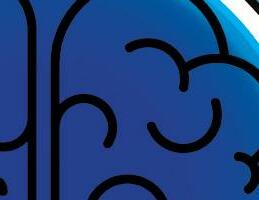





































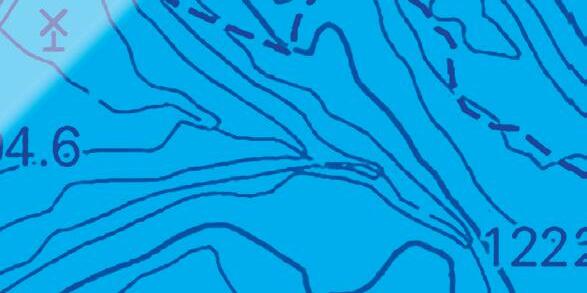



























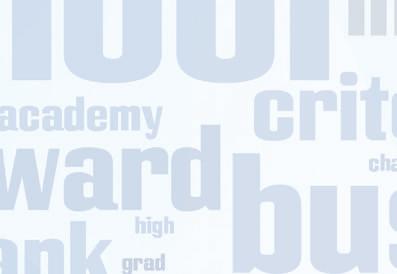









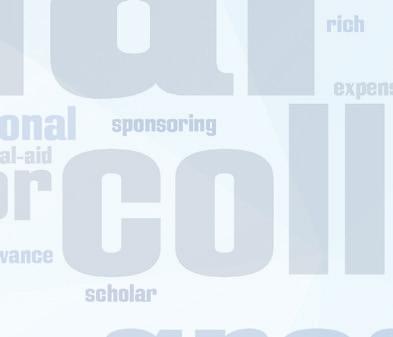


GEOGRAPHY and HISTORY Grade 12 National Senior Certificate EDITION 5 SHARE ME Pass this EXAMINATION GUIDE on to your friend in MATRIC
A PROUD BRAND OF
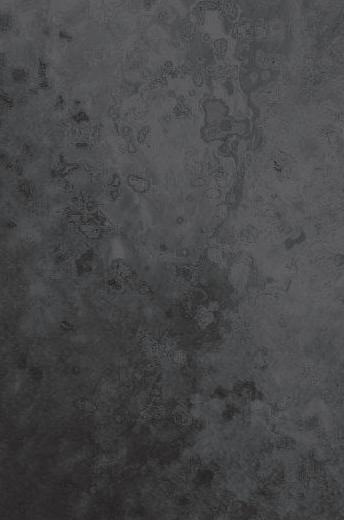


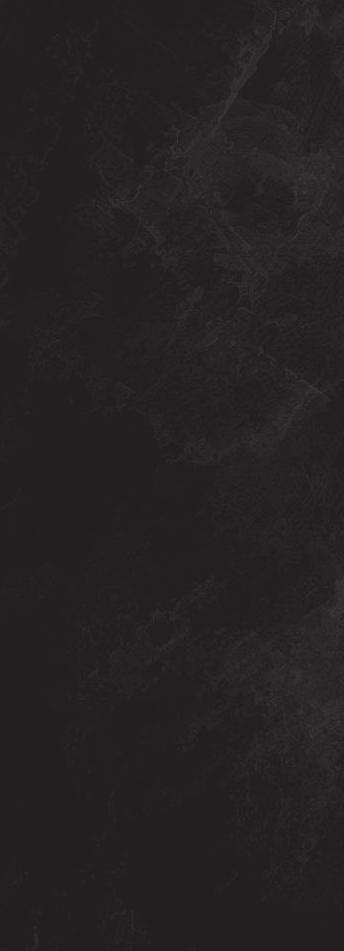
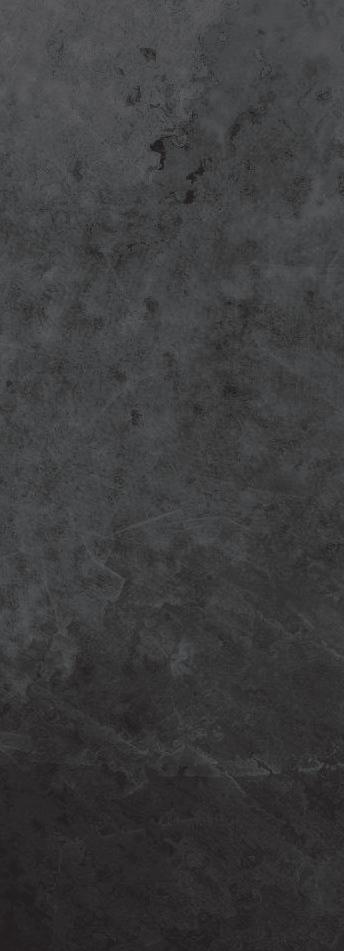
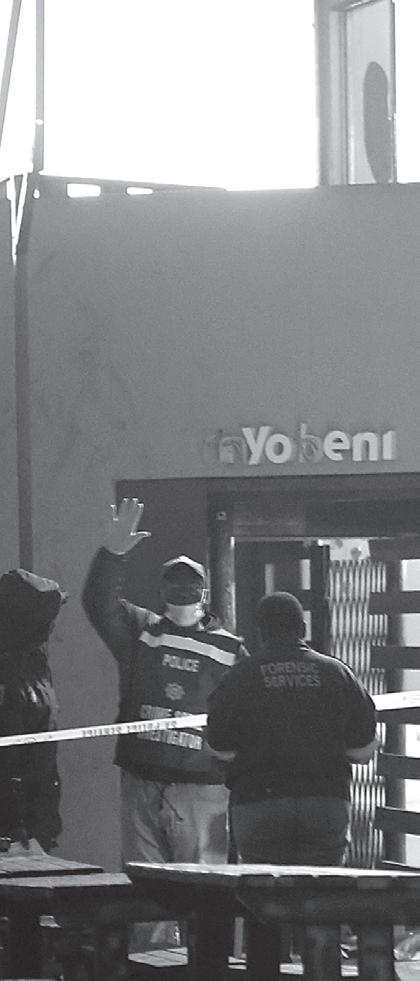

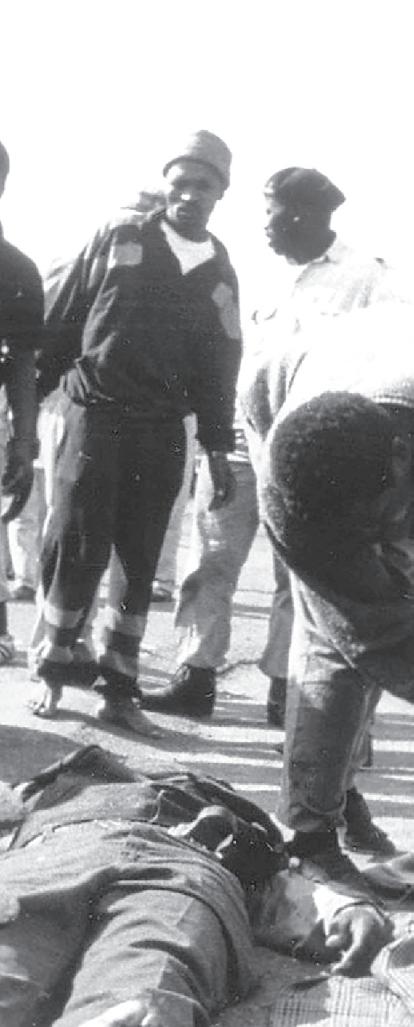


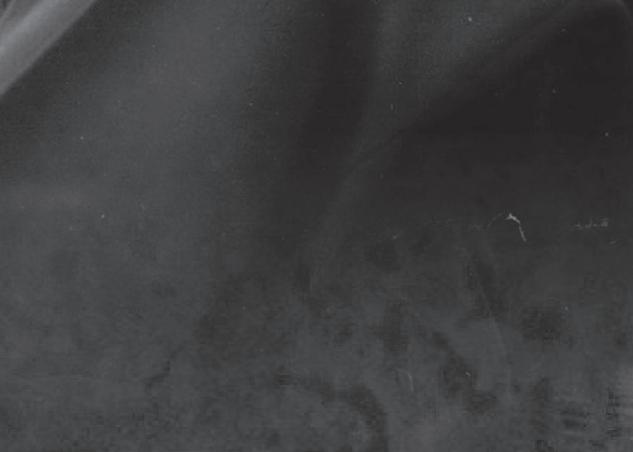



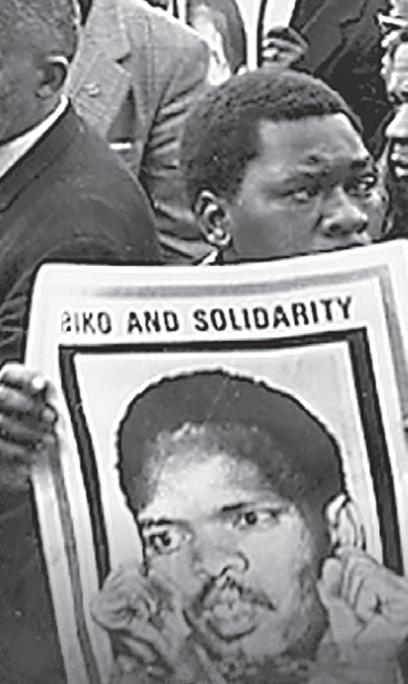





 By Leival Brandon Richards
By Leival Brandon Richards
What is true education? Good teachers, good students, or good content? Of the three, the burden is on the student because the student suffers the consequence of false education. There is only one essential activity for a student: to relate the facts into a unified and organic whole. Assimilate them as the rose incorporates food from the soil and increases in size, vitality and beauty. It is a free activity and good use of time. It will benefit the individual, their friends, family, community and country. For the past 14 weeks, I read a book a week, hoping that I could say that I now have a true education.
Something unexpected happened.
I'm a university lecturer in ancient Near Eastern studies. I have the appropriate qualifications. And I get the right amount of satisfaction from teaching and learning in my field. But what always surprises me, for better or worse, is how much other people know. Some people use the language of football, some the language of religion, but most talk past each other. There is no equality in this category.
Everything a person knows is in their person. Like the rose assimilating sun, soil and water, copy, content, and information became the person and motivated their actions. I expected that I should prefer to embody all the best ideas ever. So the obvious question was: What information was I consuming, and what am I becoming?
I started in my field of expertise. Which coincidentally contains the world’s oldest recorded story, the Mesopotamian Epic of Gilgamesh. I then read the ancient Egyptian Tale of Two Brothers. The logical next option was the Hebraic tradition. I had already done a cover to cover reading the Bible, so I read the full English version of the Quran. Next, I went to the Hellenic tradition of Homer, Plato and Aristotle. I continued through religion, history and philosophy, covering the West African Sunjata and Indian Ramayana. Back in Western culture, I am currently on Freud and the Catechism of the Catholic Church. It’s well beyond a book a
week, and something unexpected happened.
Talking and understanding.
I talk significantly less. So much less that my voice sounds unfamiliar with volume and tone when I do. The inverse has occurred with understanding. I listen to people very carefully. I pay attention to each word and term they use and judge whether that’s the correct symbol for an idea. I endeavour to come to terms with people through active listening. Before my endeavour, even as a teacher, I had never imagined that understanding was






Week

idea, premise or bedrock elaborated throughout, if not repeated. Gilgamesh was about our awareness of our finitude. Regardless of who you are and how important you may be, you have only a century at best to be that. The Tale of Two Brothers was about self-abnegation. Regardless of your wealth, taking liberties is a weakness because it means you lack self-restraint. The Greek tradition offered rationality as a tool that serves humanity. Make using it a habit. In the Indian tradition, you have a duty, do it. The Abrahamic doctrines were about faith, hope and charity.
Ultimately, these premises sound like the clichés parents, teachers and elders repeated. But together, they are the elements from which the modern human psyche has organically grown. They are our sun, soil and water. They also gesture at the real problem that humanity has always had. Access to information was never the problem. We are the product of the historical development of these ideas. But have we become roses? The reason for our anxiety, apathy and unpleasantness is our refusal to synthesise the fundamental elements through the exercise of understanding. There is nothing new to learn about the human experience of life. There is only the exercise of the mind.
At the beginning of this year Arena Holdings, in a partnership with Boston College, gave away R2.5m in bursaries to young people in South Africa. They were given the option to study for a Diploma, Degree or Higher Certificate at a Boston College of their choice. Tshegofatsi Kgakatsi chose to study a Diploma in Systems Development at Boston College, Orange Grove, Johannesburg. This is her story.

Why did you apply to win a bursary?







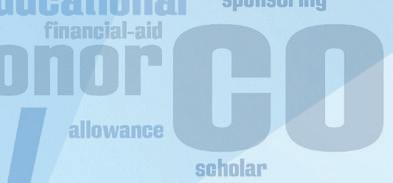


I applied to win this bursary opportunity because I do not have the means to fund my studies and I knew that the bursary will assist me to further my studies and achieve my dream of being a software developer.
Where did you matriculate?


I matriculated at Kgololosego Secondary School in the Free State.
What is your home environment like?
I was born and raised at Dealesville, near Bloemfontein. There is really not much going on at my home town and that is what led me to developing a love for books. As young as seven years old I would visit our public library almost every day. I am grateful to have grown up in such a small town even if there are few opportunities because it fuelled me to dream big.
Why did you choose Media Studies?
I chose system development studies because I want to be part of the 4th industrial revolution. With the knowledge that I will be gaining from my studies I want to solve real-life problems and contribute positively to society.


something I could practise. I don’t feel like I know any more than I did before. I couldn’t tell you the details of Aristotle’s Nicomachean Ethics without going back to the books or Google. But I am more adept in the discipline of understanding. Reading was the exercise of understanding, as doing heavier bicep curls. Your muscles don’t get bigger, leaner or better looking. They get better at doing that exercise.
To advise this practice, I have to tell you what I understand and why it is good − each book had a basic


I reached this conclusion by going through the reps. There have been many experiments in social organisation, manners, economics and politics. And many mutations of religion. Words are symbols that represent reality. Those symbols carry concepts communicated as terms. We come to terms with each other when the concept expressed is understood. Ideas understood by everyone become universalised. Consider why you don't punch anyone who annoys you. Because if everyone behaved that way, there would be no civil society. So we use words. The concept here is that we do not punch each other. Everyone understands this is a good idea for the individual, their family, friends, community and country. What happens when one person doesn’t understand why that rule should apply to them? Practise the exercise of understanding. It’s good for you.
What has the first six months at college been like for you?
The first six months were awesome − Boston Orange Grove campus staff are very supportive and they took me step by step in adapting to the new learning environment.


What do you like most about the learning environment?

I like the flexibility − I can learn from anywhere and at any time. The lecturers and student advisors are 100% supportive.
Where do you see yourself in three years’ time?
I see myself being a qualified system developer and have developed my own application.



What is the best advice you have been given this year?
The best advice that I was given this year is that, “never under estimate the power putting in a little effort everyday because at the end the ultimate goal will be achieved.”
What advice would you give to a student writing Matric?























Be consistent and keep your mind on the end goal. Put in the work bit by bit every day.
What makes you happy and focused as a student?
What makes me happy as a student is when I pass my modules
and gain the knowledge that I can apply in real-life situations to solve problems and better my life and other people’s lives.

What makes you laugh a lot?
Definitely my grandmother’s jokes! She is a good storyteller and likes to joke a lot.
What do you worry about?
Honestly, I worry about my future as a young person in this country. I am afraid of waking up one day and not being able to put food on the table for my family because of the bad economic
Who is your best role model?
My aunt Margaret Setlhare − she raised me after my mother passed away when I was 14. She is a strong, loving and caring woman. She is a teacher by profession and has a mother’s heart. She understands the importance of not only education but raising a child in a strong family structure. She gave me a home when I had none.
The official papers in this supplement have been published with the endorsement of the Department of Basic Education. For more Matric Questions and Memoranda go to https://www.education.gov.za/
A PROUD BRAND OF 3
Project management: Design and layout: Proof reading: Sales: Patti McDonald (PattiM@arena.africa), Rudy Baker Greg Yen (gregyen999@gmail.com • 083 703 1455) Helen Smith (SmithH@sundaytimes.co.za) Sumeshni Khan (khansu@arena.africa • 079 695 0340) www.boston.ac.za www.bostononline.co.za What Happens When You Read a Book a
Meet a WINNER!



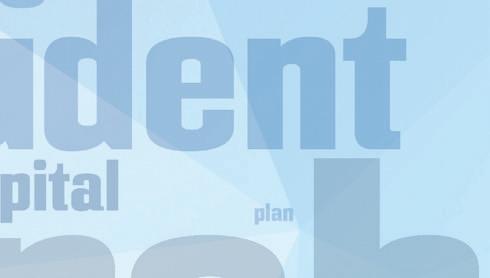












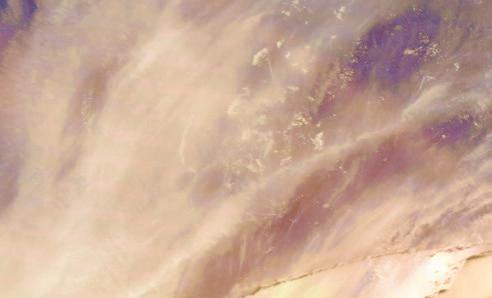

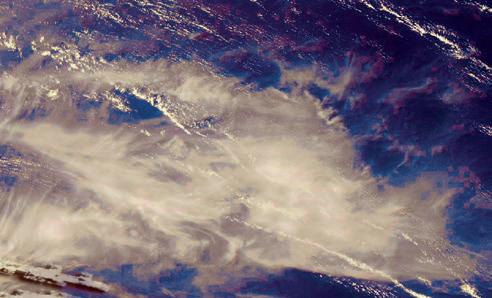
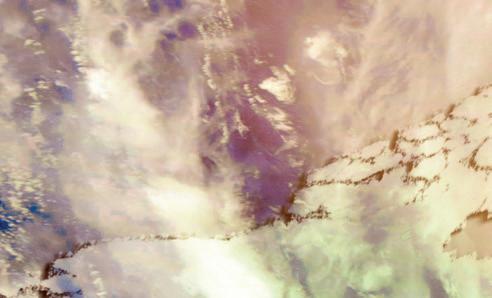





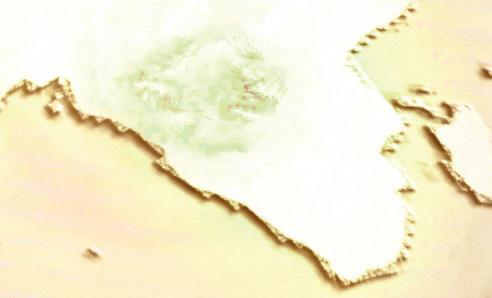
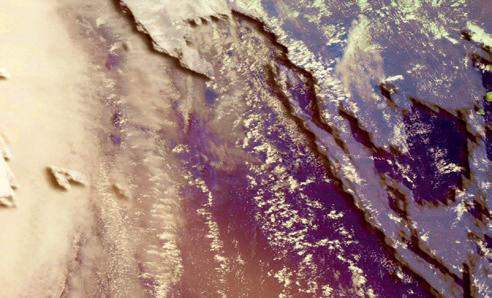



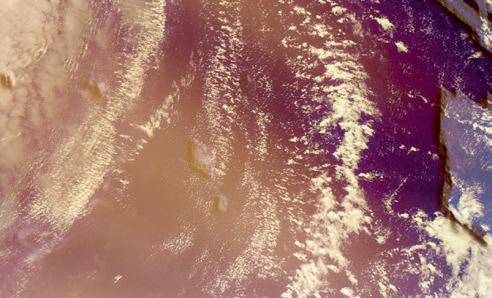





The official papers in this supplement have been published with the endorsement of the Department of Basic Education. For more Matric Questions and Memoranda go to https://www.education.gov.za/ GEOGRAPHYMatric Q&A 4 INSTRUCTIONS AND INFORMATION 1. This question paper consists of FOUR questions. 2. Answer ANY THREE questions of 75 marks each. 3. All diagrams are included in the ANNEXURE. 4. Leave a line between the subsections of questions answered. 5. Start EACH question at the top of a NEW page. 6. Number the answers correctly according to the numbering system used in this question paper. 7. Do NOT write in the margins of the ANSWER BOOK. 8. Draw fully labelled diagrams when instructed to do so. 9. Answer in FULL SENTENCES, except when you have to state, name, identify or list. 10. Indicate the unit of measurement or compass direction when quoting figures or values in your answer, e.g. 45 m, 1 020 hPa, 14 °C and north (N). 11. Use full sentences when answering paragraph-type questions. Paper 1
SECTION A: CLIMATE, WEATHER AND GEOMORPHOLOGY




QUESTION 1
1.1 Refer to FIGURE 1.1 showing air movement associated with valley climates. Match the descriptions below with winds A and B. Write only the letter A or B next to the question numbers (1.1.1 to 1.1.7) in the ANSWER BOOK, e.g. 1.1.8 B.

1.3 FIGURE 1.3 shows a mid-latitude cyclone on a synoptic weather map of Southern Africa.
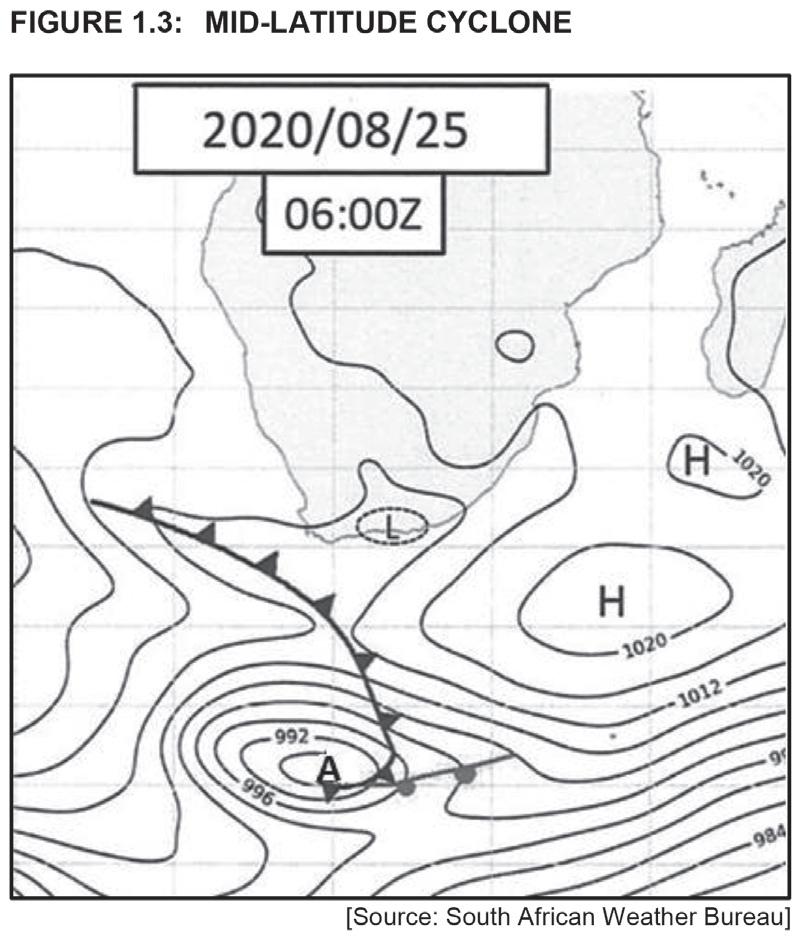
sketch]
1.1.1 The air movement associated with upslope flow.

1.1.2 Air movement that occurs at the night.
1.1.3 Air movement that originates due to the rate of insolation.



1.1.4 Air movement that mostly reduces air pollution at the bottom of the valley.
1.1.5 Air movement associated with dense, heavy air.
1.1.6 Air movement associated with the formation of frost on the valley floor.
1.1.7 The direction of air movement determined by gravitational forces.
(7 x 1)(7)
1.2 Choose a term from COLUMN B that matches the characteristic description in COLUMN A. Write only the letter (A–I) next to the question numbers (1.2.1 to 1.2.8) in the ANSWER BOOK, e.g. 1.2.9 J.
COLUMN A COLUMN B
1.2.1 Drainage pattern that is common along steep slopes of ridge or hills.
1.2.2 Drainage pattern found in areas where glaciers have occurred.
1.2.3 The main stream has right angle bends in this drainage pattern.

1.2.4 Drainage pattern associated with streams that flow towards a central low-lying area.
1.2.5 Drainage pattern associated with a dome feature.
1.2.6 Drainage pattern that originates in areas with alternative layers of hard and soft rock.
1.2.7 Drainage pattern that is usually uniform and tributaries join at acute angles.
1.2.8 The river is younger than the underlying rock structure over which it flows.
A trellis
B dendritic
C radial

D rectangular
E deranged
F antecedent





G centripetal
H superimposed
I parallel (8 x 1)(8)
1.3.1
Give evidence from the diagram that suggests that weather system A is a mid-latitude cyclone. (1 x 1)(1)
1.3.2 Why does this weather system originate at the polar front? (1 x 2) (2)
1.3.3 Give a reason for the direction of movement of this weather system. (1 x 2)(2)



1.3.4 Why is the cold front associated with severe weather conditions? (1 x 2)(2)
1.3.5 Explain the formation of the stage of development shown in FIGURE 1.3 of the mid-latitude cyclone. (4)
1.3.6 Why does the cold front of the mid-latitude cyclone have a positive impact on agricultural activities in the Western Cape? (2 x 2)(4)
1.4 FIGURE 1.4 shows the presence of a line thunderstorm across South Africa.
1.4.1 Does the line thunderstorm obtain its source of moisture from ocean A or B? (1 x 1)(1)
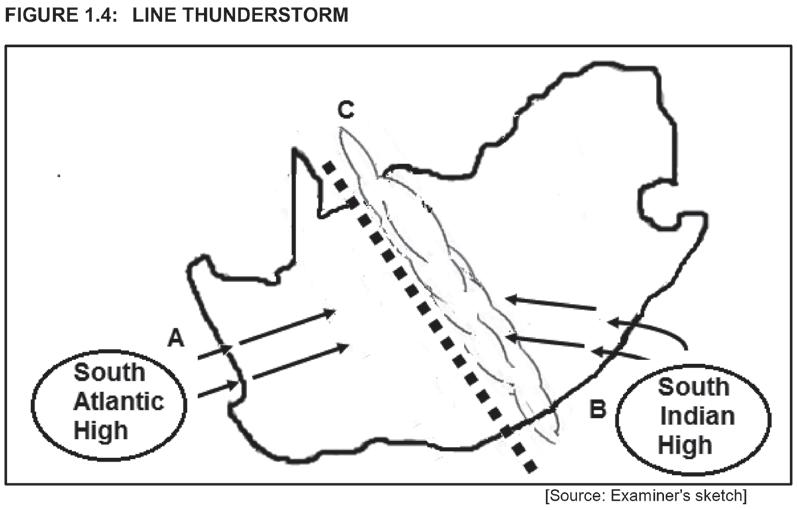
5
The official papers in this supplement have been published with the endorsement of the Department of Basic Education. For more Matric Questions and Memoranda go to https://www.education.gov.za/
A PROUD BRAND OF
[Source: Examiner's
Matric Q&A


GEOGRAPHY
1.4.2 Why is cold, dry air fed in from the South Atlantic High Pressure Cell? (1 x 2)(2)
1.4.3 Explain how the formation of the moisture front at C results in line thunderstorms. (2 x 2)(4)
1.4.4 In a paragraph of approximately EIGHT lines, explain the destructive (harmful) nature of line thunderstorms. (4 x 2)(8)
1.5 FIGURE 1.5 is an extract on deltas.
1.5.1 Where do deltas form? (1 x 1)(1)
1.5.2 What evidence in the extract indicates that deltas are densely populated? (1 x 1)(1)

1.5.3 According to the extract, how are cities disturbing the natural formation of deltas? (1 x 1)(1)
1.5.4 Discuss the importance of protecting deltas. (2 x 2)(4)
1.5.5 A recent environmental impact assessment has highlighted concerns about the future sustainability of deltas. In a paragraph of approximately EIGHT lines, suggest strategies to protect areas like deltas from the negative impact of human activities. (4 x 2)(8)



1.6 Refer to FIGURE 1.6 showing river rejuvenation.
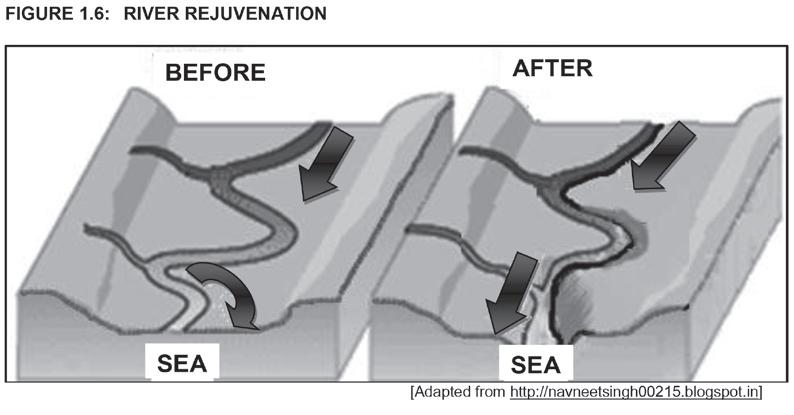
1.6.1 What is river rejuvenation? (1 x 1)(1)
1.6.2 Which stage (course) of the river is illustrated in FIGURE 1.6? (1 x 1)(1)
1.6.3 Give evidence from FIGURE 1.6 to support your answer to QUESTION 1.6.2. (1 x 1)(1)
1.6.4 Why is there an increase in the rate of erosion in the river after rejuvenation? (2 x 2)(4)
1.6.5 Identify the changes to the







QUESTION 2
2.1 Refer to FIGURE 2.1 showing a high pressure and low pressure cell in the Southern Hemisphere. Match the statements below with the high pressure cell or low pressure cell. Write down your answer next to

question numbers (2.1.1 to 2.1.8) in the ANSWER BOOK, e.g. 2.1.9 low-pressure cell.


2.1.1 Associated with rising air.
2.1.2 Air diverges on the surface from this pressure cell.
2.1.3 Associated with the clockwise movement of air.

2.1.4 Unstable weather conditions over the interior.
2.1.5 Associated with ridging.

2.1.6 Associated with heavy rain and hail.
2.1.7 Dominates the land in winter.
2.1.8 Berg wind conditions develop when it interacts with a coastal low. (8 x 1)(8)
2.2 Choose a concept/term from COLUMN B that matches the description in COLUMN A. Write only the letter (A–H) next to the question numbers (2.2.1 to 2.2.7) in the ANSWER BOOK, e.g. 2.2.8 I.
COLUMN A COLUMN B
2.2.1 Area drained by a river and its tributaries. A catchment area
2.2.2 High-lying area that separates two different drainage basins. B interfluve
2.2.3 Starting point of a river. C confluence
2.2.4 Term that describes the main river and its tributaries. D drainage basin
2.2.5 Point where the river enters the sea. E river system
2.2.6 Elevated land that separates streams in the same drainage basin. F watershed
2.2.7 Point along the river where two or more streams meet. G river source
The official papers in this supplement have been published with the endorsement of the Department
of Basic Education. For more Matric Questions and Memoranda go to https://www.education.gov.za/
6
following features after river rejuvenation took place: (a) River channel (1 x 2)(2) (b) Meander (1 x 2)(2) 1.6.6 Discuss the possible negative impact of river rejuvenation on storage dams in the lower course after the point of rejuvenation (knickpoint). (2 x 2) (4) [75]
the
2.3 Refer to FIGURE 2.3, which shows the path of a tropical cyclone.
2.5 Refer to FIGURE 2.5, which shows river capture (stream piracy).

2.3.1 Give evidence that this tropical cyclone is in the Southern Hemisphere. (1 x 1)(1)
2.3.2 Why is the Mozambique Channel usually ideal for the increase in temperature within the tropical cyclone? (1 x 2)(2)
2.3.3 Explain how the intensity of the tropical cyclone increased as it moved from area A to area B (2 x 2)(4)
2.3.4 Discuss the conditions that could have caused the cyclone to weaken as it reached area C (2 x 2)(4)
2.3.5 Evaluate the physical (natural) negative impact of tropical cyclones along the coastline of Mozambique. (2 x 2)(4)


2.4 Refer to FIGURE 2.4, an extract based on urban heat islands.

2.5.1 Define the concept river capture as shown in sketch B (1 x 1)(1)
2.5.2 Identify features 1 and 2 of river capture in sketch B. (2 x 1)(2)




2.5.3 What could have caused the captor stream to erode through the watershed? (2 x 1)(2)
2.5.4 Explain the process that resulted in the formation of the misfit stream. (2 x 2)(4)
2.5.5 Describe the change in the flow characteristics of the captor stream. (3 x 2)(6)
2.6 FIGURE 2.6 shows a river profile.
2.4.1 Define the concept urban heat island. (1 x 1)(1)







2.4.2 Give TWO quotations from the extract that suggests that poor planning is responsible for increasing temperatures in cities. (2 x 1)(2)
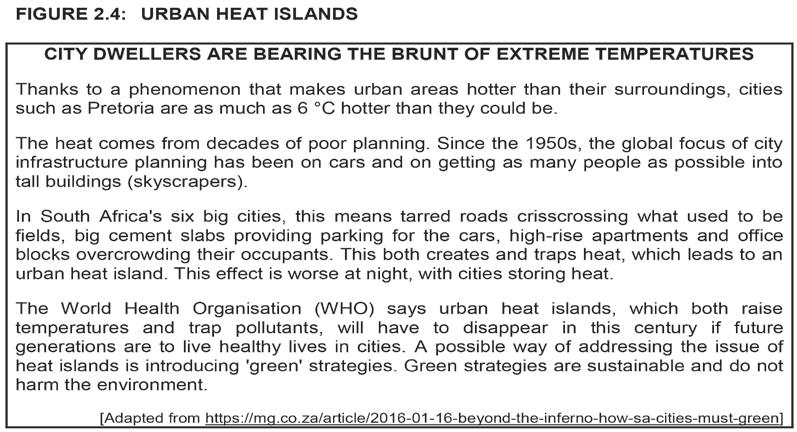

2.4.3 Why is the urban heat island effect more concentrated at night? (2 x 2)(4)
2.4.4 In a paragraph of approximately EIGHT lines, provide sustainable green strategies, as referred to in the extract, that can reduce the heat island effect. (4 x 2)(8)


2.6.1 Is the river profile in FIGURE 2.6 graded or ungraded? (1 x 1)(1)


2.6.2 Give evidence for your answer to QUESTION 2.6.1. (1 x 2)(2)
2.6.3 Why will there be more erosion than deposition at A? (2 x 2)(4)

2.6.4 In a paragraph of approximately EIGHT lines, explain the fluvial processes that a river undergoes to reach a graded profile. (4 x 2)(8)
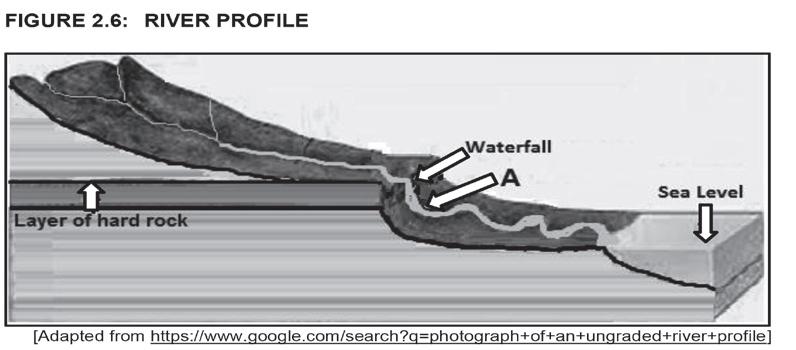
7
The official papers in this supplement have been published with the endorsement of the Department of Basic Education. For more Matric Questions and Memoranda go to https://www.education.gov.za/
A PROUD BRAND OF
[75]
Matric Q&A

GEOGRAPHY
SECTION B: RURAL AND URBAN SETTLEMENTS AND SOUTH AFRICAN ECONOMIC GEOGRAPHY

QUESTION 3
3.1 Refer to FIGURE 3.1 showing models of urban structure. Choose the correct answer from the options given in brackets to make the statement TRUE. Write only your answer next to the question numbers (3.1.1 to 3.1.7) in the ANSWER BOOK, e.g. 3.1.8 concentric zone.
3.2.3
An example of an economic activity concerned with the extraction of raw material is ...
A transport.
B construction.
C mining.
D research.
3.2.4
An exchange of goods and services between countries is referred to as …
A international trade.
B domestic trade.
C foreign exchange.
D trade balance.
3.2.5 … refers to goods that are brought into the country.
A Exports
B Imports
C Market
D Trade
The domestic market is also known as the … market.
3.2.6
A regional B foreign C provincial

D home
3.1.1
The model which shows land use arranged in wedges is known as the (multiple nuclei/sector) model.
3.1.2 In the (multiple nuclei/concentric zone) model the CBD is the focal point around which the urban area develops.
3.1.3 Industries and low-cost housing develop along main roads or railways in the (concentric zone/sector) model.
3.1.4 The (sector/multiple nuclei) model is most applicable to modern cities.
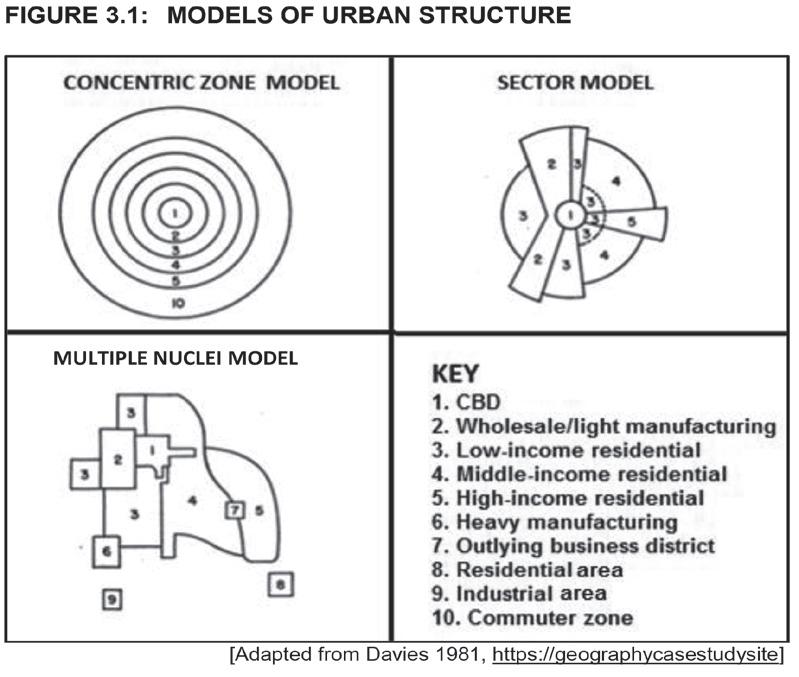
3.1.5 The (sector/concentric zone) model does not consider development along transport routes.
3.1.6 Cities that have several focal points around which urban development occurs are examples of the (concentric zone multiple nuclei) model.
3.1.7 The (sector/multiple nuclei) model displays characteristics of the concentric zone model. (7 x 1)(7)
3.2 Various options are provided as possible answers to the following statements. Choose the answer and write only the letter (A–D) next to the question numbers (3.2.1 to 3.2.8) in the ANSWER BOOK, e.g. 3.2.9 D.
3.2.1
The economic sector associated with the provision of transport is referred to as the … sector.

A primary B secondary
C tertiary
D quaternary
3.2.2
The total value of all goods and services produced in one year within a country is called the …







A per capita income.
B gross domestic product.
C gross national product. D gross domestic income.
3.2.7 Income generated by a country through exports refers to …
A per capita income.


B foreign exchange.
C export-orientated industries.


D export market.
3.2.8 An example of a quaternary economic activity is …
A fishing.
B ship building.
C service provision.
D research.
3.3 Refer to FIGURE 3.3, a graph on rural depopulation.

(8 x 1)(8)
Questions
3.3
The official papers in this supplement have been published with the endorsement of the Department
of Basic Education. For more Matric Questions and Memoranda
go to https://www.education.gov.za/
8
for
start on page 10


















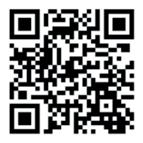



9 The official papers in this supplement have been published with the endorsement of the Department of Basic Education. For more Matric Questions and Memoranda go to https://www.education.gov.za/ A PROUD BRAND OF Full page advert Sign up to be part of The Herald community. WHATEVER YOU LIVE FOR, WE LIVE TO TELL THAT STORY. FO R YOU
Matric Q&A
GEOGRAPHY
3.3.1 Define the concept rural depopulation (1 x 1)(1)
3.3.2 Determine the number of people living in the rural areas of South Africa in 2004. (1 x 1)(1)


3.3.3 Is the rural population showing an increase or a decrease from 2004 to 2020? (1 x 1)(1)
3.3.4 How will this trend (the answer to QUESTION 3.3.3) have a negative impact on the standard of living of the rural population? (2 x 2)(4)
3.3.5 Explain TWO social factors that contributed to rural depopulation in South Africa. (2 x 2)(4)
3.3.6 Suggest TWO sustainable strategies to encourage people to return to rural areas. (2 x 2)(4)
3.4 Refer to FIGURE 3.4, a cartoon based on an urban issue related to rapid urbanisation.

3.6 Refer to FIGURE 3.6 and study the information on the PWV (Gauteng) Industrial Region.
3.4.1 Identify the urban issue shown in the cartoon. (1 x 1)(1)
3.4.2 Give a reason for your answer to QUESTION 3.4.1. (1 x 2)(2)
3.4.3 Why is the urban issue in the cartoon common in most cities? (2 x 2)(4)
3.4.4 In a paragraph of approximately EIGHT lines, discuss the negative impact of this urban issue on motorists. (4 x 2)(8)
3.5 Refer to the extract in FIGURE 3.5 based on cattle farming in South Africa.
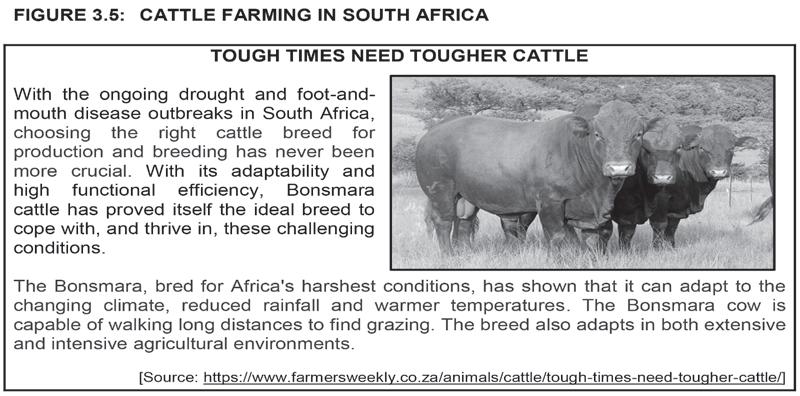
3.6.1 Which of the urban settlements in the PWV (Gauteng) Industrial Region shown in FIGURE 3.6 started out as a gold mining settlement? (1 x 1)(1)
3.6.2 Quote TWO statistics from FIGURE 3.6, which indicate that the PWV (Gauteng) Industrial Region is the economic heartland of South Africa. (2 x 1)(2)

3.6.3 Discuss TWO factors that have favoured the development of industries in the PWV (Gauteng) Industrial Region. (2 x 2)(4)
3.6.4 The PWV (Gauteng) Industrial Region faces many challenges, including high levels of unemployment and water shortages.
(a) Why has water supply hindered the development of the PWV (Gauteng) Industrial Region? (1 x 2)(2)
(b) How did the PWV (Gauteng) Industrial Region overcome the shortage of water supply for industries? (1 x 2)(2)





(c) Why does the PWV (Gauteng) Industrial Region face challenges of unemployment despite the high concentration of industries in this industrial region? (2 x 2)(4)


QUESTION 4
4.1 Refer to FIGURE 4.1 showing rural settlement patterns and shapes. Choose the correct answer from the options given in brackets to make the statement TRUE. Write only your answer next to the question numbers (4.1.1 to 4.1.8) in the ANSWER BOOK, e.g. 4.1.9 dispersed.
3.5.1 Identify ONE problem from the extract that poses a challenge to cattle farmers. (1 x 1)(1)

3.5.2 Why, according to the extract, is the Bonsmara breed ideal for cattle farming? (2 x 1)(2)

3.5.3 Suggest TWO ways in which the government can assist small-scale cattle farmers to increase beef production. (2 x 2)(4)
3.5.4 In a paragraph of approximately EIGHT lines, discuss how an increase in beef production can contribute to food security in South Africa. (4 x 2)(8)

The official papers
this
4.1.1 A (dispersed/nucleated) settlement pattern is associated with large machinery.
4.1.2 The settlement pattern that encourages more community activities is (nucleated/dispersed).
4.1.3 The lack of safety and an increased vulnerability to crime is more predominant in (nucleated/dispersed) settlement patterns.
4.1.4 (Nucleated/Dispersed) settlement patterns are commonly associated with privately owned land.

4.1.5 The settlement that develops at the intersection of transport routes has as a (linear/crossroads) shape.
https://www.education.gov.za/



in
supplement have been published with the endorsement of
the Department of Basic Education. For more Matric Questions and Memoranda
go to
10
[75]
4.1.6 (Circular/Linear) shaped settlements develop around a focal point.

4.1.7 A (circular/linear) shaped settlement forms along transport routes.
4.1.8 The settlement shape responsible for the greatest accessibility is a (linear/crossroads) settlement. (8 x 1)(8)



4.2 Various options are provided as possible answers to the following statements. Choose the answer and write only the letter (A–D) next to the question numbers (4.2.1 to 4.2.7) in the ANSWER BOOK, e.g. 4.2.8 D.
4.2.1 ... is the staple food of many people in South Africa.
A Fruit B Maize
C Wheat

D Beef
4.2.2 Agricultural activities are associated with the ... economic sector.



A quaternary

B secondary
C tertiary
D primary
4.2.3 … is when people in a country have access to enough nutritious food.

A Food insecurity


B Malnutrition
C Famine
D Food security
4.2.4 An advantage of genetically modified (GM) crops is that they ...

A have less nutritional value.
B produce more food per hectare.
C have a shorter storage life.

D are less expensive.
4.2.5 Monoculture is a characteristic of ... farming.



A small-scale
B traditional
C large-scale

D subsistence
4.2.6 Sugar cane farming is mainly practised in ...












A the Eastern Cape.
B the Western Cape.
C KwaZulu-Natal.
D North West.
4.2.7 ... are factors that favour agricultural production in South Africa.
A Floods and climate change.
B Research and climatic differences.

C Crime and labour strikes.
D Fluctuating prices and subsistence farming. (7 x 1)(7)

4.3 FIGURE 4.3 shows urban sprawl.
4.3.1 Define the concept urban sprawl (1 x 1)(1)


4.3.2 Give evidence from FIGURE 4.3 that suggests that urban sprawl is taking place. (1 x 2)(2)

4.3.3 Why do local authorities find it difficult to control urban sprawl? (2 x 2)(4)
4.3.4 In a paragraph of approximately EIGHT lines, discuss the unfavourable environmental conditions caused by urban sprawl in the rural-urban fringe. (4 x 2)(8)





4.4 Refer to FIGURE 4.4 based on an urban environmental justice issue.
4.4.1 Define the concept environmental injustice. (1 x 1)(1)
4.4.2 State the environmental injustice evident in FIGURE 4.4. (1 x 1)(1)
4.4.3 Give evidence from the photograph to support your answer to QUESTION 4.4.2. (1 x 1)(1)
4.4.4 Why is your answer to QUESTION 4.4.2 considered an environmental injustice? (2 x 2)(4)
4.4.5 Discuss how this environmental injustice will affect the local community. (2 x 2)(4)
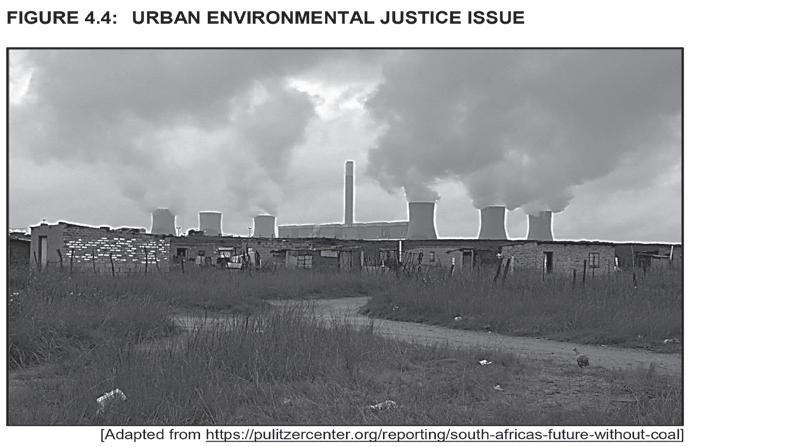


4.4.6 Explain how local authorities can develop sustainable solutions to reduce the impact of this injustice issue on the environment. (2 x 2)(4)

11
The
official papers in this supplement have
been
published
with the endorsement of the Department of Basic Education. For more Matric Questions and Memoranda go to https://www.education.gov.za/
A PROUD BRAND OF
Matric Q&A

GEOGRAPHY
4.5 FIGURE 4.5 is based on strategies for industrial development: the Saldanha Bay Industrial Development Zone (SBIDZ).
4.5.5 How will investments in the Saldanha Bay IDZ have an impact on the people seeking employment in this zone? (2 x 2)(4)

4.5.6 Suggest what social responsibility initiatives a new investment company should have towards the local community. (2 x 2)(4)
4.6 Refer to FIGURE 4.6 based on the informal sector.
4.5.1 Name the new local investor in Saldanha Bay. (1 x 1)(1)








4.5.2 What will be the core function of the new investor in the Saldanha Bay IDZ? (1 x 1)(1)

4.5.3 State the physical (natural) factor that could have attracted the new investor to the Saldanha Bay IDZ. (1 x 1)(1)

4.5.4 Discuss how the new investment project in the Saldanha Bay IDZ would have a positive impact on transport infrastructure in the zone. (2 x 2)(4)
4.6.1 What example of informal trade, according to the extract, is shown in FIGURE 4.6? (1 x 1)(1)
4.6.2 How many people in South Africa are involved in the informal retail sector? (1 x 1)(1)
4.6.3 Quote evidence from the extract to suggest that the informal sector is a much easier option to gain employment. (1 x 1)(1)
4.6.4 According to the extract, why are so many women employed in the informal sector? (2 x 2)(4)
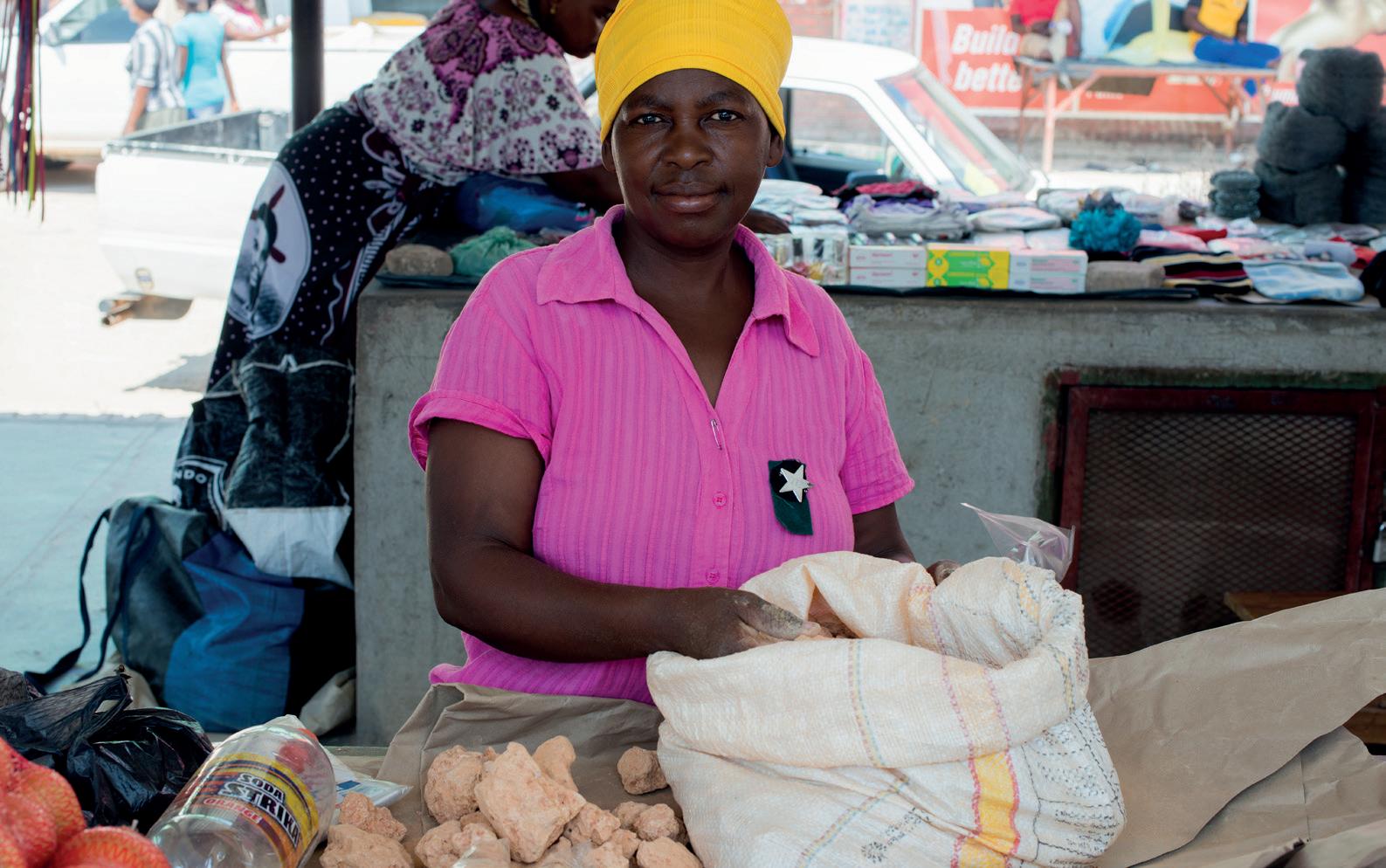


4.6.5 In a paragraph of approximately EIGHT lines, discuss the positive impact that the informal sector has on the economy of South Africa. (4 x 2)(8) [75]
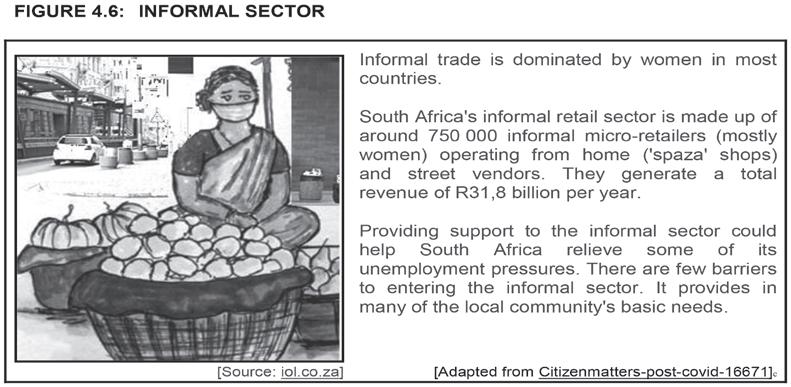

TOTAL: 225
 The official papers in this supplement have been published with the endorsement of the Department of Basic Education. For more Matric Questions and Memoranda go to https://www.education.gov.za/
The official papers in this supplement have been published with the endorsement of the Department of Basic Education. For more Matric Questions and Memoranda go to https://www.education.gov.za/
12
INSTRUCTIONS AND INFORMATION
Marking guidelines have been developed to standardise marking in all provinces.


These are some things to bear in mind about how your answers will be marked:
Candidates are expected to make a choice of THREE questions to answer. If all questions are answered, ONLY the first three questions are marked.
For the following action words, ONE-WORD answers are acceptable: give, list, name, state, identify.




For the following action words, a FULL SENTENCE must be written: describe, explain, evaluate, analyse, suggest, differentiate, distinguish, define, discuss, why, how.
The following action words will be read within its context to determine whether a ONE-WORD answer or FULL SENTENCE is required: provide, what, tabulate.


It is very important to write as neatly and legibly as possible to make your work easy to mark.
SECTION A: CLIMATE, WEATHER AND GEOMORPHOLOGY



QUESTION 1
1.1 1.1.1 A (1)
1.1.2 B (1)
1.1.3 A (1)
1.1.4 A (1)
1.1.5 B (1)
1.1.6 B (1)
1.1.7 B (1) (7 x 1) (7)
1.2 1.2.1 I (1)
1.2.2 E (1)
1.2.3 D (1)
1.2.4 G (1)
1.2.5 C (1)
1.2.6 A (1)
1.2.7 B (1)

1.2.8 H (1) (8 x 1) (8)
1.3 1.3.1 Cold and warm fronts visible (Cold/Warm front visible) (1)
Presence of an occluded front (1)


Low pressure (less than 1000hPa) (1)
Presence of warm/cold sectors (1)
Mid-latitude cyclone is moving from west to east (as indicated by the symbol of the cold front) (1)
It is where a mid-latitude cyclone should be located in winter (date) (1)
[ANY ONE] (1 x 1) (1)
1.3.2 Convergence (meeting) of cold (dry) polar air and warm (moist) sub-tropical air masses (2)
Frictional drag (disturbances) occurs at the polar front (2)

[ANY ONE] (1 x 2) (2)
1.3.3 It is steered/driven by the westerly winds (2)
Located in the westerly wind belt (2)
Driven by jet streams (2)
[ANY ONE] (1 x 2) (2)
1.3.4 Steep pressure gradient (isobars are close together) (2)
Rapid upliftment of air mass (2)

Presence of cumulonimbus clouds (2)
Backing of wind (2)
[ANY ONE] (1 x 2) (2)
1.3.5 Cold front moves faster than the warm front (2)
Warm air sector narrows as the cold front undercuts it (2)
The cold front catches up with the warm front (at the apex) (2)
[ANY TWO] (2 x 2) (4)
1.3.6 Increased rainfall fills up dams/rivers/jo-jo tanks which impacts positively on the agricultural sectors (2)
Enables irrigation of winter crops which provides enough food for the local market (2)

More agricultural products (accept examples) available for manufacturing industries/export (2)




Low temperatures ideal for crops that thrive in cold conditions (2)
Cold conditions can kill pests that eat the crops (2)
More infiltration is causing a higher water table therefore ground water increases (2)
Supplies seasonal agricultural jobs (2)
Cleans polluted rivers as it washes out pollution in river (2)
Improves pasturage for livestock grazing (2)
Soil fertility increases due to alluvium from flooding (2)
Contributes to food production/food security (2)
Availability of water for livestock (2)
[ANY TWO] (2 x 2) (4)
1.4 1.4.1 B (1)
Accept Indian Ocean (1) (1 x 1) (1)
1.4.2 Divergence of air from South Atlantic High to the trough of low pressure in the interior (2)
Anticlockwise rotation from South Atlantic High feeds in the cold air (2)
Cold air from above the Atlantic Ocean/Benguela current (2) Air is dry due to limited evaporation (2)
[ANY ONE] (1 x 2) (2)
1.4.3 Cool dry air from the south west meets warm moist air from the north east (2)
Warm air is forced to rise rapidly over colder air and the rising air cools and condenses (cumulonimbus clouds form and thunderstorms occur) (2)
13
The official papers in this supplement have been published with the endorsement of the Department of Basic Education. For more Matric Questions and Memoranda go to https://www.education.gov.za/
A PROUD BRAND OF
MEMO PAPER 1
Matric Q&A

1.4.4
GEOGRAPHY
1.5 1.5.1
There is rapid rising of warm air along the east of the moisture front (2)
Moisture front covers an extensive linear area (NW to SE) (2)
[ANY TWO] (2 x 2) (4)
Torrential (Heavy) rainfall can cause extensive flooding (2)
Lightning can cause extensive fires (accept examples) (2)
Lightning can cause the death of people and livestock (2)
Hail can cause damage to property (2)
Gale-force winds can damage property/infrastructure/crops/ uproot trees (2)
Flooding can lead to loss of human life/disrupt activities (2)
Crops will be destroyed by heavy rainfall (2)
Rainfall can destroy property and infrastructure (accept examples) (2)
There will be widespread soil erosion/loss of fertile soil due to heavy rainfall (accept examples) (2)
Poor visibility due to the heavy rainfall can cause accidents (2)
Ecosystems can be destroyed by flooding (2)
Loss of biodiversity due to destructive nature of the rain (2)
Economic destruction (accept explained examples) (2)
Social destruction (accept explained examples) (2)
Interruption of traffic/lack of visibility due to torrential rain (2)
[ANY FOUR] (4 x 2) (8)
At the point where the river enters the sea/river mouth/ lakes (1) (1 x 1) (1)
1.5.2 They are home to hundreds of millions of people (1) (1 x 1) (1)
1.5.3 Groundwater being pumped from aquifers (permeable rocks) (1) (1 x 1) (1)

1.5.4 Deltas are a source of water (2)
Deltas sustain all ecosystems (2)
Deltas ensures biodiversity (2)
Deltas provide fertile farming land for agricultural activities/ food production (2)
Tourism (leisure activities) opportunities are created by deltas and contributes to the economy (2)
Home to many people/settlement (2)
Can be part of water transport system (2)
Deltas are a source of protein (fish) (2)
Provides water for fishing and aquaculture (2)
[Accept candidates might write in the negative]
[ANY TWO] (2 x 2) (4)
1.5.5 Limit the number of people living on deltas to reduce the amount of water pollution (2)

Reduce infrastructural development on deltas (2)
Practise ecotourism to preserve deltas (2)
Regulate mariculture in and around deltas (2)
Reduce agricultural activity to protect the fertility of the soil (2)
Reduce irrigation to ensure high water levels in the delta (2)
Limit/regulate the extraction of groundwater beneath deltas (2)

Declare as conservation areas (2)
Educating the population residing in area about the significance of deltas (2)
Buffer (fencing off) delta areas (2)
Impose fines on those who pollute delta areas (2)
Sustainable farming methods (accept examples) (2)
Monitor/management upstream river development so rivers are not starved of sediments (2)
Build fewer dams upstream to allow more sediment to be carried in rivers (2)
Legislation to protect deltas (2)
Restrict number of hydroelectric power stations/dams/ reservoirs which alter delta ecosystems (2)
Maintain vegetation and plantations in and around the delta (2)
Regular monitoring and testing of the water quality (River health programmes) (2)
[ANY FOUR] (4 x 2) (8)
1.6 1.6.1 When a river erodes (downwards) again because it is re-energised (1)
[CONCEPT] (1 x 1) (1)

1.6.2 Lower course/Old stage (1) (1 x 1) (1)
1.6.3 Wide floodplain (almost flat) (1)

Wide river valley (1)
Meanders are visible (1)
River enters the sea/river mouth (1)
Presence of terraces (1)
Evidence of lateral erosion (1)
At the sea/ocean (label) (1)





Entrenched meanders (1)
Shading shows a deepening of the river channel (1)
[ANY ONE] (1 x 1) (1)


1.6.4 Gradient is steeper (river flows down a slope) (2)


Turbulent flow (fast-flowing river has more energy) after rejuvenation (2)
Increase in volume of water (2)
Results in a higher velocity after rejuvenation (2)
[ANY TWO] (2 x 2) (4)
1.6.5 (a) River channel has become deeper (2)
River channel has become wider (2) River channel has become straighter (fewer meanders curves/bends) (2)
River channel has steeper sides (2)
[ANY ONE] (1 x 2) (2)
(b) Meander loop has moved further downstream (2) Meander downstream has disappeared (2)
Meander neck has become narrower (length and width of meander decreased) (2)
Meander is entrenched/incised/deepens (2)
[ANY ONE] (1 x 2) (2)
1.6.6 Increases the amount of silt in the dam (2)
Increased silt may damage the dam wall and cause it to collapse (2)
Silting negatively impacts on the biodiversity of dams (2)
The official papers in this supplement have been published with the endorsement of the
Department of Basic Education. For more Matric Questions and Memoranda go to https://www.education.gov.za/
14
Water holding capacity of dam reduced (2)
Less effective in controlling flood waters (2)
The increased volume and velocity of water may break the dam walls (2)

Increases in the cost of maintenance (2)


Water quality decreases when sediments are deposited (2) [ANY TWO] (2 x 2)
QUESTION 2
2.1 2.1.1 Low pressure cell (1)
2.1.2 High pressure cell (1)
2.1.3 Low pressure cell (1)

2.1.4 Low pressure cell (1)
2.1.5 High pressure cell (1)
2.1.6 Low pressure cell (1)
2.1.7 High pressure cell (1)

2.1.8 High pressure cel (1) (8 x 1) (8)
2.2 2.2.1 D (1)
2.2.2 F (1)
2.2.3 G (1)
2.2.4 E (1)
2.2.5 H (1)
2.2.6 B (1)

2.2.7 C (1) (7 x 1) (7)
2.3 2.3.1 Air circulation around cyclone is clockwise (1)
Date (April is late summer in the southern hemisphere) (1) Mozambique/Mozambique channel/Madagascar/Maputo/ Tanzania/Zambia is in the southern hemisphere (1)
It develops over the southern Indian Ocean (1) [ANY ONE] (1 x 1) (1)

2.3.2 The warm air temperatures above the sea/warm ocean (+26.5°C) (Mozambique/Agulhas) current generates more evaporation (2)
Mozambique channel located close to the equator (2) Mozambique channel is in the Indian Ocean which is warmer (2) [ANY ONE] (1 x 2) (2)
2.3.3 Increased moisture which will lead to rapid condensation (2)
Latent heat being released from rapid condensation would provide the energy for the system to move rapidly from A to B (2)
Wind intensity will change from gale-force to hurricane strength because of the wind shear (change in wind speed and direction) (2)
Developed from a tropical depression into a tropical cyclone (2) Eye has formed/intensified because of the decrease in air pressure (2)
Area covered by the eye increased in size (2)
Rainstorms increase as the eye wall and leading/forward quadrant approaches (2)
A is only a storm without an eye, B has an eye (2)
Pressure continues to drop as it moves towards B (intensified) (2)
[ANY TWO] (2 x 2) (4)
2.3.4
2.3.5
Source of moisture is reduced as it moves over the land (2)
Friction with the land surface would decrease the wind speed (2) Moves away from warmer waters/cold dry air enters the system (2)
[ANY TWO] (2 x 2) (4)
The coastline of Mozambique will be subjected to wind and water erosion, which will reshape the coastline (2)
More coastal rocks will become exposed, limiting human activities (2)
Strong winds and torrential rain will destroy sand dunes, which are essential for ecosystems and biodiversity (destroys natural coastal vegetation) (2)
Bay areas along the coastline would become shallower as a result of excess silting and restricts development (2)
Blockage of waterways by sand deposits decreases access to coastlines (2)
The coastline will be steeper and become inaccessible to tourists (2)
[ANY TWO] (2 x 2) (4)
2.4 2.4.1 An area of high temperature over the city that decreases towards the rural area/phenomenon that makes urban areas hotter than their surroundings (1)
[CONCEPT] (1 x 1) (1)
2.4.2 ‘the global focus of city infrastructure planning has been on cars’ (1)



‘getting as many people as possible into tall buildings’ (1) ‘Heat comes from decades of poor planning’ (1) ‘office blocks overcrowding their occupants’ (1) ‘tarred roads criss-crossing’ (1) ‘big cement slabs’ (1)
[ANY TWO] (2 x 1) (2)
2.4.3 Subsiding air at night pushes the warm air closer to buildings in the city which results in more heat being concentrated (in a smaller area) (2)
Weaker convection currents at night concentrates the heat island effect (2)
Subsiding air traps the heat between buildings (2) [ANY TWO] (2 x 2) (4)
2.4.4 Plant more trees to absorb more carbon dioxide (2) Establish roof gardens/vertical gardens on high-rise buildings (2) Create parks/greenbelts in the urban area (2)
Reduce carbon emissions in urban areas by making use of solar energy (2)

Reduce carbon emissions in urban areas by making use of wind energy (2)






Replace concrete/tar surfaces with cobble stones which allow infiltration of water and cooling through evaporation (2)
Promote urban farming that will result in more evapotranspiration and cooling of temperatures (2)
Use of public transport/cycling to reduce the number of vehicles on the roads (2)
Reduce the number or vehicles on the road (accept examples) (2)
Use of reflective paint on buildings and roofs (2)

15 The official papers in this supplement have been published with the endorsement of the Department of Basic Education. For more Matric Questions and Memoranda go to https://www.education.gov.za/ A PROUD BRAND OF
(4) [75]
Matric Q&A
GEOGRAPHY
Reducing our carbon footprint through recycling and re-using of products (2)
Modernisation of buildings with greener materials (accept examples) (2)

Implementing energy-saving strategies (accept examples) (2)


Encourage the use of hybrid cars which produce no pollution (2)
Use of catalytic converters in motor vehicles (2)


Creation of water features (accept examples) (2)
Green policy to be included in all legislation (2)
Awareness/education campaigns on green policies (2)
Incentives for going green/eco-friendly products (accept examples)
[ANY FOUR – ACCEPT QUALIFIED EXAMPLES] (4 x 2) (8)


2.5 2.5.1 Process in which one river captures/robs the headwaters of another river (1)
[CONCEPT] (1 x 1) (1)
2.5.2 1 – elbow of capture (1)


2 – wind/dry gap (1) (2 x 1) (2)
2.5.3 Flowing over a steeper gradient (accept examples) (1)
Flowing over softer rocks (1)
Increase in the volume of water (accept examples) (1)

Headward erosion (1)
[ANY TWO] (2 x 1) (2)
2.5.4 Headwaters of the misfit stream was cut off by the captor stream through the process of headward erosion (2)
It continued to flow (after the wind/dry gap) with a reduced supply of water (2) (2 x 2) (4)
2.5.5 Volume of water in the river will increase (2)
Velocity (speed) of the river increases (2)
Increases the erosive power of the river (2)
Ability to transport a bigger load (2)
Rate of deposition is lowered (2)
Possibility of flooding increases (2)
River discharge is turbulent (2)
[ANY THREE] (3 x 2) (6)
2.6 2.6.1 Ungraded (1) (1 x 1) (1)


2.6.2 It has an uneven profile (2)

Presence of temporary base level of erosion/knickpoint waterfall (plunge pool) (2)
Presence of resistant (hard) rock (2)
Multi concave profile (2)
[ANY ONE] (1 x 2) (2)
2.6.3 Riverbed is uneven and causes turbulent flow, which encourages erosion (2)
The steeper gradient will result in an increase in erosion (2)
It has obstacles (knickpoint/waterfall/temporary base levels) along the river that causes erosion (2)
The falling water is causing undercutting at the base of the waterfall (accept examples of erosional processes that occur at the base of the waterfall (plunge pool) (2)
The softer rock at the base of the waterfall erodes faster (2)
[ANY TWO] (2 x 2) (4)
2.6.4 Downward/Vertical erosion dominates in the upper course, causing a steep valley slope (2)
Headward erosion removes temporary base levels of erosion in the upper course (2)
Downward/Vertical erosion removes temporary base levels (waterfall) in the upper course (2)
This material is then transported downstream (2)
Discharge of the river increases in middle course, causing lateral erosion (2)
Gradient in the middle course becomes less steep (2)
Deposition dominates in the lower course because the gradient is gentle (2)
Deposited materials fill up lakes and dams (2)
The river profile will now develop a concave shape from upper to lower course (2)
Equilibrium between erosion and deposition will maintain (result in) a graded profile (2)
[ANY FOUR] (4 x 2) (8) [75]
SECTION B: RURAL AND URBAN SETTLEMENTS AND ECONOMIC GEOGRAPHY OF SOUTH AFRICA QUESTION 3
3.1 3.1.1 Sector (1)
3.1.2 Concentric zone (1)
3.1.3 Sector (1)
3.1.4 Multiple nuclei (1)
3.1.5 Concentric zone (1)
3.1.6 Multiple nuclei (1)
3.1.7 Sector (1) (7 x 1) (7)
3.2 3.2.1 C (1)
3.2.2 B (1)
3.2.3 C (1)
3.2.4 A (1)
3.2.5 B (1)
3.2.6 D (1)
3.2.7 B (1)
3.2.8 D (1) (8 x 1) (8)
3.3 3.3.1 Decrease in population numbers in rural areas (1)
[CONCEPT] (1 x 1) (1)
3.3.2 21-23 million (1) (1 x 1) (1)
3.3.3 Decrease (in population numbers) (1) (1 x 1) (1)
3.3.4 Less people paying for municipal services (market) resulting in less municipal services available (2)

Decrease in customers/buying power as people leave the rural areas (2)
Results in businesses closing and an increase in unemployment (2)
Closing of basic services (accept examples) (2)

The official papers in this supplement have been published with the endorsement of
the Department of Basic Education. For more Matric Questions and Memoranda go to https://www.education.gov.za/
16
Brain drain as skilled people leave the area (2)
Less investment as the area becomes a ghost town (2)
Decrease in production as there are more old people and fewer labourers (2)
Increasing crime brings stress to the people living in the settlement/increase in crime/social ills on the (vulnerable) population left in rural areas (2)
Property values decrease (2)


Poverty increases (2)
Local economy stagnates which results in less employment (2)
Increase in child-headed families (2)
Higher dependency on social services (2)

Travel further to serviced towns (2)
[ANY TWO] (2 x 2) (4)
3.3.5 Unemployment due to businesses closing down (2)
Mechanisation requires less manual labour and leads to unemployment (2)
Increase in crime due to lack of policing (2)
Lack of recreational/cultural/entertainment facilities due to lack of investment (2)
Increase in poverty due to unemployment/low salaries (2)
Poor basic services (accept examples) due to less people investment (2)
Travel long distances to access tertiary education (2)
Low salaries cause people to move to urban areas to seek better-paying jobs (2)
Farm killings create fear and force farmers to move to urban areas (2)
The slow pace of finalising the land reform is frustrating and forces people to move (2)
Lack of professional services in the rural areas causes people to seek those services elsewhere (2)
Pull factors (from an uban perspective):


Accessibility to better and efficient services in urban areas (accept explained examples) (2)
Greater variety of recreational activities attracts young adults (2)
Higher standard of living/higher wages in urban areas due to dominant secondary and tertiary activities (2)
Greater job opportunities in urban areas due to high concentration of economic activities (2)
[ANY TWO - must qualify statement] (2 x 2) (4)


3.3.6 Acceleration of land reform to enable the poor and landless to obtain land for farming (2)
Create job opportunities through the decentralisation of industries from urban areas (2)
Improve work conditions and salaries (2)
Change ownership of land from communal to private land ownership (2)
Employment will increase local market's buying power resulting in further businesses opening up (2)
Creating tourism opportunities that would lead to more revenue/ business opportunities for rural community (2)
Improving services in rural areas (accept examples) (2)


Tax rebates and other incentives to attract industries to relocate to the rural area (2)
Making cheaper industrial sites available (2)
Incentives (accept examples) for professional people coming to work in rural areas (2)
Improving infrastructure such as roads for people to easily access services (2)
Hosting festivals in the rural areas to create income (2)
Promote rural areas as peaceful with aesthetic beauty (2)
Examples of eco-tourism, eco-estates (2)
Development of retirement villages (2)
Introduce measures (accept examples) to reduce crime (2)

[ANY TWO] (2 x 2) (4)
3.4 3.4.1 Traffic congestion (1) (1 x 1) (1)






3.4.2 Traffic is gridlocked/Traffic jam/Many cars (2) (1 x 2) (2)
3.4.3 High influx of people with cars that enter cities (2)
People living far from their working areas and as such are commuting daily (2)
Inefficient public transport system that cannot cope with commuter needs (2)
More vehicles on the road due to use of private motor vehicles (2)
Insufficient roads/lanes to cater for the additional vehicles on the road (2)
Expensive parking fees and shortage of parking space forces people to park on streets and as such blocks traffic (2)
Grid iron street patterns in older parts of the city that lead to the build-up of traffic because there are too many stops (2)
Narrow streets that do not allow for the smooth flow of traffic (2)
An influx of mini bus taxis that hold up traffic while picking up and off-loading passengers (2)
Intersections/unsynchronised robots create traffic congestion (2)
Poor road quality (potholes) can slow down traffic (2)
Poor maintenance of the roads (accept examples) (2)
Load-shedding resulting in traffic lights not working resulting in traffic congestion (2)
Large concentration of economic activities in cities (2)
People go to work at the same time and also go home from work the same time (2)
Service delivery protests (2)
[ANY TWO] (2 x 2) (4)
3.4.4 Daily road users experience increase in general stress levels (2)
Road rage becomes a daily occurrence (2)
There will be a higher rate of accidents (2)
Employees arrive late at work (2)
Poor employer/employee relations associated with late arrival at work (2)


People can face disciplinary charges and even lose their jobs for being late (2)
Forced cancellation of some meetings (2)
Loss of productivity as hours lost due to traffic congestion (2)
Stop and start increases petrol consumption which is costly for motorists (2)
Increased maintenance costs for cars of motorists (2)
17
The official papers in this supplement have been published with the endorsement of the Department of Basic Education. For more Matric Questions and Memoranda go to https://www.education.gov.za/
A PROUD BRAND OF
4.1.6 Circular (1)
4.1.7 Linear (1)





4.1.8 Crossroads (1) (8 x 1) (8)
4.2 4.2.1 B (1)
4.2.2 D (1)
4.2.3 D (1)
4.2.4 B (1)
4.2.5 C (1)
4.2.6 C (1)
4.2.7 B (1) (7 x 1) (7)
4.3 4.3.1 The uncontrolled/unplanned/formless expansion of an urban area (1)

[CONCEPT] (1 x 1) (1)
4.3.2 The new buildings (in after diagram) don't follow an organised/ planned pattern (2)

Invasion into the surrounding rural areas (2)
Houses between the fingers have developed (2)
New buildings have been constructed in the outskirts/rural urban fringe (2)
[ANY ONE] (1 x 2) (2)
4.3.3 It is difficult to control the development of informal settlements, which results from a high level of urbanisation (2)
They have limited control over privately owned land (2)
They do not have the capacity to control the influx of people into urban areas (2)
They do not have the budget and time to plan urban areas in a controlled manner (2)
Interference of political parties/Illegal invasion of land (2)
Some municipal officials sell land illegally/corruption (2)
Land invasion on unoccupied land (2)
Legal protocols make it difficult for local authorities to impose the law (2)
High demand to locate in urban areas (2)
[ANY TWO] (2 x 2) (4)
4.3.4 An influx of motor vehicles would cause an increase in air pollution (2)
Decentralisation of industries into the area contributes to global warming (2)
An increase in population/vehicle numbers adds to the noise/ land pollution (2)
Industries in areas dumping waste water in nearby rivers (water pollution) (2)
Infrastructural and housing development necessitates the clearing of vegetation (2)
This would decrease the availability of oxygen (clean air) in the area (2)
Deforestation and a lack of vegetation cover would cause increased runoff and soil erosion (2)
Changes in the local microclimate due to the removal of vegetation (2)
Aesthetic beauty of the area would be diminished (2)
The habitat for ecosystems in the area would be compromised (2)
There would be a loss of biodiversity (2)
An increase in population will cause water pollution due to lack of services (2)
Infiltration is reduced, affecting the water table negatively (2)
Waste management becomes difficult, resulting in (various forms of) pollution (2)
Artificial surfaces lead to flash flooding due to reduced infiltration (2)
[ANY FOUR] (4 x 2) (8)
4.4 4.4.1
When the environment is treated in a manner that threatens to harm its existence/pollution of the natural environment/ destruction of the natural environment (1)
[CONCEPT] (1 x 1) (1)
4.4.2 Air pollution (1) (1 x 1) (1)
4.4.3 Smoke from industries/power station being released into the atmosphere (1)
Steam/smoke from cooling towers (1)
[ANY ONE] (1 x 1) (1)

4.4.4 It is polluting the atmosphere/diminished air quality (2)

Increases temperature of the earth/global warming/ozone depletion (2)
Increases chemicals like sulphur dioxide in the air, which causes acid rain (2)
Acid rain lowers the soil fertility (2)
Soot deposits are found on exposed objects (2)
Polluted air increases the rate of smog (2)

[ANY TWO] (2 x 2) (4)
4.4.5 People will suffer from health problems such as asthma and cancer (2)

It will result in increased medical costs for the local community (2) The formation of smog causes visibility problems (2)
Acid rain over the long term will negatively affect buildings/soil/ vegetation (2)
Exploitation of labour might be done on the vulnerable job seekers (2) [ANY TWO] (2 x 2) (4)


4.4.6 Use of renewable/non-conventional sources of energy will have less impact on the health of people (2)
Stricter control by local authorities on the levels of air pollution on a regular basis (2)
Fines imposed on factory owners for exceeding the pollution levels (2)


Incentives on tax rebates for factory owners who comply (2) Create more green spaces and parks in the urban area (2)
Stacks of factories to be built higher so that pollutants can be dispersed into the upper atmosphere (2)
Put filters in factory stacks to reduce the amount of pollutants emitted (2)
Promote awareness campaigns/education regarding clean energy resources (2)

Promote industrial decentralisation to reduce pollution in the area (2)
The official
https://www.education.gov.za/


19
papers in this supplement have been published with the endorsement of the Department of Basic Education. For more Matric Questions and Memoranda go to
A PROUD BRAND OF
Matric Q&A
GEOGRAPHY
[ANY TWO] (2 x 2) (4)
4.5 4.5.1 West Coast Corrosion Protection/WCCP (1) (1 x 1) (1)
4.5.2 Corrosion protection (1)
It will service a range of marine vessels (1)
[ANY ONE] (1 x 1) (1)
4.5.3 Natural bay (natural port) (1)


Flat land (1)
Large amount of space available (1)
[ANY ONE] (1 x 1) (1)
4.5.4 Road network in Saldanha Bay will be extended/upgraded (2)
Road network linking Saldanha Bay to other areas will be extended/upgraded (2)
Harbour facilities will be improved and extended (2)
Railway network in the vicinity will be upgraded for the transport of bulky goods (2)
Bridges will be constructed to facilitate easier movement of goods/people (2)
Links between the different modes of transport (accept examples) improve accessibility/facilitate economic growth in the region (2)
[ANY TWO] (2 x 2) (4)
4.5.5 Positive:
Create employment opportunities (2)

Increased earning potential (2)
Greater skills development based on greater demand (2)

Possible potential for promotions (2)
Improved working conditions and employee benefits associated with working with large companies (2)






Upliftment of standard of living/multiplier effect (2)

Alleviate poverty (2)
Negative:

Skilled workers from other areas are preferred above the locals of the area (2)

Smaller local businesses in direct competition with the investors might close with possible job losses (2)
Locals in the area might not have the necessary qualifications for the employment opportunities (2)
Susceptible to corruption, nepotism, bribery in order to secure jobs (2)
[ANY TWO] (2 x 2) (4)
4.5.6 Development of more facilities (accept explained examples) (2)

Improvement in services (accept explained examples) (2)
Learnerships/Bursaries for the youth in the community (2)
Sports/Recreational/Cultural sponsorships (2)
Partnerships with the community to reduce crime and youth empowerment (2)
Feeding schemes for disadvantaged members of the community (2)
Provision of PPE's/medicines in cases of disease outbreaks (2) Skills development programmes (2)
Improvement of infrastructure (accept explained examples) (2)
Funding/Create community employment projects (2)
Local people should be given preference to employment opportunities (2)
Funding and upgrading of local schools (2)

Funding environmental cleaning projects (2)
[ANY TWO] (2 x 2) (4)
4.6 4.6.1 (Street) vendor/hawker (1) Spaza shop (1)
[ANY ONE] (1 x 1) (1)
4.6.2 750 000 (1) (1 x 1) (1)
4.6.3 'There are few barriers to entering the informal sector' (1) ‘Operating from home (spaza shops)’ (1)
[ANY ONE] (1 x 1) (1)
4.6.4 Women have to fulfil domestic duties and the informal sector allows them to do both from home (2)
There are few barriers to entering the informal sector (2)
The informal market is lucrative and provides easy employment opportunities (2)
Smaller number of women have the required education and technical skills for jobs in the formal sector (2)
Women normally have to head up households (breadwinners) as single mothers (2)
Flexible hours allow women to perform business and domestic duties (2)
Gender inequality in the workplace causes less women to be employed (2)

[ANY TWO] (2 x 2) (4)
4.6.5 Creates employment for (local) people that cannot find employment in the formal sector (2)
People are able to earn an income which increases buying power, resulting in an increase in the production of goods (2)
Informal sector businesses purchase goods to sell from the formal sector increasing their market (2)
Multiplier effect stimulates other formal businesses (2) Businesses in the formal sector sub-contract people from the informal sector, creating more employment (2)
By buying goods (accept examples) they pay VAT, this contributes to the tax of the country (2)
Goods that are sold are cheap and affordable, creating a bigger market, thus increasing production and trade (2)
The informal sector engages in partnerships with formal businesses (accept examples) that stimulate business (2)
People employed in the informal sector develop entrepreneurial skills needed in the economy (2)
[ANY FOUR] (4 x 2) (8)
The official papers in this supplement have been published with the endorsement of the
Department of Basic Education. For more Matric Questions and Memoranda go to https://www.education.gov.za/
20
[75] TOTAL: 225
RESOURCE MATERIAL


1. An extract from the topographic map 2527CA RUSTENBURG (WEST)
2. Orthophoto map 2527 CA 15 TLHABANE https://www.avenzamaps.com/maps/409328/2527ca-rustenburg-west
INSTRUCTIONS AND INFORMATION

1. Answer ALL the questions in the spaces provided in this question paper.

2. You are provided with a 1 : 50 000 topographic map 2527CA RUSTENBURG (WEST). Please visit https://www.avenzamaps.com/ maps/409328/2527ca-rustenburg-west to view the orthophoto map 2527 CA 15 TLHABANE of a part of the mapped area.
3. Show ALL calculations and formulae, where applicable. Marks will be allocated for these.



4. Indicate the unit of measurement or compass direction in the final answer of calculations, e.g. 10 km; 2,1 cm; west of true north.
5. You may use a non-programmable calculator.

6. You may make use of a magnifying glass.


7. The area demarcated in RED/BLACK on the topographic map represents the area covered by the orthophoto map.
8. The following English terms and their Afrikaans translations are shown on the topographic map:
ENGLISH
Diggings
River Cemetery
Protected Natural Environment Technical College
QUESTION 1: MULTIPLE-CHOICE QUESTIONS
The questions below are based on the 1 : 50 000 topographic map 2527CA RUSTENBURG (WEST) as well as the orthophoto map 2527 CA 15 TLHABANE (https://www.avenzamaps.com/maps/409328/2527ca-rustenburg-west).
Various options are provided as possible answers to the following questions. Choose the answer and write only the letter (A–D) in the block next to each question.
1.1 Rustenburg is situated in …



A. Gauteng.
B. Limpopo.
C. the North West.
D. the Free State.
1.2 The contour interval on the orthophoto map is … metres.

A. 5
B. 10
C. 20
D. 25
1.3 The map index of the topographic map, south-west of 2527CA RUSTENBURG, is …
A. 2527CC.
B. 2526DD.
C. 2527AC.
D. 2526BD.
1.4
The grid reference/coordinates of trigonometrical station 256 in block C1 on the topographic map is …

A. 25°34'35"S 27°05'19"E.
B. 27°05'35"S 25°34'19"E.
C. 27°05'34"S 25°35'19"E.
D. 25°34'23"S 27°05'33"E.
1.5
The approximate distance from K in block H10 on the topographic map along the railway to Rustenburg in a south-easterly direction is … km.
A. 1
B. 1,5
C. 2
D. 2,5
1.6 Stream L in block B2 on the topographic map flows in a … direction.
A. south-westerly
B. northerly

C. north-easterly
D. southerly
1.7
The climate of Rustenburg is mainly influenced by …



A. altitude.
B. fronts.
C. the ocean.
D. aspect.
21
The
official papers in this supplement
have been
published
with the endorsement of the Department of Basic Education. For more Matric Questions and Memoranda go to https://www.education.gov.za/
A PROUD BRAND OF
Paper 2
Matric Q&A


1.8
GEOGRAPHY
1.9
At night the … wind influences the temperatures of Geelhoutpark (H8) on the topographic map.
A. anabatic
B. katabatic
C. onshore
D. offshore
The N4 passes through a … in the Magaliesberg mountain range.
A. ridge

B. valley
C. gorge
D. gap

1.10 Land-use zone 1 on the orthophoto map is the … zone.
A. transition
B. commercial
C. residential
D. industrial
1.11

The physical expansion of Rustenburg in a westerly direction is mostly limited by the...
A. cultivated lands.
B. national road.
C. mountain range.
D. water features.
1.12 Rustenburg was originally classified as a … town.
A. central place
B. specialised C. break-of-bulk


D. trade and transport
1.13 The main activity within the Magaliesberg Protected Natural Environment on the topographic map is part of the … sector.
A. primary
B. secondary

C. tertiary
D. quaternary
1.14 The feature at 2 on the orthophoto map is a/an …

A. industry.
B. mall.
C. school. D. station.
1.15 The vertical aerial photograph from which the orthophoto map was produced was taken between …
A. 06:00 and 07:00.
B. 10:00 and 11:00.
C. 14:00 and 15:00.
D. 18:00 and 19:00.
QUESTION 2: MAP CALCULATIONS AND TECHNIQUES

2.1 Refer to the hiking trail in blocks A5 and B5 on the topographic map.

2.1.1 Determine the 2020 magnetic bearing (MB) of the hiking trail from M to N in blocks A5 and B5 if the updated mean magnetic declination (MD) is 17°40' west of true north. Show ALL calculations. Marks will be awarded for calculations.
Formula: Magnetic bearing = true bearing + magnetic declination


(2 x 1)(2)
2.1.2 Explain why it is important to use the magnetic bearing instead of the true bearing to determine direction on topographic maps. (1 x 1)(1)
2.2 Refer to the orthophoto map and answer the questions on gradient.



2.2.1 Determine the average gradient of the slope for a truck that will transport its cargo (goods) from the industries at 3 (1 160 m above sea level) to the railway station at 4 (1 148 m above sea level) on the orthophoto map. Show ALL calculations. Marks will be awarded for calculations.
(5 x 1)(5)
2.2.2 Fill in the correct values for X and Y in the space on the diagram below with regard to the answer to QUESTION 2.2.1.

(2 x 1)(2)
2.2.3 Why will it be easy for the truck to transport its cargo over the calculated gradient?
(1 x 1) (1)
2.3 Refer to the line drawn from spot height 1461 in block C1 to the ruin at O in block C2 on the topographic map.
2.3.1 Complete the rough cross-section below from spot height 1461 in block C1 to the ruin at O in block C2
(3 x 1)(3)
2.3.2 Is the ruin at O in block C2 intervisible from spot height 1461 in block C1? Answer YES or NO. Give a reason for your answer.
(1 + 1)(2)

The official papers in this supplement have been published with the endorsement of the Department of
Basic Education.
For more
Matric Questions and Memoranda
go to https://www.education.gov.za/
22
(15 x 1) [15]
2.3.3 Calculate the vertical exaggeration (VE) of the cross-section between spot height 1461 in block C1 and the ruin at O in block C2 if the vertical scale is 1 cm represents 20 m.

Show ALL calculations. Marks will be awarded for calculations.
(4 x 1)(4) [20]
QUESTION 3: APPLICATION AND INTERPRETATION
3.1 The temperature graph below illustrates the general temperature change during the day from spot height 1614 (P) in block I6 to the technical college (Q) in block I10 on the topographic map.
3.4.2 State TWO advantages of street plan (pattern) T in block G7 Street plan T: (2 x 1) (2)
3.4.3 Give evidence from the topographic map for the development of the street plan (pattern) at T



(1 x 2) (2)
3.5 Refer to the mining activities of Townlands Platinum Mines on the orthophoto map and topographic map.
3.5.1 Give ONE reason evident on the topographic map that indicates that mining at Townlands Platinum Mines is practised on a large scale.
(1 x 1) (1)
3.5.2 Explain how mining activities at Townlands Platinum Mines caused an environmental injustice in the area.
(1 x 2) (2)
3.5.3 Discuss the positive impact that Townlands Platinum Mines has on the economic development of Rustenburg.
(2 x 2) (4) [25]
QUESTION 4: GEOGRAPHICAL INFORMATION SYSTEMS (GIS)

4.1 COMPONENTS OF GIS
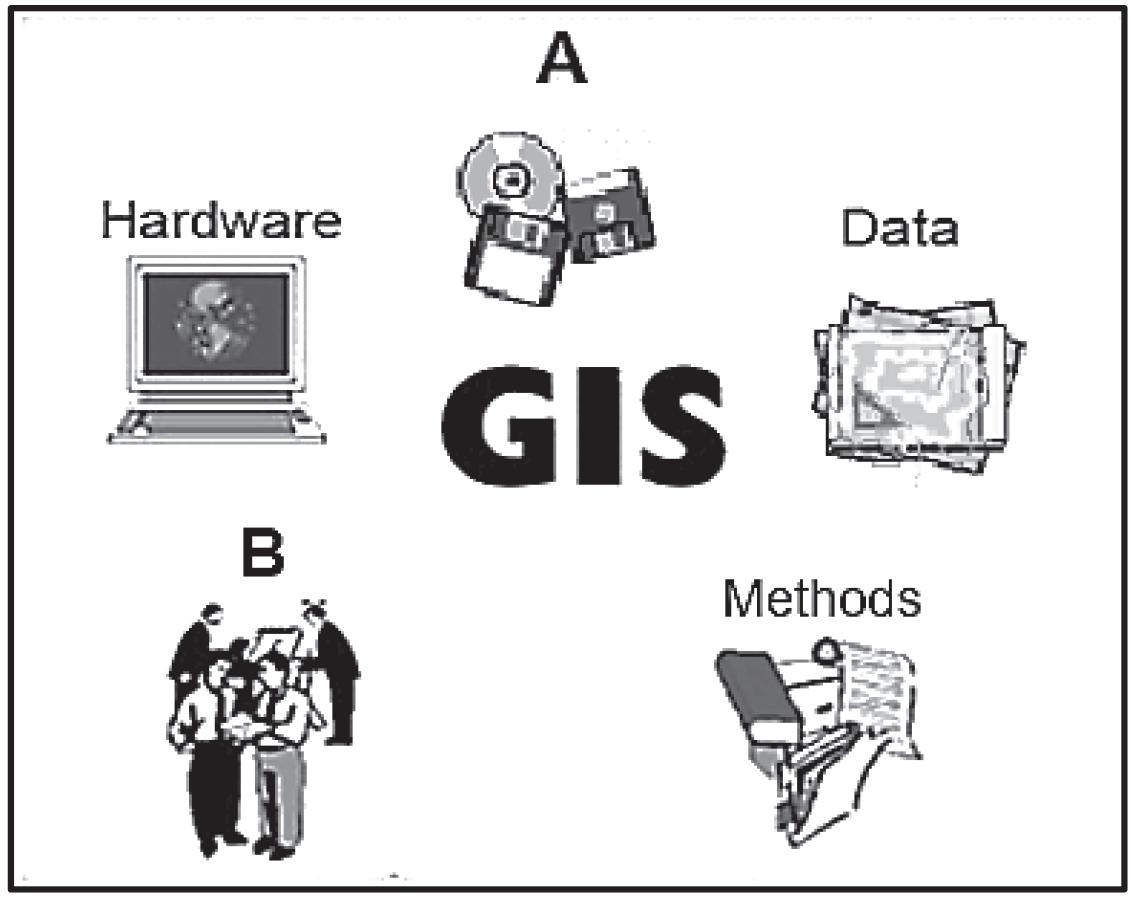

3.1.1 The general trend of the change in temperature from P to Q is (increasing/decreasing).
(1 x 1) (1)
3.1.2 Give a reason from the topographic map to explain the difference in temperature at P and Q
(1 x 2) (2)
3.1.3 Identify and explain ONE strategy that could be implemented by the local municipality in block I10







(1 + 2) (3)
3.2 Refer to the river system in block C7
3.2.1 Identify the drainage pattern of the river system in block C7
(1 x 1) (1)
3.2.2 State the underlying rock structure associated with the drainage pattern identified in QUESTION 3.2.1.
(1 x 1) (1)
3.2.3 Determine the stream order of the river system at point R (1 x 2) (2)
3.3 Refer to the stream flowing southwards in block G4
3.3.1 In which stage of the fluvial cycle is the stream in block G4?
(1 x 1) (1)
3.3.2 Give ONE piece of evidence from block G4 to support your answer to QUESTION 3.3.1.
3.4 Refer to blocks C10 and G7 on the topographic map.

3.4.1
block G7
the street plans (patterns) at S
block C10
(1 x 1) (1)
4.1.1 Identify the components A and B

4.1.2 Why is component B important in GIS processes?

(2 x 1) (2)
(1 x 2) (2)
4.2 Two locations (blocks F10 and H7 on the topographic map) have been identified for the development of a new cemetery. A GIS specialist has been appointed by the local municipality to recommend the best site for this development.
4.2.1 Which of the TWO locations (block F10 or block H7) will be most suitable for the development of the new cemetery?
(1 x 1) (1)
4.2.2 Identify TWO data layers that can be used in deciding on the new location for the cemetery.
(2 x 1) (2)
4.2.3 Give a reason for your choice of ONE of the data layers identified in QUESTION 4.2.2.


(1 x 2) (2)

23 The official papers in this supplement have been published with the endorsement of the Department of Basic Education. For more Matric Questions and Memoranda go to https://www.education.gov.za/ A PROUD BRAND OF
Identify
in
and at T in
Street plan S: _________________________________________ Street plan T: _________________________________________ (2 x 1) (2



















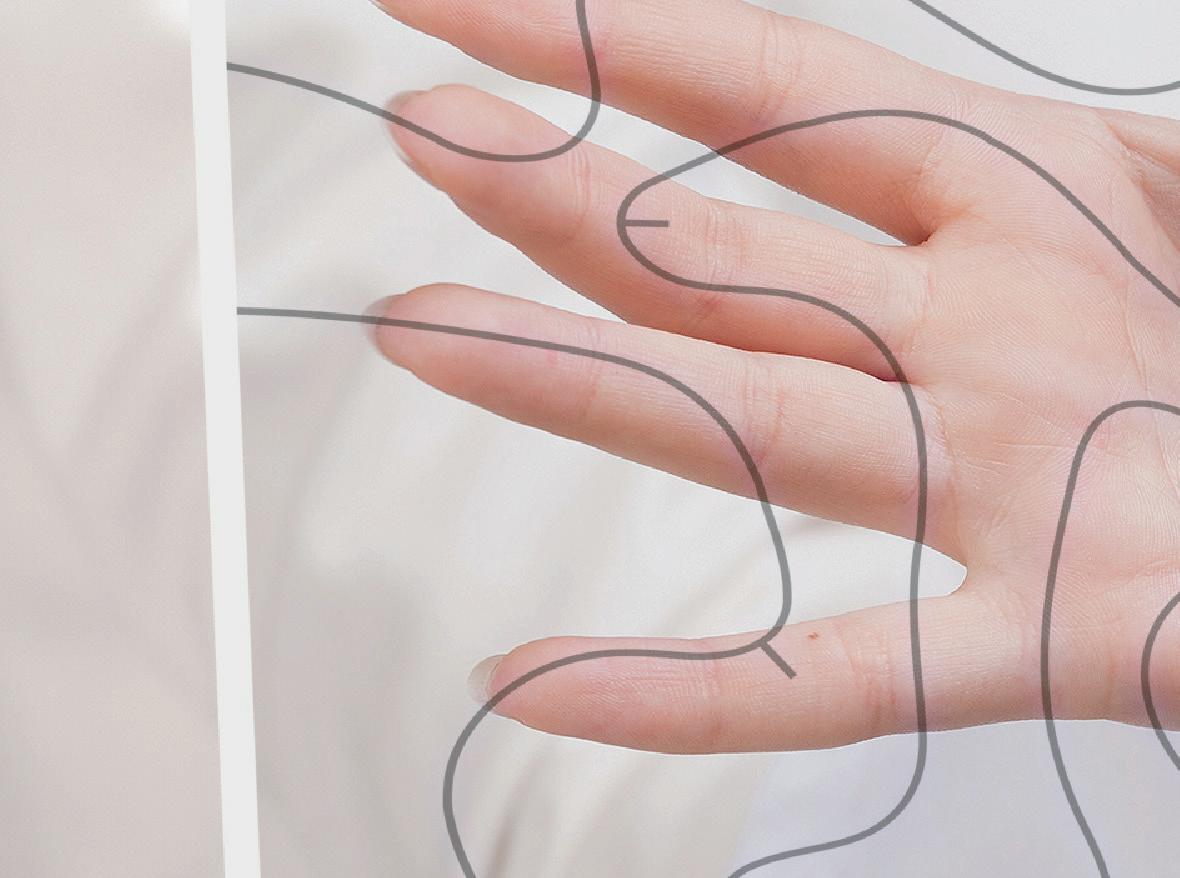

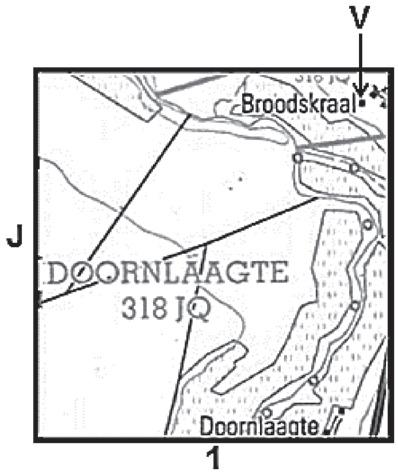




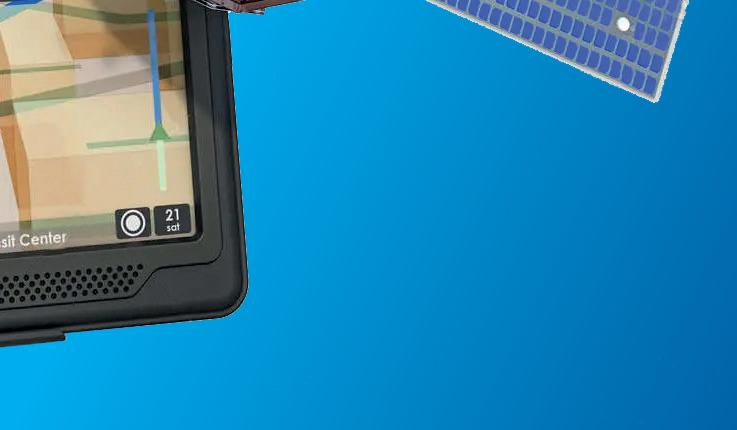

The official papers in this supplement have been published with the endorsement of the Department of Basic Education. For more Matric Questions and Memoranda go to https://www.education.gov.za/ GEOGRAPHYMatric Q&A 24 4.3 Refer to block J1 on the topographic map. 4.3.1 What is vector data? (1 x 1) (1) 4.3.2 Give ONE natural line feature that the farmer used to determine the site of the cultivated land in block J1 4.3.3 Agricultural activity in block J1 on the topographic map is confined along the river. (a) Draw the symbol of the point feature that is used to extract ground water to increase water supply for agriculture, on the enlarged illustration of block J1 below. This feature must be 40 mm southwest of the Broodskraal settlement ( (2 x 1) (2) (b) Explain the advantage of this specific location of the point feature drawn in QUESTION 4.3.3(a) for farming in the (1 x 2) (2) [15] TOTAL: 75
1
QUESTION 2: MAP CALCULATIONS AND TECHNIQUES

2.1 Refer to the hiking trail in blocks A5 and B5 on the topographic map.

2.1.1 Determine the 2020 magnetic bearing (MB) of the hiking trail from M to N in blocks A5 and B5, if the updated mean magnetic declination (MD) is 17°40' west of true north. Show ALL calculations.
Formula:

will be awarded for calculations.
Magnetic bearing = true bearing + magnetic declination
Magnetic Bearing: 333º√ (332° – 334°) + 17º40' = 350º40'√ (range 349º40' to 351º40') (2 x 1) (2)

2.1.2 Explain why it is important to use the magnetic bearing instead of the true bearing to determine direction on topographic maps.
Desired destination will not be reached if the true bearing is used/To reach desired destination √
The magnetic north changes annually √ Magnetic bearing gives you correct/accurate direction √ (ANY ONE) (1 x 1) (1)
2.2 Refer to the orthophoto map and answer the questions on gradient.

2.2.1 Determine the average gradient of the slope for a truck that will transport its cargo (goods) from the industries at 3 (1 160 m above sea level) to the railway station at 4 (1 148 m above sea level) on the orthophoto map. Show ALL calculations. Marks will be awarded for calculations.
Vertical interval: 1 160 – 1 148 = 12√m

Horizontal equivalent: 16,4√cm x 100 (range: 16,3 to 16,9)

1 640 √ m (range: 1 630 to 1 690)


12 1640 √ (correct substitution)
1 136.7
OR
1 : 136,7√ (range: 1 : 135,8 to 140,8) (5 x 1) (5)




2.2.2 Fill in the correct values for X and Y in the space on the diagram below with regard to the answer to QUESTION 2.2.1.
(If candidate has a different answer at X in Q 2.2.1 but used that answer and correctly substituted it into X, marks should be allocated for the conceptual understanding) (2 x 1) (2)
2.2.3 Why will it be easy for the truck to transport its cargo over the calculated gradient?
The slope/gradient is gentle √ (1 x 1) (1)


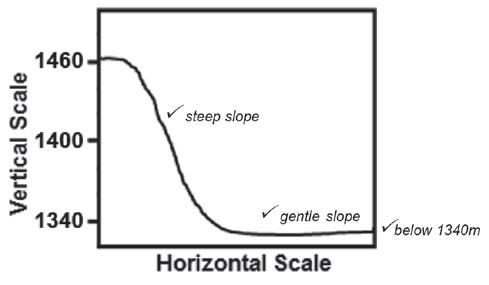


2.3 Refer to the line drawn from spot height 1461 in block C1 to the ruin at O in block C2 on the topographic map.
2.3.1 Complete the rough cross-section below from spot height 1461 in block C1 to the ruin at O in block C2 (3 x 1) (3)
2.3.2 Is the ruin at O in block C2 intervisible from spot height 1461 in block C1? Answer YES or NO. Give a reason for your answer. Yes OR No: No √
Reason: The convex slope √





There is an obstruction between O and spot height 1461 √ (ANY ONE) (1 + 1) (2)

2.3.3 Calculate the vertical exaggeration (VE) of the cross-section between spot height 1461 in block C1 and the ruin at O in block C2 if the vertical scale is 1 cm represents 20 m.
Show ALL calculations. Marks will be awarded for calculation Show ALL calculations. Marks will be awarded for calculations.
25 The official papers in this supplement have been published with the endorsement of the Department of Basic Education. For more Matric Questions and Memoranda go to https://www.education.gov.za/ A PROUD BRAND OF QUESTION
1.1 C (1) 1.2 A (1) 1.3 B (1) 1.4 D (1) 1.5 B (1) 1.6 C (1) 1.7 A (1) 1.8 B (1) 1.9 D (1) 1.10 D (1) 1.11 C (1) 1.12 A (1) 1.13 C (1) 1.14 C (1) 1.15 C (1) (15 x 1)(15)
Marks
VS = 1:2000 √ HS = 1:50 000 √ VE = 1:2 000 1:50 000 √ OR 1 2 000 1 50 000 1 2 000 x 50 000 1 25 times √ (4x1) (4) [20] MEMO PAPER 2
Matric Q&A

QUESTION 3: APPLICATION AND INTERPRETATION
GEOGRAPHY
3.1 The temperature graph below illustrates the general temperature change during the day from spot height 1614 (P) in block I6 to the technical college (Q) in block I10 on the topographic map.
3.3 Refer to the stream flowing southwards in block G4
3.3.1 In which stage of the fluvial cycle is the stream in block G4?
Upper course √ (Young/Youthful/Torrent stage) (1 x 1) (1)


3.3.2 Give ONE piece of evidence from block G4 to support your answer to QUESTION 3.3.1.
Contour lines point to the highest value indicating a steep sloped valley √

Magaliesberg/contour lines close together/steep slopes/ mountainous area √
Short non-perennial stream/1st order stream √

Straight stream √
Close to source √
(ANY ONE) (1 x 1) (1)
3.4
3.1.1 The general trend of the change in temperature from P to Q is increasing/decreasing)
Increasing √ (1 x 1) (1)
3.1.2 Give a reason from the topographic map to explain the difference in temperature at P and Q
The built-up area at Q absorbs more heat than the natural area at P √ √
The natural area at P absorbs less heat than the built-up area at Q √ √
The area at P is at a higher altitude therefore lower temperatures are experienced √ √ (ANY ONE) (1 x 2) (2)
3.1.3 Identify and explain ONE strategy that could be implemented by the local municipality in block I10.






Identification Explanation
Green belt/Recreational area/sports field√ (roof top gardens)

Plants/vegetation absorb a lot of heat for photosynthesis √ √
Vegetation absorb a lot of greenhouse gases/carbon dioxide √ √
Reflective paint colours √ Surface with high albedo reflects more heat so they stay cool. √ √
Public transportation √ Reduce the number of vehicles √ √
Water sources √ Water reduces temperature √ √ Green energy √ Energy saving strategies e.g. solar energy, bio mass energy √ √

Legislation √ Give laws and fines for excessive release of pollution √ √
[ANY ONE] (1 x 1) (1) [ANY ONE] (1 x 2) (2)
3.2 Refer to the river system in block C7
3.2.1 Identify the drainage pattern of the river system in block C7 Dendritic pattern √ (1 x 1) (1)
3.2.2 State the underlying rock structure associated with the drainage pattern identified in QUESTION 3.2.1.
Uniform/homogeneous/similar resistant rock structure √ [Not examples] (1 x 1) (1)
3.2.3 Determine the stream order of the river system at point R 3rd √ √ (order) (1 x 2)
Refer to blocks C10 and G7 on the topographic map.
3.4.1 Identify the street plans (patterns) at S in block C10 and at T in block G7
Street plan S: Radial √
Street plan T: Irregular √ (2 x 1) (2)

3.4.2 State TWO advantages of street plan (pattern) T in block G7
Street plan T: Smooth flow of traffic/fewer intersections √
Not monotonous/not boring/interesting suburb layout √
It accommodates steep slopes √
Saves time √
Saves fuel √
Not easy to hijack √
Fewer accidents √
Less road rage √
Less noise/air pollution √
Aesthetic appeal √ (ANY TWO) (2)
3.4.3 Give evidence from the topographic map for the development of the street plan (pattern) at T
Accommodates the steep gradient/slope √ √ (1 x 2) (2)

3.5 Refer to the mining activities of Townlands Platinum Mines on the orthophoto map and topographic map.
3.5.1 Give ONE reason evident on the topographic map that indicates that mining at Townlands Platinum Mines is practised on a large scale.
Occupies a large area √
Service lines √
Mine dumps √

Slimes dams √
Power lines √
Conveyor belt √
Shafts √
Roads/railway line √
Excavations √
Canals/pipelines/reservoirs √

Diggings √
(ANY ONE) (1 x 1)(1)
The official papers in this supplement have been published with the endorsement of the Department of Basic Education. For more Matric Questions and Memoranda go to https://www.education.gov.za/
26
(2)
3.5.2 Explain how mining activities
an environmental

Biodiversity is disturbed
Decrease/removal of natural
Increases soil erosion

The occurrence of slimes

Ecosystems are disturbed
Townlands
4.2 Two locations (blocks F10 and H7 on the topographic map) have been identified for the development of a new cemetery. A GIS specialist has been appointed by the local municipality to recommend the best site for this development.
4.2.1
Aesthetic disturbance (no aesthetic beauty)

Air/water/land pollution/acid

Noise pollution increases
Acid mine drainage increases
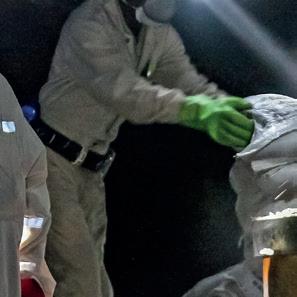

Increases land despoliation/scarring/land
ONE-MUST BE A QUALIFIED INJUSTICE)
3.5.3 Discuss the positive impact that Townlands Platinum Mines

on the economic development of Rustenburg.
It provides job opportunities to the surrounding community


It provides/develops/improves the infrastructure
example of different types of infrastructure,
supply, railway, etc.
It brings business and investment opportunities to Rustenburg town
Multiplier effect on all sectors (accept qualified examples)
Increased earnings stimulate trade in local market and increases buying power
Local authorities improve service delivery






Sector education training authorities (SETA) enable skills development to local population for employment in mines

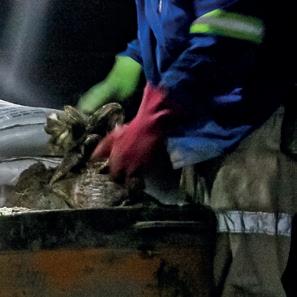

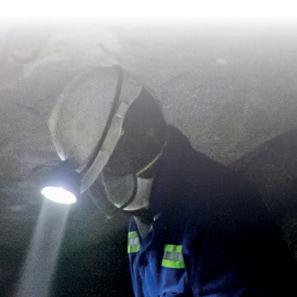

Increases foreign exchange may be linked to the point on investments

TWO)

QUESTION 4: GEOGRAPHICAL INFORMATION SYSTEMS (GIS)
4.1 COMPONENTS OF GIS
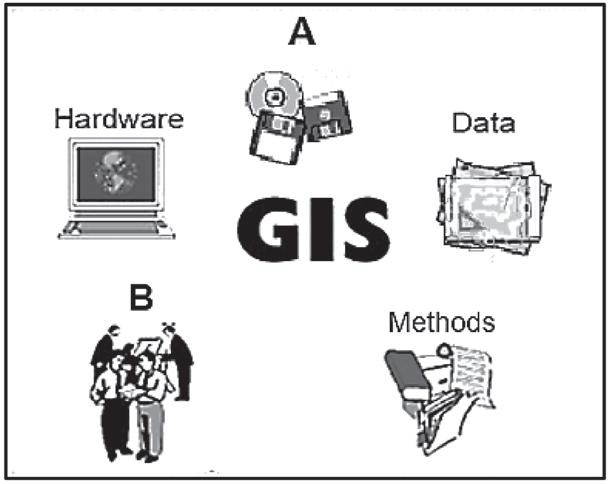


4.1.1
of the TWO locations (block F10 or block H7) will be most suitable for the development of the new cemetery?
F 10 √ (1 x 1) (1)

4.2.2 Identify TWO data layers that can be used in deciding on the new location for the cemetery.
Infrastructure √
Relief/topography √
Drainage √
Land use √
Geology √
Soil √
Vegetation √ (ANY TWO- NO EXAMPLES ACCEPTED) (2 x 1) (2)
4.2.3 Give a reason for your choice of ONE of the data layers identified in QUESTION 4.2.2.



LINK Infrastructure: Easy access to the cemetery √ √
Relief: Flat land makes it cheaper and easier to dig graves √ √
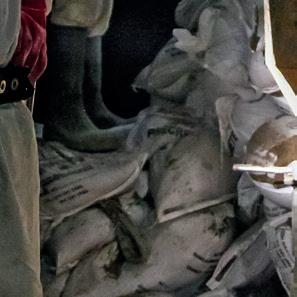
Drainage: Access to water supply /Level of water table √ √
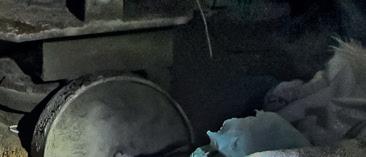

Land use: Away from areas that could create noise/to determine compatibility with the surroundings √ √
Geology: Stability of area √ √
Soil: Soft deep soil makes it easy to dig graves. √ √
Vegetation: Lack of natural vegetation √ √ (ANY ONE) (1 x 2) (2)

27 The official papers in this supplement have been published with the endorsement of the Department of Basic Education. For more Matric Questions and Memoranda go to https://www.education.gov.za/ A PROUD BRAND OF
at
Platinum Mines caused
injustice in the area.
√ √
vegetation √ √
√ √
dams √ √
√ √
√ √
rain increases √ √
√ √
√ √
degradation/sinkholes √ √ (ANY
(1 x 2) (2)
has
√ √
√ √ (accept
e.g. road, power
√ √)
√ √
√ √
√ √
√ √
√ √
√ √ (ANY
(2 x 2) (4) [25]
Identify the components A and B A: Software √ B: People/Personnel √ (2 x 1) (2) 4.1.2 Why is component B important in GIS processes? People collect/capture/store/manipulate/retrieve/analyse/ make decisions of geographic data √ √ [Accept examples] (ANY ONE) (1 x 2) (2)
Which























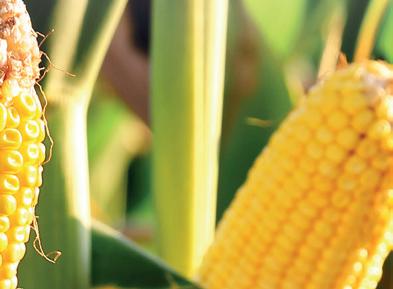


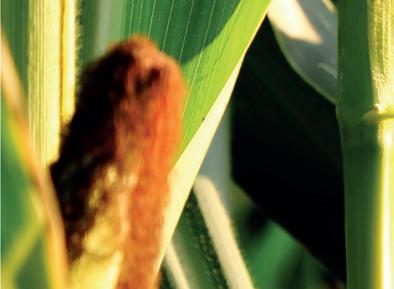




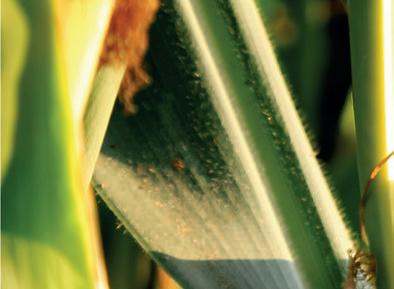
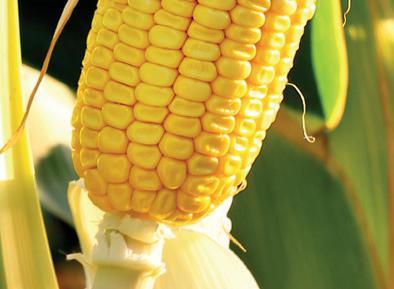




The official papers in this supplement have been published with the endorsement of the Department of Basic Education. For more Matric Questions
and
Memoranda go to https://www.education.gov.za/ GEOGRAPHYMatric Q&A 28 4.3 Refer to block J1 on the topographic map. 4.3.1 What is vector data? Vector data is when spatial objects are represented by points, lines and polygons (areas) √ (CONCEPT) (1 x 1) (1) 4.3.2 Give ONE natural line feature that the farmer used to determine the site of the cultivated land in block J1 River/non-perennial river/perennial river/stream √ (1 x 1) (1) 4.3.3 Agricultural activity in block J1 on the topographic map is confined along the river. (a) Draw the symbol of the point feature that is used to extract ground water to increase water supply for agriculture, on the enlarged illustration of block J1 below. This feature must be 40 mm southwest of the Broodskraal settlement (V). (b) Explain the advantage of this specific location of the point feature drawn in QUESTION 4.3.3(a) for farming in the area. Cultivation can take place away from the river √ √ It is centrally located for accessibility to water supply √ √ Water table is close to surface therefore constant water supply √ √ Cultivated land can be extended √ √ (ANY ONE) (1 x 2) (2) [15] TOTAL: 75 Accept 1 mark for the symbol Accept 1 mark for the location (circle indicates the accepted range) (2 x 1) (2)





















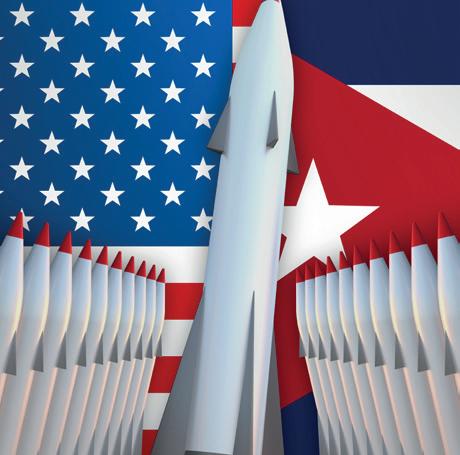

29 The official papers in this supplement have been published with the endorsement of the Department of Basic Education. For more Matric Questions and Memoranda go to https://www.education.gov.za/ A PROUD BRAND OF INSTRUCTIONS AND INFORMATION 1. This question paper consists of SECTION A and SECTION B based on the prescribed content framework in the CAPS document. SECTION A: SOURCE-BASED QUESTIONS QUESTION 1: THE COLD WAR: CONTAINMENT AND BRINKMANSHIP: THE CUBAN MISSILE CRISIS QUESTION 2: INDEPENDENT AFRICA: CASE STUDY – ANGOLA QUESTION 3: CIVIL SOCIETY PROTESTS FROM THE 1950s TO THE 1970s: THE BLACK POWER MOVEMENT SECTION B: ESSAY QUESTIONS QUESTION 4: CASE STUDY – CHINA QUESTION 5: INDEPENDENT AFRICA: COMPARATIVE CASE STUDY – THE CONGO AND TANZANIA QUESTION 6: CIVIL SOCIETY PROTESTS FROM THE 1950s TO THE 1970s: THE CIVIL RIGHTS MOVEMENT 2. SECTION A consists of THREE source-based questions. Source material that is required to answer these questions are provided here but in your exam they will be found in the ADDENDUM. 3. SECTION B consists of THREE essay questions. 4. Answer THREE questions as follows: 4.1 At least ONE must be a source-based question and at least ONE must be an essay question. 4.2 The THIRD question may be either a source-based question or an essay question. 5. You are advised to spend ONE hour per question. 6. When answering the questions, you should apply your knowledge, skills and insight. 7. You will be disadvantaged by merely rewriting the sources as answers. 8. Number the answers correctly according to the numbering system used in this question paper. 9. Write neatly and legibly. Paper 1
Matric Q&A


SECTION A: SOURCE-BASED QUESTIONS
HISTORY
1.2 Read Source 1B.



Answer at least ONE question, but not more than TWO questions, in this section.
QUESTION 1: HOW DID THE SOVIET UNION AND THE UNITED STATES OF AMERICA CONTRIBUTE TO COLD WAR TENSIONS IN CUBA IN THE 1960s?

Study Sources 1A, 1B, 1C and 1D and answer the questions that follow.

1.1 Use Source 1A.
1.2.1 According to the source, what resources did Khrushchev supply to Cuba? (2 x 1) (2)
1.2.2 Explain why Khrushchev stated that 'the armaments and military equipment sent to Cuba are designed exclusively for defensive purposes'. (1 x 2) (2)

1.2.3 Comment on what Khrushchev implied by the statement 'Threats and blackmail are an integral part of the imperialist states' in the context of the Cold War in Cuba.' (2 x 2) (4)
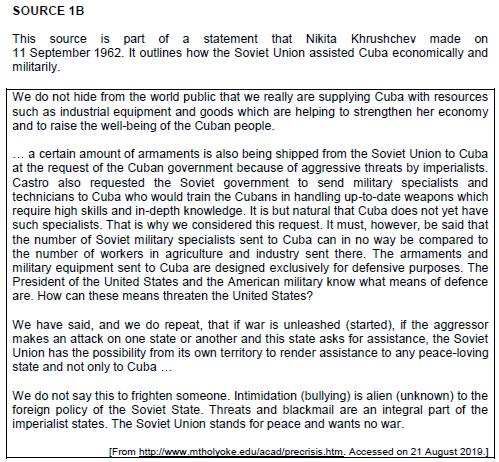
1.3 Study Source 1C.
1.1.1 Why, according to the source, did Castro have a close relationship with Khrushchev? (1 x 2) (2)
1.1.2 Define the concept communism in your own words. (1 x 2) (2)


1.1.3 Explain what is implied by the statement, 'Khrushchev and the Soviets couldn't have asked for a better-located ally (friend) against the United States of America (USA)', in the context of the Cuban Missile Crisis. (2 x 2) (4)
1.1.4 What, according to the source, was the outcome of the battle at the Bay of Pigs for the following countries:
(a) The USA (1 x 1) (1)


(b) Cuba (1 x 1) (1)
1.3.1

According to the source, why was Kennedy concerned about the Soviet Union's presence in Cuba? (1 x 2) (2)

1.3.2 Explain what you think prompted Kennedy to inform the American public about the deployment of Soviet military equipment to Cuba. (2 x 2) (4)

1.3.3 Quote FOUR challenges from the source that communism posed to the world. (4 x 1) (4)



The official papers in this supplement have
been
published
with the endorsement of the Department of Basic Education. For more Matric Questions and Memoranda go to https://www.education.gov.za/
30
1.3.4 Using the information in the source and your own knowledge, explain the limitations of this source to a historian researching the Cuban Missile Crisis. (2 x 2) (4)
1.4 Consult Source 1D.


1.4.1 Explain why you think this article was published on the front page of The Arizona Republic (1 x 2) (2)
1.4.2 Comment on the newspaper headline 'U.S. BLOCKADES CUBA, TELLS RUSS "LAY OFF" ' in the context of the Cuban Missile Crisis. (2 x 2) (4)


1.5 Refer to Sources 1C and 1D. Explain how the information in Source 1C supports the evidence in Source 1D regarding Kennedy's response to the deployment of Soviet missiles to Cuba. (2 x 2) (4)
1.6 Using the information in the relevant sources and your own knowledge, write a paragraph of about EIGHT lines (about 80 words) explaining how the Soviet Union and the United States of America contributed to Cold War tensions in Cuba in the 1960s. (8) [50]


QUESTION 2: WHAT IMPACT DID THE BATTLE OF CUITO CUANAVALE HAVE ON SOUTH AFRICA AND CUBA?
Study Sources 2A, 2B, 2C and 2D and answer the questions that follow.


2.1 Read Source 2A.











2.1.1 Why did the SADF launch a major attack in south-eastern Angola in 1987, according to the source? (2 x 1) (2)
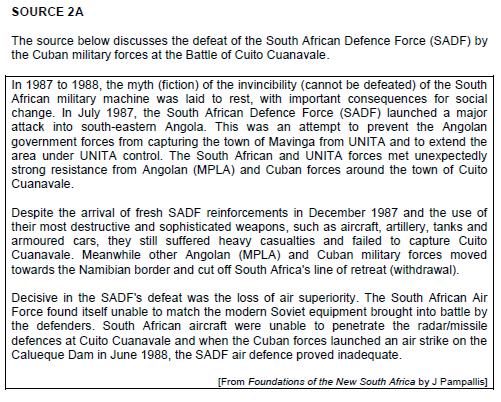
2.1.2
2.1.3
Identify TWO military forces in the source that 'moved towards the Namibian border and cut off South Africa's line of retreat.' (2 x 1) (2)
Using the information in the source and your own knowledge, comment on why the SADF's air wing failed to defeat the Cuban airforce. (2 x 2) (4)
2.2 Study Source 2B.
2.2.1 List THREE reasons in the source that prompted South Africa to leave Cuito Cuanavale. (3 x 1) (3)
2.2.2 According to the source, who was the leader of South Africa during the Battle of Cuito Cuanavale? (1 x 1) (1)
2.2.3 Quote evidence from the source that suggests that the President of South Africa and his advisors accepted a truce. (2 x 1) (2)
2.2.4 Explain what you think is implied by the statement, 'Crocker's long fight was over, his goal of brokering (negotiating) regional peace deal was realised at last' in the context of the Battle of Cuito Cuanvale. (2 x 2) (4)
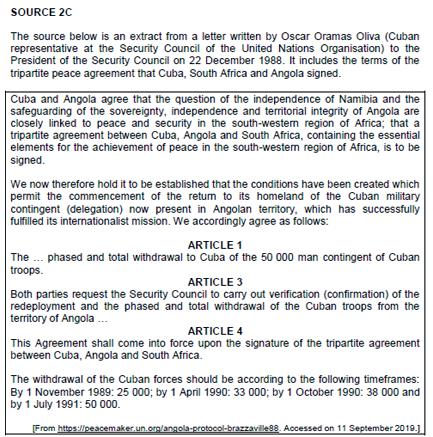
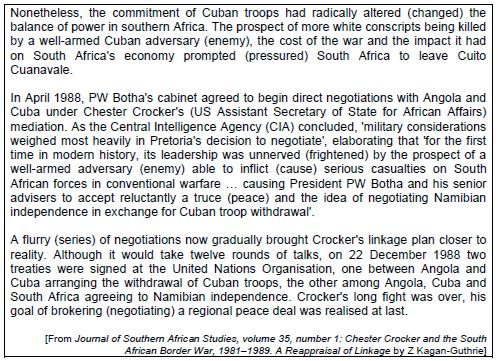
2.3 Consult Source 2C.

31 The official papers in this supplement have been published with the endorsement of the Department of Basic Education. For more Matric Questions and Memoranda go to https://www.education.gov.za/ A PROUD BRAND OF
Matric Q&A

HISTORY
2.3.1 Which TWO issues, according to the source, were closely linked to the peace and security of the south-western region of Africa? (2 x 1) (2)


2.3.2 Define the concept independence in the context of Angola. (1 x 2) (2)



2.3.3 Explain what Oliva implied by the statement, 'the Cuban military contingent (delegation) has successfully fulfilled its internationalist mission'. (2 x 2) (4)

2.3.4 Comment on the role that the United Nations Organisation played during the peace negotiations in Angola. (2 x 2) (4)


2.4 Use Source 2D.

2.4.1 Explain the messages that are conveyed in the photograph. (2 x 2) (4)


2.4.2 Comment on the usefulness of this source to a historian researching the outcome of the Battle of Cuito Cuanavale. (2 x 2) (4)
2.5 Refer to Sources 2C and 2D. Explain how the information in Source 2C supports the evidence in Source 2D regarding Cuba's role in the Angolan Civil War. (2 x 2) (4)
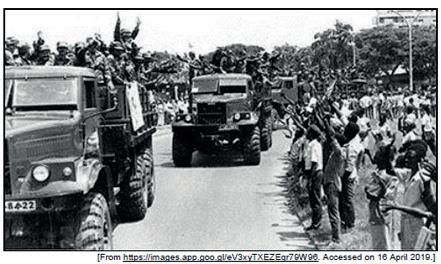
2.6 Using the information in the relevant sources and your own knowledge, write a paragraph of about EIGHT lines (about 80 words) explaining the impact that the Battle of Cuito Cuanavale had on South Africa and Cuba. (8) [50]

QUESTION 3: WHAT PROGRAMMES DID THE BLACK PANTHER PARTY IMPLEMENT IN THE UNITED STATES OF AMERICA IN THE 1960s?
Study Sources 3A, 3B, 3C and 3D and answer the questions that follow.

3.1 Read Source 3A.


3.1.1 List THREE community programmes in the source that the Black Panther Party organised for African Americans.
3.1.2
(3 x 1) (3)
According to the source, what were the TWO strategies that the Black Panther Party used to help poverty-stricken African Americans?
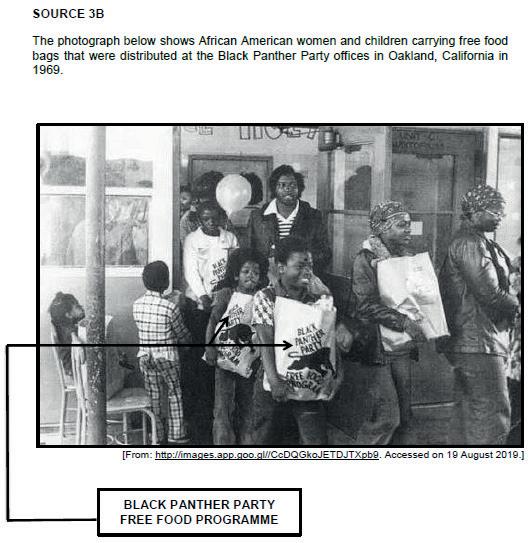
(2 x 1) (2)
3.1.3 Explain what the Black Panther Party implied by 'A reform programme is set up by the existing exploitative system as an appeasing hand-out, to fool the people and to keep them quiet...' (2 x 2) (4)
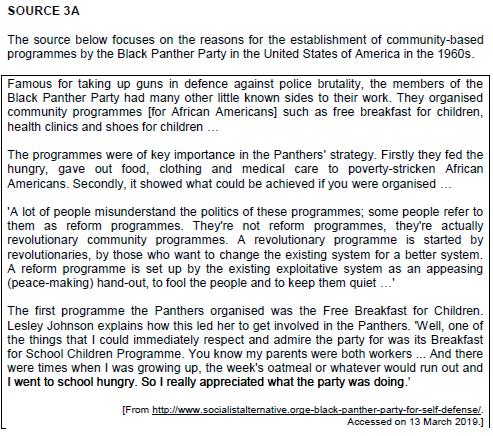
3.1.4 Comment on the impact that the Free Breakfast Programme had on African American children. (2 x 2) (4)
3.2 Consult Source 3B.
3.2.1 Explain the messages that are conveyed in the photograph.
(2 x 2) (4)
The
official papers in this supplement
have been published with the endorsement of the Department of Basic Education. For more Matric Questions and Memoranda go to https://www.education.gov.za/
32
3.2.2 Using the information in the source and your own knowledge, comment on the usefulness of this source for a historian studying the programmes of the Black Panther Party.
(2 x 2) (4)
3.3 Study Sources 3A and 3B. Explain how the information in Source 3A supports the evidence in Source 3B regarding the programmes of the Black Panther Party.
(2 x 2) (4)
3.4 Refer to Source 3C.


3.4.1 According to Ericka Huggins, what should the city of Oakland do to uplift the lives of African Americans?
3.5.1 State TWO ways in the source in which the FBI agents destroyed the programmes of the Black Panther Party.
(2 x 1) (2)
3.5.2 Define the concept black nationalism in your own words.
(1 x 2) (2)
3.5.3 Using the information in the source and your own knowledge, explain why the Black Panther Party's School Breakfast Programme was allowed to operate on a permanent basis in 1975. (2 x 2) (4)

3.6 Using the information in the relevant sources and your own knowledge, write a paragraph of about EIGHT lines (about 80 words) explaining the programmes that the Black Panther Party implemented in the United States of America in the 1960s. (8) [50]
SECTION B: ESSAY QUESTIONS
Answer at least ONE question, but not more than TWO questions from this SECTION.
Your essay should be about THREE pages long.
QUESTION 4: CASE STUDY – CHINA


Chairman Mao Zedong introduced the Third Five-Year Plan (Cultural Revolution) to address the challenges that ordinary Chinese experienced during the implementation of the Second Five-Year Plan (Great Leap Forward).

Do you agree with this statement? Use relevant evidence to support your line of argument. [50]
QUESTION 5: INDEPENDENT AFRICA: COMPARATIVE CASE STUDY –THE CONGO AND TANZANIA










Critically discuss the social and economic policies that Mobutu Sese Seko (the Congo) and Julius Nyerere (Tanzania) implemented in their respective countries after attaining independence in the 1960s. [50]
(3 x 1) (3)
3.4.2 Explain what Ericka Huggins implied by saying that Oakland Community School 'serve children who have been labelled "educationally disadvantaged", "economically deprived" and "uneducable'' '. (2 x 2) (4)

3.4.3 Why, according to the source, was the Inter-communal Youth Institute established?
(1 x 2) (2)
QUESTION 6: CIVIL SOCIETY PROTESTS FROM THE 1950s TO THE 1970s: THE CIVIL RIGHTS MOVEMENT

Explain to what extent the various forms of protests by the Civil Rights Movement led to an improvement of the lives of ordinary African Americans in the United States of America in the 1960s.
Support your line of argument with relevant evidence. [50]
TOTAL: 150
3.5 Use Source 3D.



33
The official papers in this supplement have been published with the endorsement of the Department of Basic Education. For more Matric Questions and Memoranda go to https://www.education.gov.za/
A PROUD BRAND OF
Matric Q&A
HISTORY
SOURCE-BASED QUESTIONS
In the marking of source-based questions, learners should be credited for any other valid and relevant viewpoints, arguments, evidence or examples.
Learners are expected to take a stance when answering ‘to what extent’ questions in order for any marks to be awarded.
Paragraph questions
Paragraphs are to be assessed globally (holistically). Both the content (relevant evidence) and structure of the paragraph must be taken into account when awarding a mark.
ESSAY QUESTIONS
The essay questions require candidates to be able to select, organise and connect the relevant information so that they are able to present a reasonable sequence of facts or an effective argument to answer the question posed.
It is essential that an essay has an introduction, a coherent and balanced body of evidence and a conclusion.
Assessment of the essay
The essay will be assessed holistically (globally) rather than assessing the main points separately. This approach encourages the learner to write an original argument by using relevant evidence to support the line of argument.
The learner will not be required to simply regurgitate content (facts) in order to achieve a level 7 (high mark). This approach discourages learners from preparing essays and reproducing them without taking the specific requirements of the question into account. Holistic marking of the essay credits learners’ opinions that are supported by evidence and does not penalise language inadequacies, as the emphasis is on the following:
• The learner’s interpretation of the question.
• The appropriate selection of factual evidence (relevant content selection).
• The construction of an argument (planned, structured and has an independent line of argument).


Keep the synopsis in mind when writing the essay.
Also, keep the PEEL structure in mind:
• Point: The candidate introduces the essay by taking a line of argument/ making a major point. Each paragraph should include a point that sustains the major point (line of argument) that was made in the introduction.
• Explanation: The candidate should explain in more detail what the main point is about and how it relates to the question posed (line of argument).
• Example: The candidates should answer the question by selecting content that is relevant to the line of argument. Relevant examples should be given to sustain the line of argument.
• Link: Candidates should ensure that the line of argument is sustained throughout the essay and is written coherently.



It is very important to write as neatly and legibly as possible to make your work easy to mark.




official
SECTION A: SOURCE-BASED QUESTIONS
QUESTION 1: HOW DID THE SOVIET UNION AND THE UNITED STATES OF AMERICA CONTRIBUTE TO COLD WAR TENSIONS IN CUBA IN THE 1960s?
1.1 1.1.1 [Extraction of evidence from Source 1A – L1]
• 'Because of his support and friendship' (1 x 2)(2)
1.1.2 [Definition of a historical concept in Source 1A – L1]



• An ideology that advocated a classless society, where private ownership is prohibited

• An ideology that supported the nationalisation of all land, industries and banks (i.e. the state owns the means of production)
• Any other relevant response (any 1 x 2)(2) 1.1.3 [Interpretation of evidence in Source 1A – L2]
• Cuba was in close proximity to the USA and therefore posed a threat to the safety of the USA.
• It gave Khrushchev a vantage point to counteract the USA's placement of missiles in Turkey/to restore the balance of power
• Any other relevant response (2 x 2)(4) 1.1.4 [Extraction of evidence from Source 1A – L1]
(a)


• ‘Disaster’
• ‘Defeat of the US-sponsored rebels’
• 'Embarrassment for Kennedy's administration' (any 1 x 1)(1) (b)
• ‘Castro and his army quickly defeated the US-sponsored rebels’
• 'Helped to solidify (strengthen) Cuba's alliance with the Soviet Union' (any 1 x 1)(1) 1.2 1.2.1 [Extraction of evidence from Source 1B – L1]
• 'industrial equipment and goods’

• ‘certain amount of armaments’
• ‘military specialists and technicians'



• ‘military equipment’ (any 2 x 1)(2) 1.2.2 [Interpretation of evidence in Source 1B – L2]






• To defend Cuba against American aggression
• To defend the ideology of communism in Cuba and Latin America
• To avert any suspicion that the Soviet Union may be the aggressor
• Any other relevant response (any 1 x 2)(2) 1.2.3 [Interpretation of evidence in Source 1B – L2]
• The USA and other capitalist countries were content by using threats (e.g. blockade) and intimidation tactics against smaller states in an attempt to get them to comply (to withdraw missiles) and be subservient
• The USA used their economic power to try and force Cuba to adhere to their economic policies
• Unlike the USA (aggressor), the Soviet Union stood for peace.
• Any other relevant response (any 2 x 2)(4)
this
The
papers in
supplement
have been
published
with the endorsement of the Department of Basic Education. For more Matric Questions and Memoranda go to https://www.education.gov.za/
34
MEMO PAPER 1
1.3 1.3.1 [Extraction of evidence from Source 1C – L1]
• ‘To bolster (strengthen) the military power of the Castro regime in Cuba'
• ‘The Soviets have provided the Cuban government with a number of anti-aircraft defence missiles with a range of twenty-five miles’
• ‘The Soviets are apparently providing the extensive radar (sensor) and other electronic equipment’

• ‘The presence of several Soviet-made motor torpedo boats’
1.3.2 [Interpretation of evidence in Source 1C – L2]
• To convince the Americans that he was in control of the situation
• To win support and ease the fears of the American public
• To inform the Americans about the steps he intended taking against the deployment of Soviet missiles to Cuba
• To make the public aware of a possible nuclear war
(any 1 x 2)(2)


1.5 [Comparison of evidence in Sources 1C and 1D to highlight similarities – L3]
• In Source 1C Kennedy promised to make information available to all Americans to keep them abreast of developments in Cuba which was communicated through a front-page newspaper article in Source 1D
• Source 1C states that the US government would use any means to stop Cuban and Soviet Union aggression against the Western Hemisphere and in Source 1D the US government used a blockade to stop the deployment of missiles to Cuba
• Both Sources 1C and 1D refer to the US government's reaction to the deployment of Soviet missiles to Cuba
• Any other relevant response (any 2 x 2)(4)
1.6 [Interpretation, evaluation and synthesis of evidence from relevant sources – L3]











Candidates could include the following aspects in their response:


• The Soviet Union supported Cuba after the USA had cut off economic and diplomatic ties with Cuba (Source 1A)
• Cuba's adoption of communism (Soviet Union) implied rejection of capitalism (USA) (own knowledge)
• The proximity of Soviet missiles in Cuba posed a threat to the security of the USA (Source 1A)
• Any other relevant response (any 2 x 2)(4)
1.3.3 [Extraction of evidence from Source 1C – L1]
A challenge to:
• 'democracy'
• 'peace'
• 'stability'
• 'prosperity' (4 x 1)(4)
1.3.4 [Ascertaining the limitations of Source 1C – L3]


• The source gives an American point of view/it's biased, justifying the USA's intentions
• The source is not dated
• The purpose of the source is to convince the public that the USA was defending democracy and freedom
• The source does not show how the USA contributed to the crisis in Cuba
• Any other relevant response (any 2 x 2)(4)
1.4 1.4.1 [Interpretation of evidence in Source 1D – L2]
• To inform the public how the USA intended to deal with the deployment of missiles to Cuba
• It was newsworthy because the public should be aware about the developments that affected the USA
• Any other relevant response (any 1 x 2)(2)
1.4.2 [Interpretation of evidence in Source 1D – L2]
• The USA imposed a blockade to stop the deployment of Soviet missiles to Cuba
• The USA warned the Soviet Union of harsh measures that it intended to take to prevent the spread of communism
• The USA demanded that the Soviet Union should 'LAY OFF' (leave) Cuba
• Any other relevant response (any 2 x 2)(4)
• The Battle of the Bay of Pigs, April 1961 widened the tensions between the USA and Cuba/Soviet Union (Source 1A)
• The Soviet Union supplied Cuba with armaments (Source 1B)
• The Soviet Union sent military specialists and technicians to train Cubans on how to handle sophisticated weapons (Source 1B)
• The Soviet Union regarded the threats and blackmail as an integral part of the USA's strategy (Source 1B)
• The USA was concerned and therefore started monitoring the movement of Soviet ships to Cuba (Source 1C)
• The USA showed readiness to confront the Cuban/Soviet Union military (Source 1C)
• The USA and the Soviet Union engaged in a game of brinkmanship which heightened Cold War tensions (own knowledge)
• The USA used the media (newspaper) to inform the American public about the action (blockade) it took against the deployment of Soviet missiles to Cuba (Source 1D)
• Any other relevant response
Use the following rubric to allocate marks:
LEVEL 1
LEVEL 2
• Uses evidence in an elementary manner e.g. shows no or little understanding of how the Soviet Union and the United States of America contributed to Cold War tensions in Cuba in the 1960s.
• Uses evidence partially or cannot write a paragraph.
• Evidence is mostly relevant and relates to a great extent on the topic e.g. shows some understanding of how the Soviet Union and the United States of America contributed to Cold War tensions in Cuba in the 1960s.
• Uses evidence in a very basic manner to write a paragraph.
MARKS
MARKS
LEVEL
• Uses relevant evidence e.g. demonstrates a thorough understanding of how the Soviet Union and the United States of America contributed to Cold War tensions in Cuba in the 1960s.
• Uses evidence very effectively in an organised paragraph that shows an understanding of the topic.
official
35 The
papers in this supplement have been published with the endorsement of the Department of Basic Education. For more Matric Questions and Memoranda go to https://www.education.gov.za/ A PROUD BRAND OF
0–2
3–5
3
MARKS 6–8 (8) [50]
Matric Q&A

HISTORY
QUESTION 2: WHAT IMPACT DID THE BATTLE OF CUITO CUANAVALE HAVE ON SOUTH AFRICA AND CUBA?
2.1 2.1.1 [Extraction of evidence from Source 2A – L1]
• 'To prevent Angolan government forces from capturing the town of Mavinga from UNITA'
• 'To extend the area under UNITA control' (2 x 1)(2)
2.1.2 [Extraction of evidence from Source 2A – L1]
• 'Angolan MPLA'
• 'Cuban forces' (2 x 1)(2)
2.1.3 [Interpretation of evidence in Source 2A – L2]
• The MPLA and Cuban forces were strategic and therefore successfully outmanoeuvred the SADF
• The Cuban air force was superior to the SADF's air wing
• The SADF's air wing did not have modern aircraft to challenge the Cuban air force
• Were unable to penetrate the radar/missile defences


• Any other relevant response (any 2 x 2)(4)
2.2 2.2.1. [Extraction of evidence from Source 2B – L1]
• 'More white conscripts being killed'
• 'The cost of the war'
• 'The impact it had on South Africa's economy' (3 x 1)(3)
2.2.2 [Extraction of evidence from Source 2B – L1]
• 'PW Botha' (1 x 1) (1)
2.2.3 [Extraction of evidence from Source 2B – L1]
• 'Military considerations weighed most heavily in Pretoria's decision to negotiate'
• 'Its leadership was unnerved (frightened) by the prospect of a well-armed adversary (enemy) able to inflict (cause) serious casualties on South African forces in conventional warfare' (2 x 1)(2)
2.2.4 [Interpretation of evidence in Source 2B – L2]
• After a number of years of war in Angola Chester Crocker was ultimately able to bring warring countries South Africa, Cuba and Angola to the negotiating table
• Chester Crocker was able to mediate peace between South Africa, Cuba and Angola by getting leaders to sign the tripartite agreement
• Any other relevant response (any 2 x 2)(4)
2.3 2.3.1 [Extraction of evidence from Source 2C – L1]
• 'Independence of Namibia'
• 'Safeguarding of the sovereignty, independence and territorial integrity of Angola' (2 x 1) (2)

2.3.2 [Definition of a historical concept in Source 2C – L1]


• The right of the people of Angola to govern themselves without foreign intervention
• Any other relevant response (any 1 x 2)(2)
2.3.3 [Interpretation of evidence in Source 2C – L2]
• Cuba safeguarded the independence of Angola
• Cuba ensured the independence of Namibia
• Cuba's mission to stop the SADF from overthrowing the MPLA was successful
• Cuba had achieved their practise of helping those in need
• Cuba succeeded in preventing the spread of capitalism

• Any other relevant response (any 2 x 2)(4)
2.3.4 [Interpretation of evidence in Source 2C – L2]
• The UNO had to get countries that were at war to come together so that peace could be achieved
• The UNO had to ensure that the articles as stipulated in the agreement were implemented


• The UNO attempted to bring peace to Angola
• Any other relevant response (any 2 x 2)(4)
2.4 2.4.1 [Interpretation of evidence in Source 2D – L2]
• It shows Cuban troops withdrawing from Angola after the Battle of Cuito Cuanavale
• It depicts Angolans showing their appreciation by waving their hands at the Cuban forces
• It shows that there were good relations between the Cubans and the Angolans
• It shows the Cuban forces leaving in a celebratory /happy manner
• Any other relevant response (2 x 2)(4)
2.4.2 [Ascertain the usefulness of Source 2D – L3]





The source is USEFUL because:
• It is a photograph that captured the withdrawal of Cuban troops from Angola
• The photograph is first-hand information that was taken at the time of the withdrawal (i.e. a primary source)
• The date of origin of the source relates to the timeframes of the official withdrawal of the Cuban troops from Angola
• It informs the world about the official withdrawal of Cuban troops from Angola
• The photograph gives insight into the role played by Cuba in Angola
• Any other relevant response (any 2 x 2)(4)
2.5 [Comparison of evidence in Sources 2C and 2D to highlight similarities – L3]
• Source 2C stipulates timeframes for the withdrawal of Cuban troops and Source 2D shows the implementation of the withdrawal of Cuban troops

• Source 2C states that conditions have been created which permitted the commencement of the return of the Cuban military contingent from Angola and Source 2D shows the actual withdrawal of the Cuban troops from Angola
• Source 2C states that Cuba successfully fulfilled its internationalist mission and Source 2D suggests that the Cubans are happy after they achieved their goal of defeating their enemies by leaving Angola
• Both Sources 2C and 2D show the Cuban military forces’ direct involvement in the Angolan civil war
• Any other relevant response (any 2 x 2)(4)
The official papers in this supplement have been published with the endorsement of the Department of Basic
Education.
For more
Matric Questions and
Memoranda go to https://www.education.gov.za/
36
2.6 [Interpretation, analysis and synthesis of evidence from relevant sources – L3]









Candidates could include the following in their response:
• South African and UNITA forces met strong resistance from Angolan (MPLA) and Cuban forces at Cuito Cuanavale and therefore was forced to sign a truce (Source 2A)
• The weaknesses of the South African Air Force were exposed (Source 2A)
• The cost of the war/loss of life in Angola forced South Africa (PW Botha) to negotiate for peace in the region (Source 2B)
• It led to a tripartite agreement between South Africa, Angola and Cuba under Chester Crocker's chairpersonship that led to peace in the south-western region of Africa (Source 2C)
• South Africa agreed to the Namibian independence (Sources 2B and 2C)
• Cuba contributed to the independence of Angola and Namibia, that brought peace in the southern Africa region (own knowledge)
• Cuba agreed to the withdrawal of troops from Angola (Source 2C)
• Cuban troops can be seen withdrawing from Angola (Source 2D)
• Any other relevant response
Use the following rubric to allocate marks:
LEVEL 1
LEVEL 2
• Uses evidence in an elementary manner e.g. shows no or little understanding of the impact that the Battle of Cuito Cuanavale had on South Africa and Cuba.
• Uses evidence partially or cannot write a paragraph.
• Evidence is mostly relevant and relates to a great extent on the topic e.g. shows some understanding of the impact that the Battle of Cuito Cuanavale had on South Africa and Cuba.
• Uses evidence in a very basic manner to write a paragraph.

• Uses relevant evidence e.g. demonstrates a thorough understanding of the impact that the Battle of Cuito Cuanavale had on South Africa and Cuba.
LEVEL 3
• Uses evidence very effectively in an organised paragraph that shows an understanding of the topic.
MARKS 0–2
MARKS 3–5
MARKS
• Was started by those who want to maintain control and ensure that status quo is maintained

• Did not necessarily bring about change to the lives of African Americans
• Would bring about only cosmetic changes to the lives of African Americans
• Would not empower African Americans to become independent and self sufficient
• Preferred a revolutionary programme than a reform programme
• Any other relevant response (any 2 x 2)(4)
3.1.4 [Interpretation of evidence in Source 3A – L2]
• African American children did not go to school hungry anymore/could concentrate in class
• African American children liked the Free Breakfast Prgramme
• It contributed to the development of selfesteem amongst African American children
• It motivated young African Americans to join the Black Panther Party
• Any other relevant response (any 2 x 2)(4)
3.2 3.2.1 [Interpretation of evidence in Source 3B – L2]
• It shows destitute African American women and children carrying bags of free food provided by the Black Panther Party
• It shows that the African American women and children appeared to be happy (facial expression)
• It depicts the success of the Black Panther Party's 'Free Food Programme'
• It shows the Black Panther Party's implementation of the philosophy of selfreliance
• Any other relevant response (any 2 x 2)(4) 3.2.2 [Ascertaining the usefulness of Source 3B – L3]




The source is USEFUL because:

• It is a photograph – taken at the time when community programmes of the Black Panther Party were active
QUESTION 3: WHAT PROGRAMMES DID THE BLACK PANTHER PARTY IMPLEMENT IN THE UNITED STATES OF AMERICA IN THE 1960s?
3.1 3.1.1 [Extraction of evidence from Source 3A – L1]
• 'Free breakfast for children'
• 'Health clinics'


• 'Shoes for children'
3.1.2 [Extraction of evidence from Source 3A – L1]
the hungry'
out food'
and medical
The Black Panther Party
1)
• The name of the Black Panther Party and its emblem shown on the carry bags to show ownership of the programme (showed that the programme was the brain child of the Black Panther Party)
• It shows the beneficiaries (African American women and children) receiving free food
• It shows the success of Black Panther Party survival programmes
• Any other relevant response (any 2 x 2)(4)
3.3 [Comparison of evidence in Sources 3A and 3B to highlight similarities - L3]
• Source 3A mentions that the Black Panther Party organised community programmes and Source 3B shows the African American families collecting food parcels from the Black Panther Party Free Food Programme
• Source 3A mentions the implementation of a better system for African American
37 The official papers in this supplement have been published with the endorsement of the Department of Basic Education. For more Matric Questions and Memoranda go to https://www.education.gov.za/ A PROUD BRAND OF
6–8 (8) [50]
(3 x
(3)
• 'Fed
• 'Gave
• 'Clothing
care to poverty-stricken African Americans' • ‘What could be achieved if you were organised’ (any 2 x 1)(2) 3.1.3 [Interpretation of evidence in Source 3A – L2]
implied that a reform programme:
Matric Q&A
communities and in Source 3B shows the children and women in a jovial mood
HISTORY
• Source 3A mentions a revolutionary programme that was started by leaders of the Black Panther Party and Source 3B the implementation of a revolutionary programme (Both Sources 3A and 3B outline the programmes of the Black Panther Party)
• Any other relevant response (any 2 x 2)(4)
3.4 3.4.1 [Extraction of evidence from Source 3C – L1]
Get things done
• ‘in education’
• ‘housing’
• ‘and the courts' (3 x 1)(3)
3.4.2 [Interpretation of evidence from Source 3C – L2]
• The Oakland Community School took pride in serving African American children
• African American children who attended the Oakland Community School came from disadvantaged backgrounds
• The school admitted children who were rejected by mainstream public or private schools
• The school offered a differentiated curriculum to accommodate all types of children
• Any other relevant response (any 2 x 2) (4)
3.4.3 [Extraction of evidence from Source 3C – L1]
• 'As a result of harassment that some children were getting in Oakland' (1 x 2)(2)
3.5 3.5.1 [Extraction of evidence from Source 3D – L1]
• 'FBI agents went door-to-door in cities like Richmond in Virginia, telling parents that members of the BPP would teach their children about Black Nationalism'
• 'Parents were told the food was infected with contagious (spreadable) disease' (2 x 1)(2)
3.5.2 [Definition of a historical concept in Source 3D – L1]



• An ideology wherein people of the same nation (Black) come together to practise their own language, culture, beliefs and want to be ruled by a person of the same nation
• Any other relevant answer (any 1 x 2)(2)
3.5.3 [Interpretation of evidence in Source 3D – L2]
• The Federal Government saw the success of the School Breakfast Programme and adopted it in 1975
• The School Breakfast Programme was later expanded to communities that were impoverished in the USA
• The School Breakfast Programme was introduced to all public schools by the Federal government in 1975 because it yielded positive educational outcomes
• It was due to pressure put on political leaders to feed poverty-stricken children before they entered school
• To undermine the popularity of the Black Panther Party’s School Breakfast Programme
• Any other relevant answer (any 2 x 2)(4)
3.6 [Interpretation, evaluation and synthesis of evidence from relevant sources – L3]






Candidates could include the following aspects in their response:
• Various community programmes such as free breakfast for children, health clinics and shoes for children were established by the Black Panther Party to assist African communities in the USA (Source 3A)
• The BPP fed the hungry, gave out food, clothing and medical care to poverty-stricken African Americans (Source 3A)
• The Black Panther Party provided free food to destitute African American communities (Source 3B)
• African American families from impoverished communities were provided with free bags of food (Source 3B)
• The Oakland Community School was established to provide free education for African American children (Source 3C)
`
• The Oakland Community School served children who had been labelled 'educationally disadvantaged', 'economically deprived' and 'uneducable' (Source 3C)
• Learner enrolment increased/absenteeism levels reduced at many schools (own knowledge)


• The public visibility of the Black Panther Party's breakfast programmes put pressure on political leaders to feed African American children before school (Source 3D)
• The Federal government permanently authorised the School Breakfast Programme in 1975 in impoverished areas in the USA (Source 3D)
• Any other relevant response
the following rubric to allocate marks:
• Uses evidence in an elementary manner
•
•
shows no or little
Black Panther Party implemented in the United States of America
evidence
the programmes
cannot

a
• Evidence is mostly relevant and relates to a great extent
topic
shows some understanding of the



Black Panther Party implemented in the United States
evidence
relevant
very basic manner
The official papers in this supplement have been published with the endorsement of the Department of Basic Education. For more Matric Questions and Memoranda go to https://www.education.gov.za/
38
Use
LEVEL 1
e.g.
understanding of
the
in the 1960s.
Uses
partially or
write
paragraph. MARKS 0–2 LEVEL 2
on the
e.g.
programmes the
of America in the 1960s.
Uses
in a
to write a paragraph. MARKS 3–5 LEVEL 3 • Uses
evidence e.g. demonstrate a thorough understanding of the programmes the Black Panther Party implemented in the United States of America in the 1960s. • Uses evidence very effectively in an organised paragraph that shows an understanding of the topic. MARKS 6–8 (8) [50]
SECTION B: ESSAY QUESTIONS
QUESTION 4: CASE STUDY – CHINA
[Plan and construct an original argument based on relevant evidence using analytical and interpretative skills]
SYNOPSIS
Candidates should agree or disagree whether Chairman Mao Zedong's Third Five-Year Plan (Cultural Revolution) that was introduced in 1966 to address the challenges that ordinary Chinese experienced during the Second FiveYear Plan (Great Leap Forward) in 1958.
MAIN ASPECTS
Candidates should include the following aspects in their response:
• Introduction: Candidates should take a line of argument by agreeing or disagreeing that the Third Five-Year Plan (Cultural Revolution) addressed the challenges that ordinary Chinese experienced during the Second Five-Year Plan (Great Leap Forward). Candidates should indicate how they intend supporting their line of argument.
ELABORATION
In agreeing with the statement, candidates could include the following points in their answer:
If candidates should state they disagree, they should indicate that the Great Leap Forward was more of an economic policy whilst the Cultural Revolution was more of developing the ideology and strengthening Mao’s authority and substantiate their line of argument with relevant historical evidence.
• Mao's policies of the Second Five-Year Plan (Great Leap Forward) and the Third Five-Year Plan (Cultural Revolution) were meant to transform the People's Republic of China economically and ideologically so that it could challenge Western powers.
The Great Leap Forward (1958–1962)
• Mao Zedong's Second Five-Year Plan that started in 1958
• Industrialisation
» Aimed to industrialise China to overtake capitalist countries
» To end privatisation

» Led to the introduction of backyard industries

» Dependent on unskilled human resources/peasants
» Long working hours discouraged workers


• Agriculture
» To increase agricultural production so that it matches the production of the West




» Rural co-operatives were amalgamated into 'People's Communes' (collectivisation)
» Forceful amalgamation of farmers into 'people's communes'
» Poor planning and delivery
» High taxation on farm products

• Propaganda used to promote production
• Gradually China's economy was in a state of bankruptcy
• Failure within three years 'Three Bitter Years' led to starvation
• This resulted in the Great Leap forward being a dismal failure
• In 1962 he handed over responsibility of the economy to President Liu Shaoqi and CCP General Secretary Deng Xiaoping who introduced a form of capitalism and Mao withdrew from the political scene
• Any other relevant response
The Cultural Revolution (1966–1970)
Mao eventually admitted that mistakes had been made with the Great Leap Forward and resigned as President of China but kept his job as Chairman of the Chinese Communist Party.
• The intentions of China's Communist Party (practical policies to improve the economy; authoritarian form of government; empower landless peasant farmers; land reform process; nationalisation of heavy industries)
• Classless society (focused on improving conditions of peasants and workers; educated all Chinese to work together for a better China)

• Mao Zedong launched the Cultural Revolution in 1966 to regain power he lost after the failure of the Great Leap Forward
• Mao also introduced the Cultural Revolution to get rid of capitalism/to save communism/revolution
• Mao set up the Red Guards who studied and spread the ideas of the Little Red Book; educated peasants on principles of communism; taught reading and writing skills; set up the purges (opponents of communism and moderates were eliminated and millions of opponents to communist rule were killed); destroyed anti-communist art and books
• The Role of the Red Guards (a campaign to attack the 'Four Olds': changing of old ideas, traditional culture, customs and habits)
• Huge demonstrations were held in Tiananmen Square, Beijing and posters and pictures of Mao were put up everywhere
• The Little Red Book (contained Mao's philosophies about communism; all citizens expected to memorise principles of communism; a source of communist propaganda in China)
• Elimination of officials such as Deng Xiaoping and Liu Shaoqi were removed from office; got rid of professionals such as (engineers, scientists, educators)
• Closure of schools, colleges and universities (for being critical, liberal and elitist)
• Industry suffered and production declined by 1968
• Had a negative impact on China's the development
• Any other relevant response
• Conclusion: Candidates should tie up their argument with a relevant conclusion

QUESTION 5: INDEPENDENT AFRICA: COMPARATIVE CASE STUDY –THE CONGO AND TANZANIA


[Plan and construct an original argument based on relevant evidence using analytical and interpretative skills]


SYNOPSIS
Candidates should critically discuss the social and economic policies that Mobutu Sese Seko (The Congo) and Julius Nyerere (Tanzania) implemented in their respective countries after attaining independence in the 1960s.
MAIN ASPECTS
Candidates should include the following aspects in their response:

• Introduction: Candidates should contextualise the question by referring to the social and economic policies that both The Congo and Tanzania implemented at the time of independence. They must take a line of argument and support it by showing how both countries addressed their social and economic challenges after attaining independence in the 1960s.
ELABORATION
Credit should also be given to candidates who structure their essay comparatively SOCIAL


Education
The Congo Challenges:
• At independence The Congo had only 14 university graduates and therefore after independence the higher education system was expanded
39
The
official papers in this supplement have been published with the endorsement of the Department of
Basic Education.
For more
Matric
Questions
and Memoranda
go to https://www.education.gov.za/ A PROUD BRAND OF
[50]
Matric Q&A
• Eurocentric values taught
HISTORY
• European history and languages and Western knowledge was privileged over African knowledge and skills
• Few qualified technicians and engineers
Policies:
• Focused on primary education



• Between 1960 and 1974 the enrolment in primary education in The Congo rose from 1,6 million to 4,6 million
• French remained the language of instruction in the Congo
Tanzania:
Challenges:
• Eurocentric values taught
• European history and languages and Western knowledge was privileged over African knowledge and skills
• Few qualified technicians and engineers
Policies:
• Nyerere promoted the use of Swahili (a common language spoken by most Tanzanians) over English
• Between 1961 and 1981 illiteracy in Tanzania dropped from 80% to 20%. But few resources were given to tertiary education. Primary school enrolments increased
• Structural adjustment programmes in the 1980s resulted in drastic cuts in social spending, resulting in lack of textbooks, desks and teachers
• Nyerere (Tanzania) produced a pamphlet 'Education for self-reliance' in 1967 and it advocated for the expansion of primary education in rural areas and focussed on basic literacy
Clothing Congo:
• Sese Seko adopted Kwame Nkrumah and Maoist style of dressing
• Slogan of 'down with the suit' was adopted in the Congo

Tanzania:
• Nyerere adopted Kwame Nkrumah's and a Maoist style of dressing
Art Congo and Tanzania :
• Promotion of African art, literature and handicraft
• Any other relevant response
Africanisation
Congo Challenges:
• Foreign influence
Policies:
• Zaireanisation: Sese Seko promoted African beliefs and culture through his policy of authenticité
• Sese Seko encouraged people to wear African clothing, play and listen to African music and eat African food
• Sese Seko renamed many towns and cities in the Congo with African names (e.g. Leopoldville became Kinshasa; Congo became Zaire; the Congo River became Zaire River; Joseph Desiree Mobutu became Mobutu Sese Seko waka za Banga)
Tanzania Challenges:
• Foreign influence
Policies:
• Villagisation – Nyerere promoted 'traditional' community values through Ujamaa ('familyhood') villages; Tanzanians were encouraged
The


to focus on agriculture, traditional values and become self-reliant. Tanzanians worked the land communally rather than producing cash crops for export
ECONOMIC
The Congo Challenges
• Relied heavily on agriculture and mineral extraction (one-product economy) and had a negative impact on the economy
• Capitalist economy led to the exploitation of farmers
Policies
• Zaireanisation (replacing foreigners with Zairean nationals) failed due to (inexperience/corruption/mismanagement/neglect)
• The economy was characterised by nepotism and elitism (large gap between rich and poor emerged)
• Decline in the state of infrastructure
• Application of Retrocession (reversal of Zaireanisation)
• Dependent on foreign aid and investment



• Any other relevant response
Tanzania Challenge(s):
• Relied heavily on agriculture and mineral extraction (one-product economy) and was able to develop a credible manufacturing sector
Policies:
• Developed an African socialist economy
• Arusha Declaration (abolished exploitation/reduction of income gap between the poor and the rich/ownership of the country's resources)
• Villagisation (collective villages) improved service delivery/created a stable society that was free from economic inequalities). However, farmers refused to leave their ancestral lands which led to a drop in agricultural production/agricultural production fell dramatically
• Most companies that were nationalised became bankrupt

• Exports declined substantially

• Tanzania reverted to dependence on foreign aid/loans in 1970s
• Any other relevant response
• Conclusion: Candidates should tie their argument with a relevant conclusion [50]
QUESTION 6: CIVIL SOCIETY PROTESTS FROM THE 1950s TO THE 1970s: THE CIVIL RIGHTS MOVEMENT 1970s:
[Plan and construct an original argument based on relevant evidence using analytical and interpretative skills]


SYNOPSIS
Candidates should explain to what extent the various forms of protests by the Civil Rights Movement led to an improvement of the lives of ordinary African Americans in the United States of America in the 1960s.
MAIN ASPECTS
Candidates should include the following aspects in their response:
• Introduction: Candidates should take a stance by indicating to what extent the various forms of protests by the Civil Rights Movement in the USA led to an improvement of the lives of ordinary African Americans in the 1960s.
ELABORATION
• Reasons for the Civil Rights Movement (background information)

• Sit-Ins (from 1960) – (Greensboro, North Carolina, four students staged a 'sit-in' at a 'whites-only' lunch counter; (In summer 1961 businesses in Greensboro desegregated); Sit-ins spread across the segregated south; Black and white students formed the Student Non-violent Coordinating Committee to support the Civil Rights
https://www.education.gov.za/

official papers in this supplement have been published with the endorsement of the Department of Basic Education. For more Matric Questions and Memoranda go to
40
Movement; Concept of 'sit-in' spread to other segregated facilities such as 'pray-ins', 'read-ins', 'wade-ins'

• 'Freedom Riders' (non-racial/non-violent) – 'sat-in' buses and travelled from the north to the deep south to test new federal laws prohibiting segregation on the national bus system attacked by mobs, bombed, thrown in jail and not protected by local police; thousands volunteered and President Kennedy was forced to order federal marshals to protect Freedom Riders; Tough new legislation was introduced by a federal order; This led to all interstate public facilities being officially desegregated from 1 November 1961
Demonstrations and Marches:
• Birmingham 1963: Mass demonstrations, including a children's march were met with violent and vicious reaction from police (water cannons, dogs, etc. were all used to terrorise non-violent protestors) President Kennedy stated on TV that 'racial segregation' was a 'moral issue' which 'had no place in American life'. On 10 May 1963 the city's businesses and municipality announced that municipal facilities would be desegregated. Attacks and murders of African Americans in the city continued (Medgar Evans, Bombing of 16th Street Baptist church)
• March on Washington 28 August 1963: (250 000 people took part in a non-racial, non-violent march on Washington to demand equality, freedom and jobs; Martin Luther King Jr gave 'I have a dream' speech)
• Freedom Summer (1964) – Thousands of activists and volunteers (more than 70 000 students, many from the northern states, local SNCC, CORE and NAACP activists) worked to register African Americans in Mississippi and teach in Freedom Schools (literacy, history); Activists and volunteers were met with violence from white segregationist mobs and police officers; 1964 (2 July) Civil Rights Act was passed – it barred discrimination and segregation in employment and all public facilities.
Selma-Montgomery marches (1965):

• To demand that African Americans be allowed to register to vote. (Only 2,5% of African Americans were registered voters due to intimidation and racist attacks)
• First attempt: On Sunday, 7 March 1965, with 600 marchers. They were tear-gassed and beaten. The march failed. Referred to as 'Bloody Sunday'
• Second attempt: A Federal judge did not grant approval for the march, it was banned. 200 marchers took off from Selma on 9 March 1965 but were blocked at the Edmund Pettus Bridge. The march failed because it could go no further.
• Third attempt: Approval for the march granted; Marchers took off on 21 March 1965; The number of marchers increased along the way (as mass support across the country joined) to about 25 000. The marchers were protected by the Federal troops
• Impact of the marches: President Johnson was pressurised to pass the Voting Rights Act on 6 August 1965: It outlawed obstacles (such as literacy tests, poll taxes) to voting which had been put in place to prevent African Americans registering as voters; The CRM achieved equality before the law
• Any other relevant response

• Conclusion: Candidates should tie up their argument with a relevant conclusion
















41
The official papers in this supplement have been published with the endorsement of the Department of Basic Education. For more Matric Questions and Memoranda go to https://www.education.gov.za/
A PROUD BRAND OF
[50] TOTAL: 150
INSTRUCTIONS AND INFORMATION





SECTION A: SOURCE-BASED QUESTIONS











The official papers in this supplement have been published with the endorsement of the Department of Basic Education. For more Matric Questions and Memoranda go to https://www.education.gov.za/ Matric Q&A 42 HISTORY
1. This question paper consists of SECTION A and SECTION B based on the prescribed content framework in the CAPS document.
• QUESTION 1: CIVIL RESISTANCE, 1970s TO 1980s: SOUTH AFRICA • QUESTION 2: THE COMING OF DEMOCRACY TO SOUTH AFRICA AND COMING TO TERMS WITH THE PAST • QUESTION 3: THE END OF THE COLD WAR AND A NEW WORLD ORDER, 1989 TO THE PRESENT SECTION B: ESSAY QUESTIONS • QUESTION 4: CIVIL RESISTANCE, 1970s TO 1980s: SOUTH AFRICA: THE CRISIS OF APARTHEID IN THE 1980s • QUESTION 5: THE COMING OF DEMOCRACY TO SOUTH AFRICA AND COMING TO TERMS WITH THE PAST • QUESTION 6: THE END OF THE COLD WAR AND A NEW WORLD ORDER: THE EVENTS OF 1989 2. SECTION A consists of THREE source-based questions. Source material that is required to answer these questions will be provided here but for your exam, it will be found in the ADDENDUM. 3. SECTION B consists of THREE essay questions. 4. Answer THREE questions as follows: 4.1 At least ONE must be a source-based question and at least ONE must be an essay question. 4.2 The THIRD question may be either a source-based question or an essay question. 5. You are advised to spend ONE hour per question. 6. When answering questions, you should apply your knowledge, skills and insight. 7. You will be disadvantaged by merely rewriting the sources as answers. 8. Number the answers correctly according to the numbering system used in this question paper. Paper 2
SECTION A: SOURCE-BASED QUESTIONS
Answer at least ONE question, but not more than TWO questions, in this section. Source material that is required to answer these questions is contained in the ADDENDUM.
QUESTION 1:



WHY DID BLACK SOUTH AFRICAN STUDENTS PROTEST IN 1976?
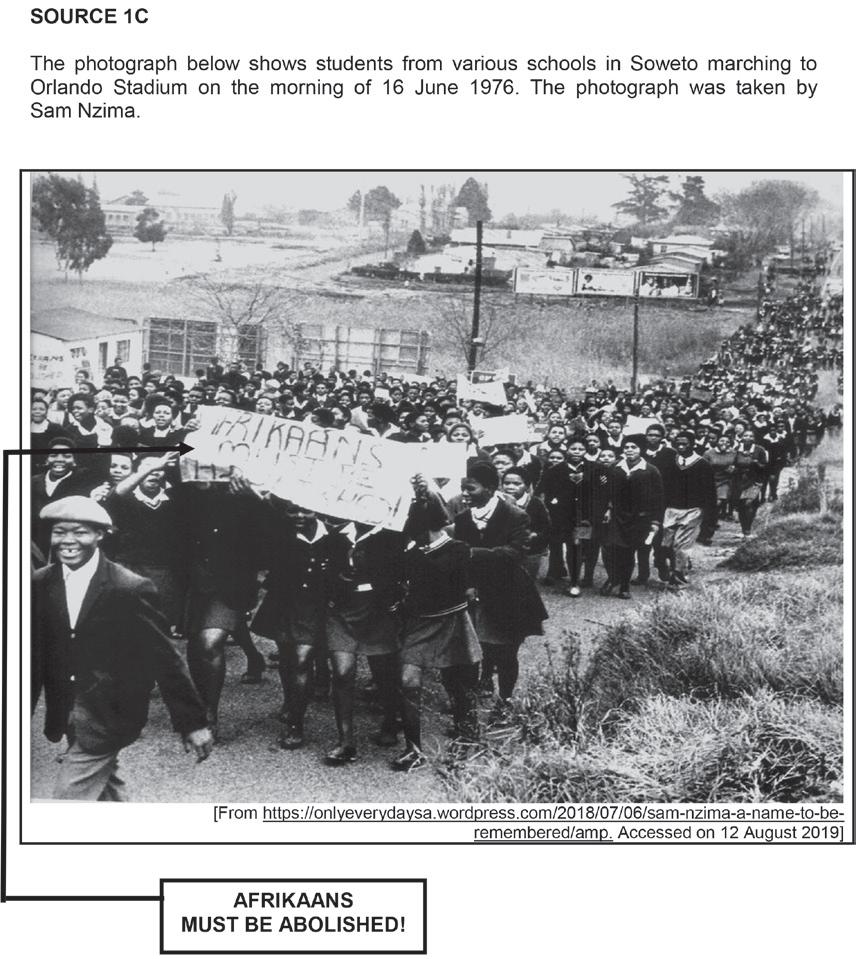
Study Sources 1A, 1B, 1C and 1D and answer the questions that follow.



1.1 Refer to Source 1A.


1.1.1 Quote TWO political organisations from the source that were banned in the 1960s.
1.1.2 Define the concept Black Consciousness in your own words.
1.3 Study Source 1C.
(2 x 1) (2)
(1 x 2) (2)
1.1.3 Identify TWO concerns in the source that the student leaders had about the education system. (2 x 1) (2)







1.1.4 Using the information in the source and your own knowledge, explain why the apartheid government introduced Afrikaans as a compulsory medium of instruction at black South African schools. (2 x 2) (4)

1.2 Read Source 1B in the next column.



1.2.1 Why do you think the editor of The World newspaper decided to publish this article? (1 x 2) (2)
1.2.2 How, according to the source, did the 'strike' at Phefeni Junior Secondary School turn violent? (2 x 1) (2)
1.2.3 Comment on the usefulness of this source to a historian studying the events leading to the Soweto Uprising of 1976.
(2 x 2) (4)
1.3.1 Comment on the mood of the students in the photograph. (1 x 2) (2)
1.3.2 Using the information in the source and your own knowledge, explain why students from Soweto decided to embark on a march. (2 x 2) (4)

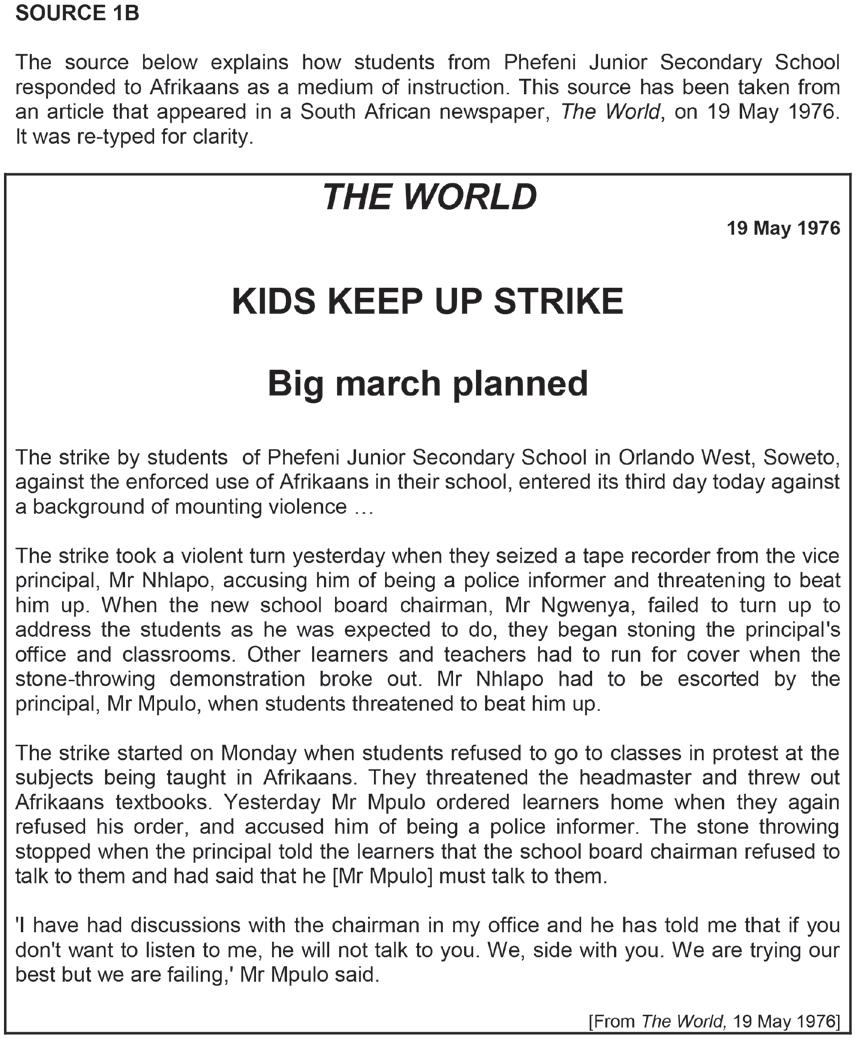
43
The
official papers in this supplement have been published with the endorsement of the Department of Basic Education. For more Matric Questions and Memoranda go to https://www.education.gov.za/ A PROUD BRAND OF
Matric Q&A




1.4

1.4.1 Explain why you think there were differences in the official and unofficial figures regarding the number of students that were killed by the police in Soweto. (2 x 2) (2)

1.4.2 How, according to the source, did students respond to the apartheid police force after they opened fire? (4 x 1) (4)
1.4.3 Why, according to the source, did the Soweto Uprising surprise the apartheid police? (1 x 2) (2)

1.4.4 Using the information in the source and your own knowledge, explain why the Soweto Uprising is regarded as a turning point in South Africa's history. (2 x 2) (4)
1.5 Consult Sources 1C and 1D and explain how the information in Source 1C differs from the evidence in Source 1D regarding the Soweto Uprising of 1976. (2 x 2) (4)
1.6 Using the information in the relevant sources and your own knowledge, write a paragraph of about EIGHT lines (about 80 words) explaining why black South African students protested in 1976.
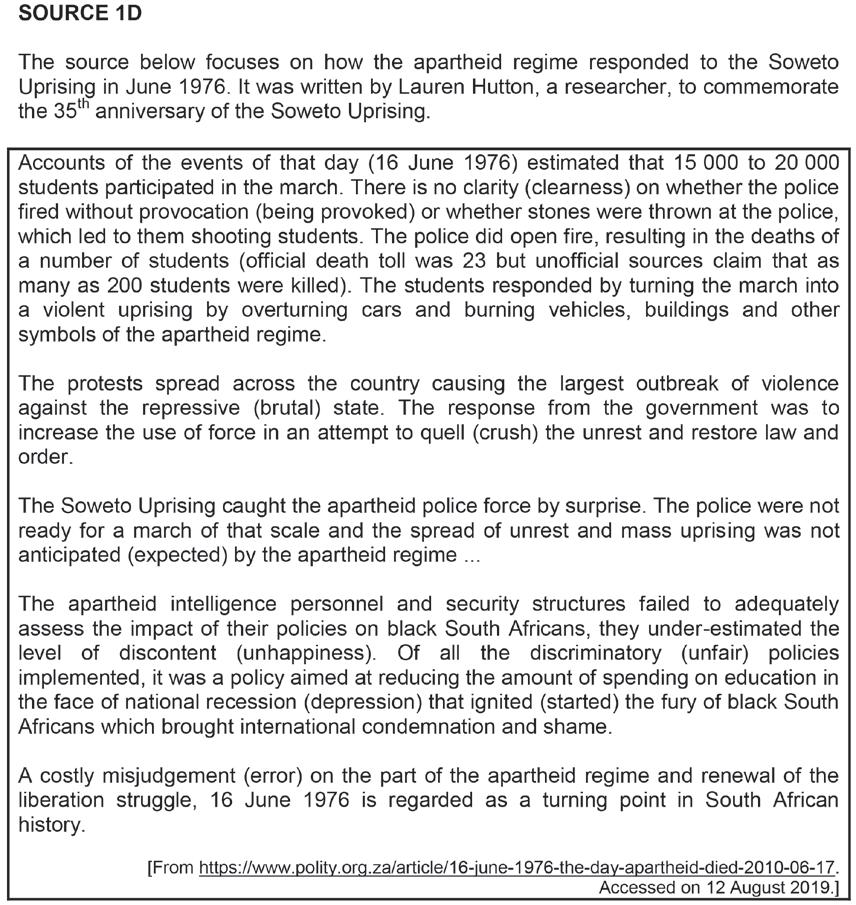
QUESTION 2: HOW DID THE TRUTH AND RECONCILIATION COMMISSION (TRC) DEAL WITH THE MURDER OF POLITICAL ACTIVISTS SUCH AS THE CRADOCK FOUR?
Study Sources 2A, 2B, 2C and 2D and answer the questions that follow.
2.1.1 Why, according to the source, was the TRC established? (1 x 2) (2)
2.1.2 Explain why you think the TRC focused on restorative justice rather than retributive justice. (2 x 2) (4)


2.1.3 Define the concept amnesty in the context of the TRC. (1 x 2) (2)
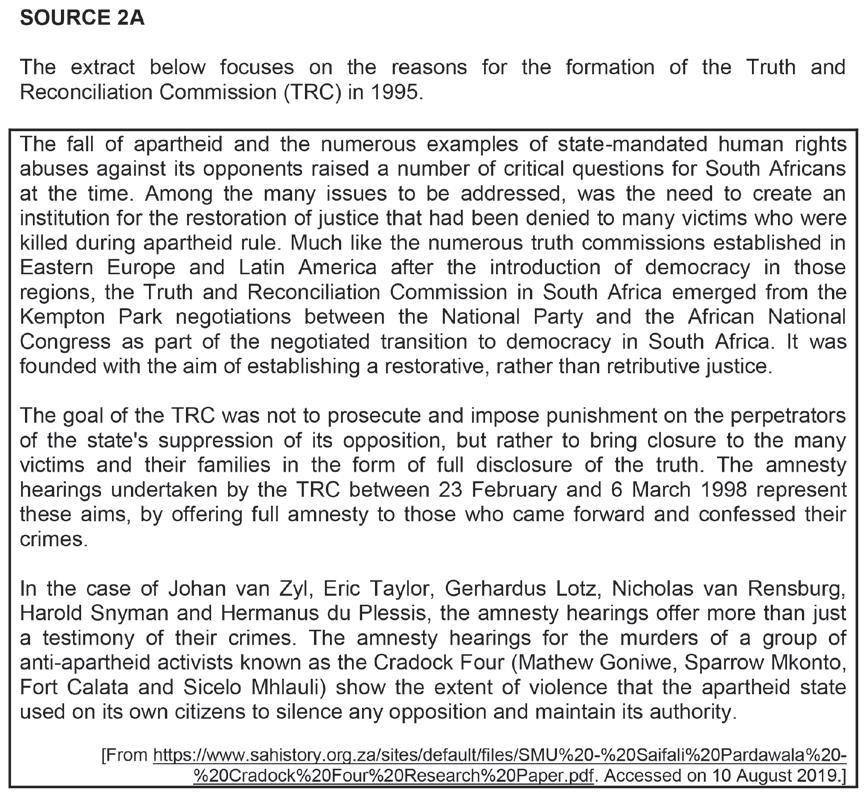







2.1.4 Name any THREE security policemen in the source who applied for amnesty for the murder of the Cradock Four. (3 x 1) (3)
 The
The
official
papers in this supplement have been published with the endorsement of the Department of Basic Education. For more Matric Questions and Memoranda go to https://www.education.gov.za/
44 HISTORY
Use Source 1D.
(8) [50]
2.1 Refer to Source 2A.
2.2 Consult Source 2B.
2.2.1 Comment on why the TRC decided to produce this poster. (2 x 2) (4)
2.2.2 Name any TWO crimes, in the source, that were committed in 'our past'. (2 x 1) (2)
2.2.3 Explain what is implied by the words, 'LET'S SPEAK OUT TO EACH OTHER … SO THAT WE CAN WALK THE ROAD TO RECONCILIATION TOGETHER', in the context of the TRC hearings. (2 x 2) (4)


2.3 Read Source 2C in the next column.




2.3.1 Name the TWO activists in the source that Mr Lotz identified when he stopped the vehicle. (2 x 1) (2)
2.3.2 Using the information in the source and your own knowledge, explain why Mr Lotz set the motor vehicle alight. (2 x 2) (4)
2.3.3 Comment on the usefulness of this source for a historian researching the murder of the Cradock Four. (2 x 2) (4)

2.4 Study Source 2D.
2.4.1
What, according to the source, was the outcome of the TRC hearings regarding the Cradock Four? (1 x 1) (1)
2.4.2 Quote evidence from the source that suggests why the security police were denied amnesty by the TRC. (2 x 1) (2)
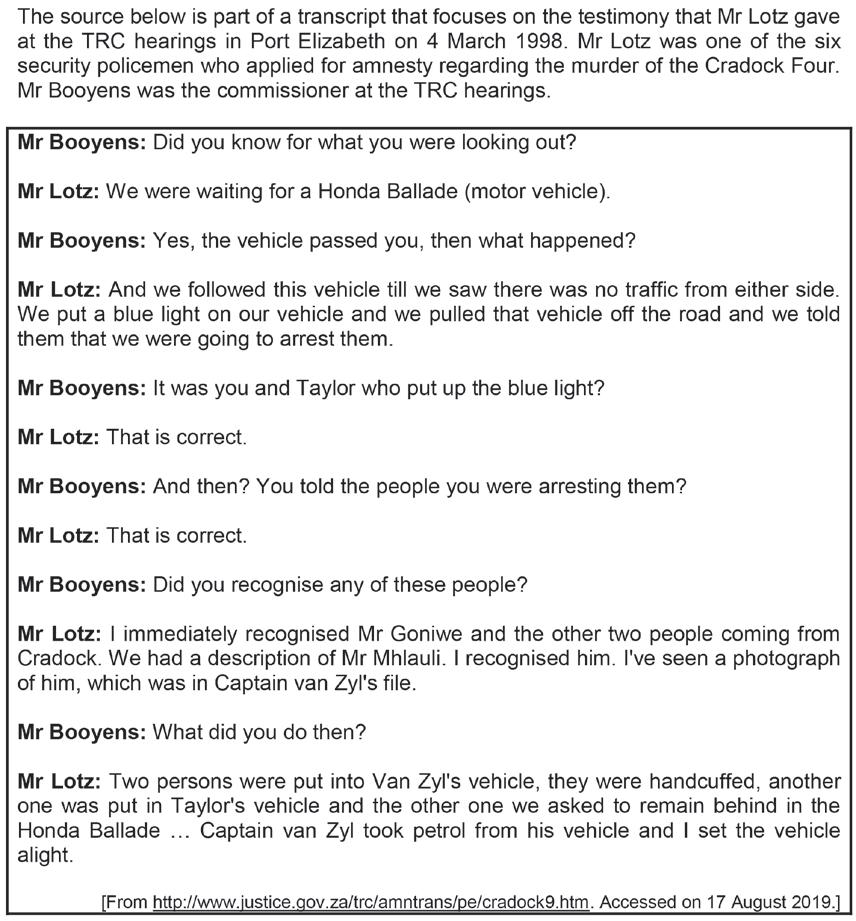
2.4.3 Explain why you think Goniwe's brother was pleased with the TRC's decision regarding the Cradock Four. (2 x 2) (4)
2.5 Refer to Sources 2B and 2D. Explain how the information in Source 2B supports the evidence in Source 2D regarding how the security policemen interrogated anti-apartheid activists. (2 x 2) (4)
2.6 Using the information in the relevant sources and your own knowledge, write a paragraph of about EIGHT lines (about 80 words) explaining how the TRC dealt with the murder of political activists such as the Cradock Four. (8) [50]
QUESTION 3: WHAT IMPACT DID GLOBALISATION HAVE ON SOUTH AFRICA?








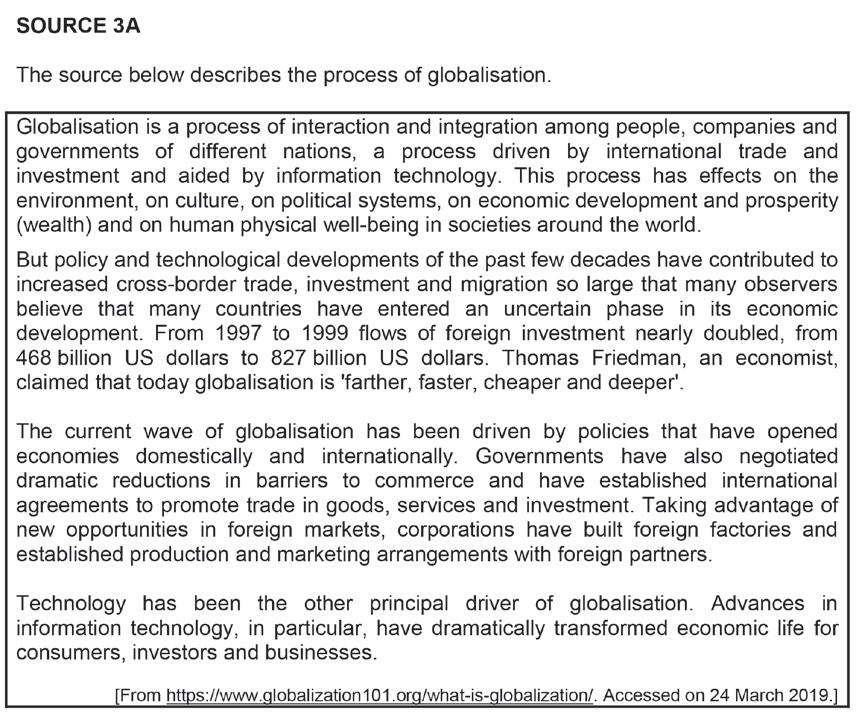


Study Sources 3A, 3B, 3C and 3D and answer the questions that follow.


3.1 Refer to Source 3A.




3.1.1
Define the term globalisation in your own words. (1 x 2) (2)
3.1.2 Give TWO examples in the source of the effects that globalisation had in various societies around the world. (2 x 1) (2)



3.1.3 According to the source, why did many observers believe that countries have entered 'an uncertain phase' in their economic development? List THREE factors. (3 x 1) (3)






3.1.4 Using the information in the source and your own knowledge, comment on Thomas Friedman's claims 'that today globalisation is "farther" (and) "faster" '. (2 x 2) (4)


45
The official papers in this supplement have been published with the endorsement of the Department of Basic Education. For more Matric Questions and Memoranda go to https://www.education.gov.za/
A PROUD BRAND OF
Matric Q&A


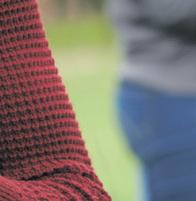
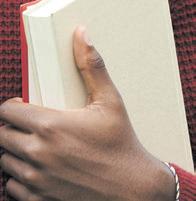











3.2 Read Source 3B.
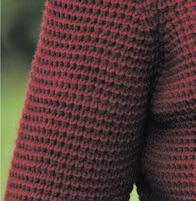
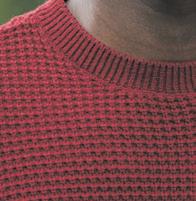



HISTORY
3.2.1 Quote evidence from the source that shows globalisation helped 'developed countries'. (2 x 1) (2)
3.2.2 How, according to the source, can countries use 'technology and innovation' to raise 'incomes and living standards of the poor'? (2 x 1) (2)



3.2.3 Using the information in the source and your own knowledge, explain why you think the wages of 'low-skilled workers' have been reduced. (2 x 2) (4)
3.3 Use Source 3C.




3.3.1 What, according to the source, was Gordhan's view of globalisation? (1 x 1) (1)
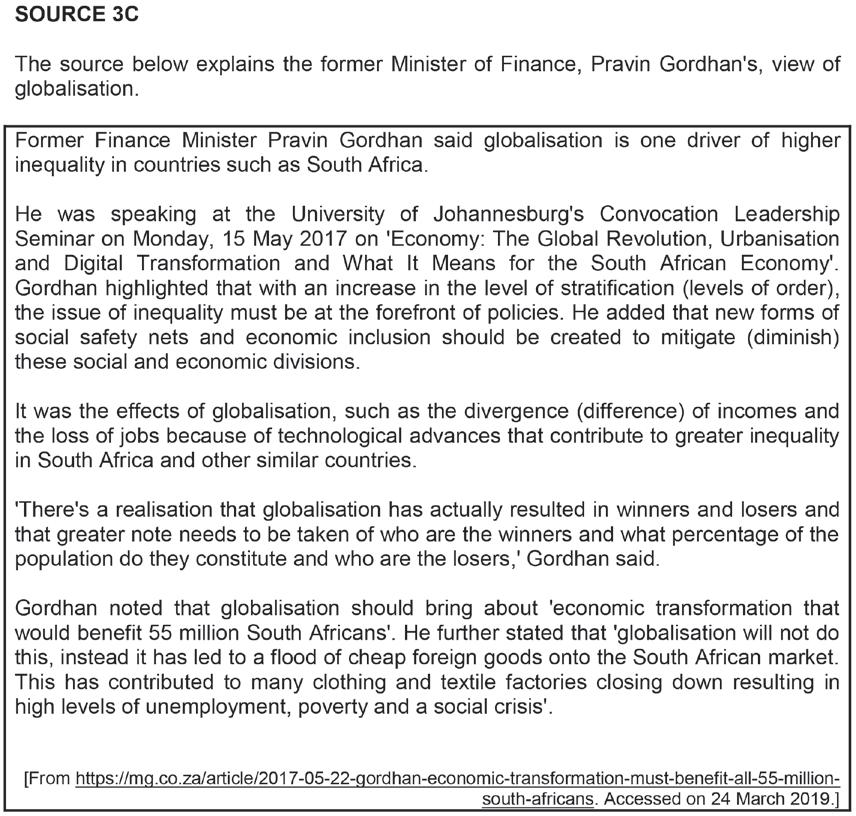
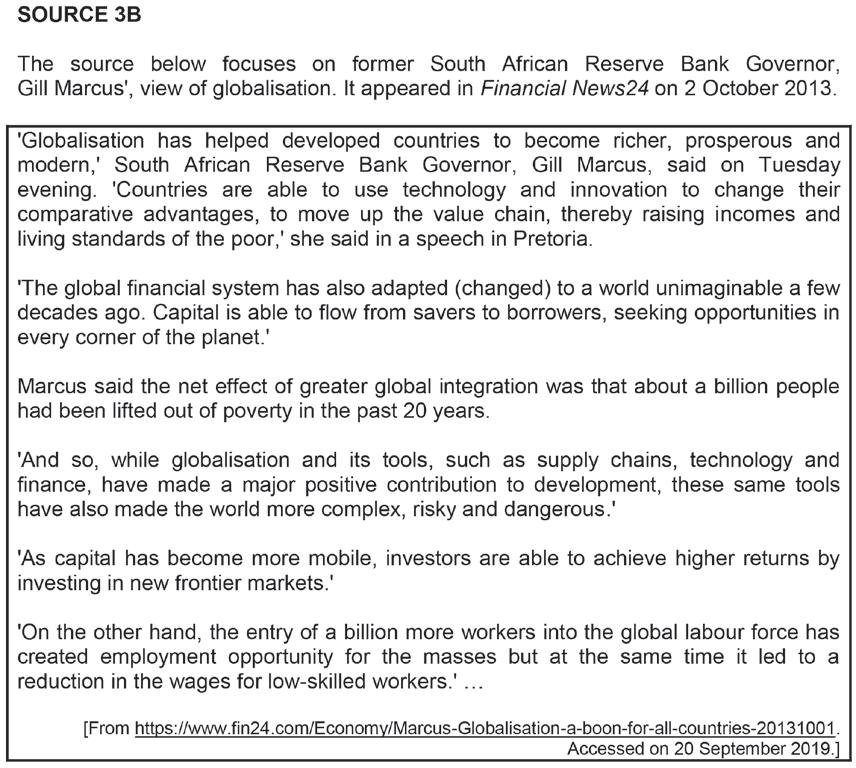
3.3.2 Identify the TWO strategies in the source that Gordhan suggested would help South Africa to deal with the social and economic divisions created by globalisation. (2 x 1) (2)
3.3.3 Explain how globalisation has contributed to increasing levels of inequality in South Africa. (2 x 2) (4)


3.3.4 Comment on the usefulness of the source to a historian researching the impact that globalisation had on South Africa's economy. (2 x 2) (4)
3.4 Consult Source 3D below.


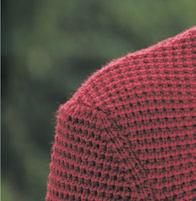



The cartoon below depicts the impact that poverty had on the 'HAVES' and the 'HAVE-NOTS'. It was drawn by B Fray in 2008.

3.4.1 Explain the messages that are conveyed in the cartoon. Use the visual clues in the source to support your answer. (2 x 2) (4)
3.4.2 Using the information in the source and your own knowledge, explain who are 'THE HAVES' and the 'HAVE-NOTS' in the context of globalisation. (2 x 2) (4)
3.5 Study Sources 3C and 3D. Explain how the information in both sources supports each other regarding the negative effects of globalisation on South Africa. (2 x 2) (4)
3.6 Using the information in the relevant sources and your own knowledge, write a paragraph of about EIGHT lines (about 80 words) explaining the impact that globalisation had on South Africa. (8)

 The
The
official papers in this supplement
have been published with the endorsement of the Department of Basic Education. For more Matric Questions and Memoranda go to https://www.education.gov.za/
46
[From https://aftruth.com/economic/the-widening-gap-between-the-rich-and-the-poor- the-shrinking-of the-rights-of-workers-in-south-africa/. Accessed on 5 May 2019.]
[50]
SECTION B: ESSAY QUESTIONS





Answer at least ONE question, but not more than TWO questions, in this section.
Your essay should be about THREE pages long.

QUESTION 4: CIVIL RESISTANCE, 1970s TO 1980s: SOUTH AFRICA: THE CRISIS OF APARTHEID IN THE 1980s
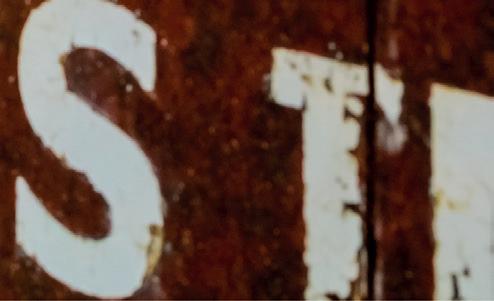
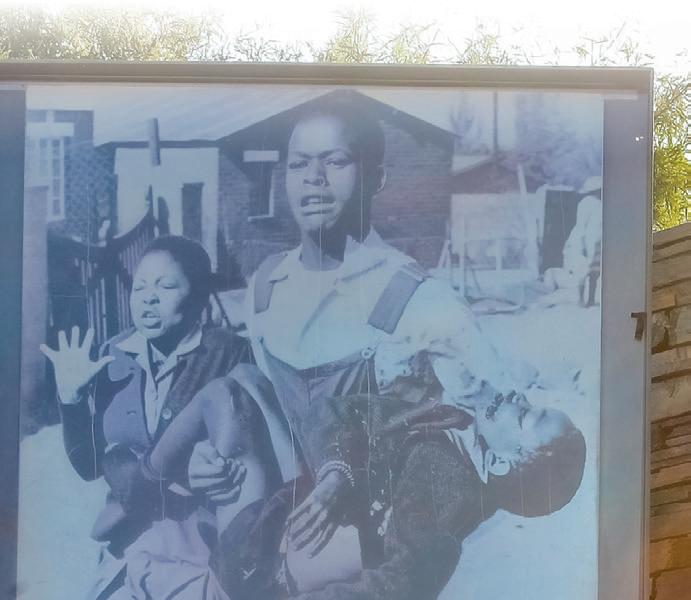


It was the result of intense pressure from various international anti-apartheid organisations that led to the eventual collapse of the apartheid regime in the 1980s.



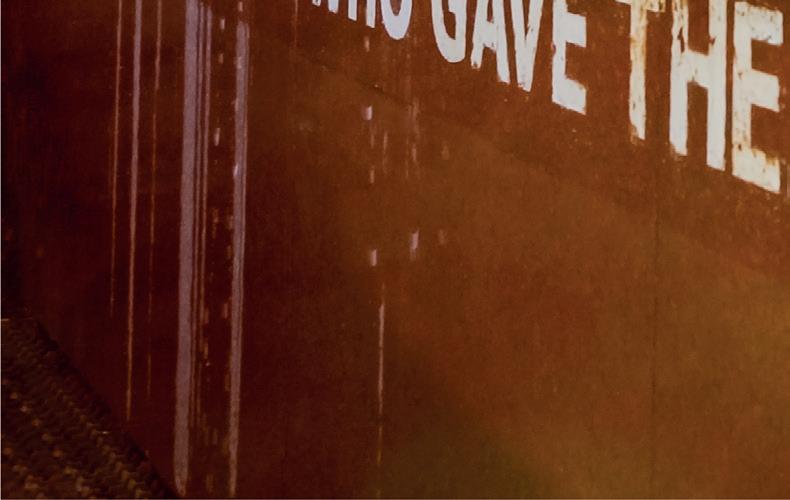
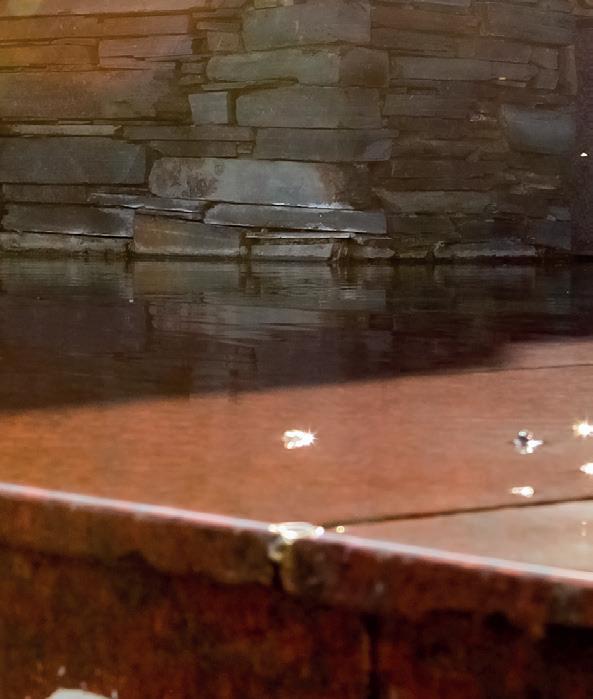


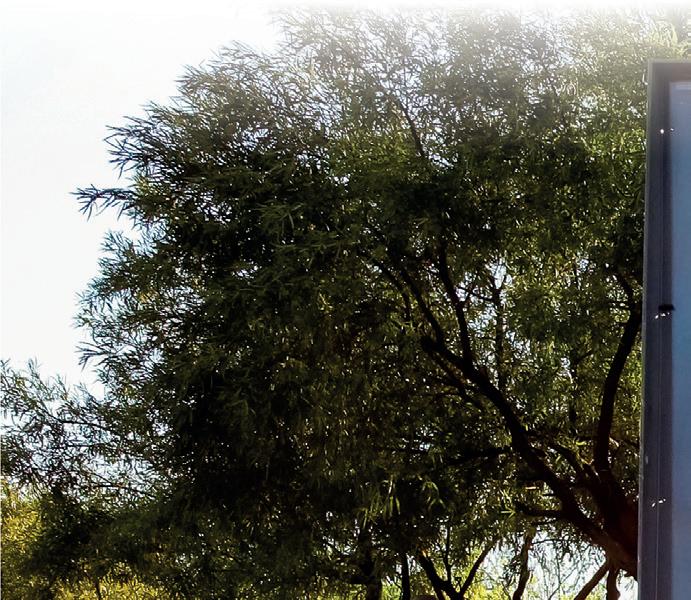
Do you agree with the statement? Support your line of argument with relevant historical evidence.
QUESTION 5: THE COMING OF DEMOCRACY TO SOUTH AFRICA AND COMING TO TERMS WITH THE PAST
The process of negotiations among various political parties played a significant role in the establishment of a democratic South Africa in 1994.
Critically discuss this statement. Use relevant evidence to support your line of argument.
QUESTION 6: THE END OF THE COLD WAR AND A NEW WORLD ORDER: THE EVENTS OF 1989





Explain to what extent the collapse of the Soviet Union in 1989 contributed to the political changes that occurred in South Africa.
Support your line of argument with relevant evidence.




150



47
The
official papers in this
supplement have been published with the endorsement of the Department of Basic Education. For more Matric Questions and Memoranda go to https://www.education.gov.za/
A PROUD BRAND OF
[50]
[50]
[50] TOTAL:
Matric Q&A
SECTION A: SOURCE-BASED QUESTIONS
QUESTION 1: WHY DID BLACK SOUTH AFRICAN STUDENTS PROTEST IN 1976?
1.1 1.1.1 [Extraction of evidence from Source 1A - L1]
• 'African National Congress (ANC)'
• 'Pan Africanist Congress (PAC)' (2 x 1) (2)

1.1.2 [Definition of a historical concept from Source 1A - L1] Black Consciousness was a philosophy/ideology that:
• Promoted self-confidence/assertiveness


• Encouraged black pride/to be proud of being black
• Inspired black South Africans to be independent and selfreliant
• Encouraged equality, justice, pride and unity

• Emphasised mental emancipation from white subservience

• Any other relevant response (any 1 x 2) (2)
1.1.3 [Extraction of evidence from Source 1A - L1]
• 'the current education system was Euro-centric (based on European values, customs and traditions)'
• 'Undermined (weakened) the African achievement' (2 x 1) (2)
1.1.4 [Interpretation of evidence in Source 1A – L2]
• To maintain control and authority over black South Africans
• To use education to ensure that black South Africans remain in servitude to white minority rule/cheap labour market

• To use language as a form of indoctrination in an effort to maintain white superiority
• To ensure that black South Africans would not become critical thinkers
• Any other relevant response (any 2 x 2) (4)
1.2 1.2.1 [Interpretation of evidence in Source 1B – L2]
• To inform the public that students from Phefeni Junior Secondary School were engaged in a march against the imposition of Afrikaans as medium of instruction. It was newsworthy
• To indicate that students from Phefeni Junior Secondary School were protesting/to indicate that there was a determined opposition to Afrikaans as a medium of instruction
• To inform the public about the violent nature of the strike at Phefeni Junior Secondary School
• To expose the apartheid government internationally
• Any other relevant response (any 1 x 2) (2)
1.2.2 [Extraction of evidence from Source 1B – L1]
• '… seized a tape recorder from the vice-principal, Mr Nhlapo and threatening to beat him up'
• '… they began stoning the principal's office and classrooms …'
• 'They threatened the headmaster and threw out Afrikaans textbooks' (any 1 x 2) (2)
1.2.3 [Determining the usefulness of Source 1B – L3]










The source is USEFUL because:
• It gives insight into why the students at Phefeni Junior Secondary School embarked on violent protest action
• It gives first-hand information about how the events unfolded at Phefeni Junior Secondary School
• It gives information how the students at Phefeni Junior Secondary School responded to the introduction of Afrikaans as a medium of instruction

• It gives information that students of Phefeni Junior Secondary School were united/determined in their protest action
• It indicates that there were sustained protests at Phefeni Junior Secondary School
• It gives the names of the people involved, the dates and other events leading to the Soweto Uprising
• Any other relevant response (any 2 x 2) (4)
1.3 1.3.1 [Interpretation of evidence in Source 1C - L2]
• It shows the students were smiling/happy as they embarked on the march to protest against Afrikaans as a medium of instruction at schools in Soweto
• The photograph shows students were very disciplined and orderly while embarking on the march
• Any other relevant response (any 1 x 2) (2)
1.3.2 [Interpretation of evidence in Source 1C – L2]
• The students marched against the imposition of Afrikaans as a medium of instruction
• The students embarked on protest action to challenge Bantu education/the authorities
• The students felt that learning the Afrikaans language will make them subservient to white South Africans
• The students could not understand the Afrikaans language hence they were failing their examinations
• The students embarked on a protest against the socioeconomic conditions of black South Africans
• Any other relevant response (any 2 x 2) (4)
1.4 1.4.1 [Interpretation of evidence in Source 1D – L2]
• The police wanted to keep the totals to a minimum (23 killed) so that they would not look bad/merciless
• The official figures by the police showed that they wanted to cover up their role in the killing of students in the Soweto Uprising
• The police wanted to keep figures low so that they would avoid international embarrassment
• The unofficial figures would spark more violence
• The unofficial figures would expose police brutality
• Any other relevant response (any 2 x 2) (4)
1.4.2 [Extraction of evidence from Source 1D – L1]
• 'The students turned the march into a violent uprising'
• 'Overturning cars'
• 'Burning vehicles'
• 'Burning buildings'
• 'Burning symbols of the apartheid regime' (any 4 x 1) (4)
The official papers in this supplement have been published with the endorsement of the Department of Basic Education. For more Matric Questions and Memoranda go to https://www.education.gov.za/
48 HISTORY
MEMO PAPER 2
1.4.3 [Extraction of evidence from Source 1D – L1]
• 'The police were not ready for a march on that scale'
• 'The spread of unrest and mass uprising was not anticipated (expected) by the apartheid regime …'
• ‘They under-estimated the level of discontent (unhappiness)’ (any 1 x 2) (2)



1.4.4 [Interpretation of evidence in Source 1D – L2]
• The Soweto Uprising challenged the apartheid regime to address the inequalities of the past/they were forced to rethink its policies
• The Soweto Uprising was a turning point because young students were prepared to challenge the might of the apartheid state
• The apartheid regime was caught off guard/did not expect the mobilisation of learners/underestimated the march
• Internationally South Africa gained a negative reputation which affected its economy directly
• The Soweto Uprising renewed the liberation struggle in South Africa
• Many international companies responded by imposing sanctions and disinvestments on South Africa

• Any other relevant response (any 2 x 2) (4)
1.5 [Comparison of evidence in Sources 1C and 1D - L3]
• Source 1C shows students protesting peacefully against the implementation of Afrikaans as a medium of instruction while Source 1D states students reacted violently during the march after the police attacked them
• Source 1C does not show police presence during the march while Source 1D states that the police opened fire on students, killing approximately 200
• Source 1C shows how the students challenged the apartheid regime to change the language policy whereas in Source 1D the apartheid regime failed to review the unfair discriminatory policies of the Bantu Education Act
• Source 1C shows students protesting while Source 1D indicates the response of the police
• Any other relevant response (any 2 x 2) (4)
1.6 [Interpretation, evaluation and synthesis from relevant sources – L3] Candidates could include the following aspects in their response:
• The philosophy of Black Consciousness (BC) boosted the selfesteem of Black South African students (Source 1A)
• SASO and SASM played a major role in conscientising black South African students to stand up for their rights (Source 1A)
• The students challenged the system of Bantu education which was based on European values, customs and traditions (Source 1A)
• The students challenged the language policy of the apartheid government (own knowledge)
• Black South African students wanted to unite and challenge the apartheid regime (own knowledge)
• The teachers did not understand Afrikaans as a medium of instruction yet they were expected to teach in the same language (own knowledge)
• The World newspaper highlighted the students' dissatisfaction regarding the imposition of Afrikaans as a medium of instruction (Source 1B)

• The photograph shows students demanding 'Afrikaans must be abolished' (Source 1C)
• 15 000 to 20 000 black South African students protested against the implementation of Afrikaans as a medium of instruction (Source 1D)
• The Soweto Uprising exposed the brutality of the apartheid regime to the rest of the world and cast South Africa in a negative light (own knowledge)
• Any other relevant response
The following rubric will be used by markers:
• Uses evidence in an elementary manner e.g. shows no or little understanding of why black South African students protested in 1976.
LEVEL 1
• Uses evidence partially or cannot write a paragraph.
LEVEL 2
• Evidence is mostly relevant and relates to a great extent on the topic e.g. shows some understanding of why black South African students protested in 1976.
• Uses evidence in a very basic manner to write a paragraph.

• Uses relevant evidence e.g. demonstrates a thorough understanding of why black South African students protested in 1976.
MARKS 0–2

MARKS 3–5
LEVEL 3
• Uses evidence very effectively in an organised paragraph that shows an understanding of the topic.
QUESTION 2: HOW DID THE TRUTH AND RECONCILIATION COMMISSION (TRC) DEAL WITH THE MURDER OF POLITICAL ACTIVISTS SUCH AS THE CRADOCK FOUR?
2.1 2.1.1 [Extraction of evidence from Source 2A - L1]
MARKS 6–8
[50]
• 'To create an institution for the restoration of the justice that had been denied to many victims who were killed during apartheid rule'
• 'Establishing a restorative rather than retributive justice'

• ‘To bring closure to the many victims and their families’ (any 1 x 2) (2)




2.1.2 [Interpretation of evidence in Source 2A – L2]
• The TRC aimed at bringing about healing between the victim and the perpetrator/to restore dignity
• Healing between the victim and the perpetrator could lead to forgiveness and hence reconciliation
• The TRC wanted to build a new South Africa based on forgiveness rather than hatred/to avoid revenge
• Any other relevant response (any 2 x 2) (4)
2.1.3 [Definition of a historical concept in Source 2A – L1]





• The granting of official pardon for people who committed politically related/motivated crimes

• Any other relevant response (1 x 2) (2)
2.1.4 [Extraction of evidence from Source 2A - L1]
• 'Johan van Zyl'
• 'Eric Taylor'
• 'Gerhardus Lotz'
• 'Nicholas van Rensburg'
49
The
official papers in this supplement have been published with the
endorsement of the Department of Basic Education. For more Matric Questions and Memoranda
go to
https://www.education.gov.za/
A PROUD BRAND OF
(8)
Matric Q&A
• 'Harold Snyman'
• 'Hermanus du Plessis' (any 3 x 1) (3)
2.2 2.2.1 [Interpretation of evidence in Source 2B – L2]
• To invite both perpetrators and victims to appear before the TRC and testify about human rights abuses
• To inform the public about the crimes that were committed during apartheid
• To encourage people to speak the truth about their involvement in political killing
• To inform the public that there were TRC hearings taking place throughout the country
• To highlight the purpose of the TRC - truth telling and reconciliation
• Any other relevant response (any 2 x 2) (4)
2.2.2 [Extraction of evidence from Source 2B - L1]
• 'Murder'
• 'Abduction'
• 'Torture' (any 2 x 1) (2)
2.2.3 [Interpretation of evidence in Source 2B – L2]
The TRC encouraged:
• Perpetrators to tell the truth/full disclosure
• Apartheid agents/Security police to come forward and tell victims about the whereabouts of their loved ones
• Healing and reconciliation
• Any other relevant response (any 2 x 2) (4)
2.3 2.3.1 [Extraction of evidence from Source 2C - L1]
• 'Mr Goniwe'
• 'Mr Mhlauli' (2 x 1) (2)
2.3.2 [Interpretation of evidence in Source 2C – L2]
• He wanted to cover up the crime he had committed
• He did not want to leave any evidence behind regarding the killing of political activists
• To discourage political activists from getting involved in political activities against the apartheid regime
• Any other relevant response (any 2 x 2)(4)
2.3.3 [Determining the usefulness of Source 2C – L3]



The source is USEFUL because:
• It highlights the surveillance that the security policemen used regarding the Cradock Four
• It gives the names of the security policemen who were involved in the surveillance

• It focuses on how the security policemen dealt with Mr Goniwe and Mr Mhlauli
• It states how Mr Goniwe and Mr Mhlauli were murdered
• It gives new insights (testimony) into how the security police killed the Cradock Four
• Any other relevant response (any 2 x 2) (4)
2.4 2.4.1 [Extraction of evidence from Source 2D - L1]
• '…security policemen have been refused amnesty' (1 x 1) (1)
2.4.2 [Extraction of evidence from Source 2D - L1]
• 'the men never made a full disclosure regarding the killings'
• 'The commission could therefore not find a relationship between the act and political motives' (2 x 1) (2)
2.4.3 [Interpretation of evidence in Source 2D – L2]
• Goniwe's brother and his family could now find closure regarding the murder of Mathew Goniwe and other political activists
• The TRC was an independent body that was devoid of political interference and therefore made a correct decision by not granting amnesty to the perpetrators responsible for the murder of the Cradock Four
• Goniwe’s brother felt that justice was served
• Any other relevant response (any 2 x 2) (4)
2.5 [Comparison of evidence in Sources 2B and 2D - L3]
• Both Sources 2B and 2D mention the crimes that were committed (murder, abduction and torture) during interrogation
• Source 2B outlines the brutal crimes (murder, abduction, torture) that the apartheid police committed against political activists and Source 2D demonstrates how the security policemen dealt with political activists (interrogation)
• In Source 2B perpetrators were invited to appear before the TRC to explain how they interrogated political activists and Source 2D indicates the role that the security policemen played in the interrogation and killing of political activists
• Any other relevant response (any 2 x 2) (4)
2.6 [Interpretation, evaluation and synthesis of evidence from relevant sources – L3]










Candidates could include the following aspects in their response:
• The TRC was established to ensure the goals, facilitation of rehabilitation and restoration of the human and civil dignity of victims of gross human rights violations (Source 2A)
• The TRC aimed to achieve restorative justice instead of retributive justice (Source 2A)
• The TRC aimed at bringing closure to the families of victims if perpetrators made full disclosure of the truth (Source 2A)
• The TRC created a platform for victims and perpetrators to tell their stories about human rights abuses (own knowledge)
• During the TRC hearings some of the truth surfaced such as how the Cradock Four were killed (own knowledge)
• In some cases, perpetrators sought forgiveness and provided families with answers (own knowledge)
• The TRC used posters to invite both perpetrators and victims to appear before the TRC and testify about human rights abuses (Source 2B)
• At the TRC hearings perpetrators were questioned by the state lawyers about how political activists were abducted and killed (Source 2C)
• The security policemen who were responsible for the murder of the Cradock Four were refused amnesty (Source 2D)
• Any other relevant response
The

official papers in this supplement have been published with the endorsement of the Department of Basic Education. For more Matric Questions and Memoranda go to https://www.education.gov.za/
50 HISTORY
Use the following rubric to
LEVEL 1
• Uses evidence in an elementary manner e.g. shows no or little understanding in explaining how the TRC dealt with the murder of political activists such as the Cradock Four.
• Uses evidence partially or cannot write a paragraph.
MARKS
3.2 3.2.1 [Extraction of evidence from Source 3B – L1]
• 'Richer'
• 'Prosperous'
• 'Modern' (any 2 x 1) (2)
3.2.2 [Extraction of evidence from Source 3B – L1]
• 'To change their comparative advantages'
LEVEL 2
• Evidence is mostly relevant and relates to a great extent on the topic e.g. shows some understanding in explaining how the TRC dealt with the murder of political activists such as the Cradock Four.
• Uses evidence in a very basic manner to write a paragraph.
• Uses relevant evidence e.g. demonstrates a thorough understanding in explaining how the TRC dealt with the murder of political activists such as the Cradock Four.
MARKS
• 'To move up the value chain' (2 x 1) (2)



3.2.3 [Interpretation of evidence in Source 3B - L2]
• The owners of the means of production wanted to maximise their profits
• Employers justified the employment of low-skilled workers by paying them poor wages
LEVEL 3
• Uses evidence very effectively in an organised paragraph that shows an understanding of the topic.
MARKS
• Workers are in competition for low-skilled jobs and this enables employers to keep their wages low
• Jobs do not require specialisation therefore employers can afford to keep wages low

• Any other relevant response (any 2 x 2) (4)
3.3 3.3.1 [Extraction of evidence from Source 3C – L1]
• 'Globalisation is one driver of higher inequality in countries such as South Africa' (1 x 1) (1)

QUESTION 3: WHAT IMPACT DID GLOBALISATION HAVE ON SOUTH AFRICA?
3.1 3.1.1 [Definition of a historical concept in Source 3A - L1]
• Globalisation refers to the technological, political and economic changes, which have resulted in the world functioning in a different way from what it did 20 years ago
• Globalisation describes the way in which people, ideas and goods move around the world more quickly and cheaply than before
• Any other relevant response (any 1 x 2) (2)
3.1.2 [Extraction of evidence from Source 3A – L1]
• 'Environment'
• 'Culture'
• 'Political systems'
• 'Economic development and prosperity'
• 'Human physical well-being in societies' (any 2 x 1) (2)
3.1.3 [Extraction of evidence from Source 3A – L1]
• 'Increased cross border trade'
• 'Increased investment and migration'
• 'Foreign investment doubled' (3 x 1)(3)




3.1.4 [Interpretation of evidence in Source 3A - L2]
• Communication technology such as the internet has allowed people all over the world to be in contact instantly

• Communication such as the internet has allowed people throughout the world to be in contact with each other at all times
• Travel between countries has become cheaper and faster
• The transfer of money and trade is available 24/7 because of innovative technology

• Any other relevant response (any 2 x 2) (4)
3.3.2 [Extraction of evidence from Source 3C – L1]
• ‘The issue of inequality must be at the forefront of policies’




• 'New forms of social safety nets'
• 'Economic inclusion should be created' (any 2 x 1) (2)
3.3.3 [Interpretation of evidence in Source 3C - L2]
• The gap between wages of low-skilled and skilled workers was huge
• Wage increases between low-skilled and skilled workers was unequal
• Skilled workers normally had better benefits than low-skilled workers
• Low-skilled workers tend to be more vulnerable to unemployment than skilled workers
• The rich were able to use technology to increase their profits and that enriched them more than low-skilled workers
• Any other relevant response (any 2 x 2) (4)
3.3.4 [Ascertaining the usefulness of Source 3C – L3]



The source is USEFUL because:
• Gordhan states in his speech that globalisation contributed to higher levels of inequality in South Africa
• Gordhan suggested that government needed to formalise policies to address inequality in the job market
• Globalisation has contributed to the widening gap between winners (rich) and losers (poor)
• It states that economic transformation that was supposed to benefit the majority only benefitted the minority
• Any other relevant response (any 2 x 2) (4)
3.4 3.4.1 [Interpretation of evidence in Source 3D – L3]
• The cartoon shows that globalisation was responsible for the widening of the gap between the rich and poor
• The cartoon shows the 'Haves' are in the minority in relation to the 'Have-Nots' who are in the majority
51 The official papers in this supplement have been published with the endorsement of the Department of Basic Education. For more Matric Questions and Memoranda go to https://www.education.gov.za/ A PROUD BRAND OF
allocate marks:
0–2
3–5
6–8 (8) [50]
Matric Q&A
HISTORY
• The cartoon shows that globalisation perpetuates inequality
• The cartoon depicts that globalisation has enriched the 'haves' at the expense of the 'have nots'
• Any other relevant response (any 2 x 2) (4)
3.4.2 [Interpretation of evidence from Source 3D - L2]




• (Haves) People that own the means of production/'the rich'/ developed countries

• (Have nots) People who are poverty stricken (poor) like the unemployed, and destitute/developing countries


• Any other relevant response (2 x 2) (4)
3.5 [Comparison of evidence from Sources 3C and 3D – L3]
• Both Sources 3C and 3D show that globalisation has contributed to inequality in South Africa

• Both Sources 3C and 3D show that globalisation was responsible for the creation of 'losers' (poor) and 'winners' (rich)
• Both Sources 3C and 3D show that globalisation benefitted the minority (rich) and not the majority (poor)
• Both Sources 3C and 3D show that globalisation created the 'haves' (rich) and the 'have nots' (poor)
• Any other relevant response (any 2 x 2) (4)
3.6 [Interpretation, evaluation and synthesis of evidence from relevant sources - L3]








Candidates could include the following aspects in their response:
Globalisation impacted on South Africa in the following ways:
• Increased trade, investment and migration (Source 3A)
• Contributed to advances in Information Technology (IT) which has in turn changed the lives of people (Source 3A)

• Raised incomes and living standards of the poor (Source 3B)
• Contributed to the wages of low-skilled workers being kept low (own knowledge )



• Resulted in increased inequality (Source 3C)

• Contributed to a large number of people becoming unemployed (own knowledge)


• By enriching a minority and contributing to the impoverishment of the majority (Source 3D)
• Contributed to the widening of the gap between the rich and the poor (Source 3D)


• Resulted in the 'haves' becoming richer while the 'have nots' becoming poorer (Source 3D)
• Resulted in high levels of unemployment, poverty and social challenges (own knowledge)
• Any other relevant response
Use the following rubric to allocate marks:
LEVEL 1

• Uses evidence in an elementary manner e.g. shows no or little understanding of the impact that globalisation had on South Africa.
• Uses evidence partially or cannot write a paragraph.
LEVEL 2

• Evidence is mostly relevant and relates to a great extent on the topic e.g. shows some understanding of the impact that globalisation had on South Africa.
• Uses evidence in a very basic manner to write a paragraph.
• Uses relevant evidence e.g. demonstrates a thorough understanding of the impact that globalisation had on South Africa.
LEVEL 3
• Uses evidence very effectively in an organised paragraph that shows an understanding of the topic.
SECTION B: ESSAY QUESTIONS
QUESTION 4: CIVIL RESISTANCE, 1970s TO 1980s: SOUTH AFRICA: THE CRISIS OF APARTHEID IN THE 1980s
[Plan and construct an original argument based on relevant evidence using analytical and interpretative skills]



SYNOPSIS
Candidates need to indicate whether they agree or disagree that it was intense pressure from various anti-apartheid organisations that led to the eventual collapse of the apartheid regime in the 1980s.
MAIN ASPECTS
• Introduction: Candidates need to take a stance whether they agree or disagree that it was intense pressure from various anti-apartheid organisations that led to the eventual collapse of the apartheid regime in the 1980s. They need to demonstrate how they intend answering the question.
In agreeing with the statement candidates could include the following aspects in their essay:
ELABORATION
• Reasons for the intense pressure from the Anti-Apartheid Movement (AAM) in the 1970s and 1980s in response to PW Botha's reforms in South Africa (Brief background)
• In the 1980s the International Defence and Aid Fund (IDAF) funded state of emergency detentions/smuggled R200 million into South Africa/created a network of donors who funded the release of political prisoners/From January 1985 IDAF funded 16 551 legal matters (e.g. detentions, common law prosecutions of street activists)

• Sport Boycotts: In 1981 New Zealand protested against the 'racist' Springbok tour/South African Council of Sport (SACOS) established political links with the UDF and COSATU/slogan 'No normal sport in an abnormal society'/By the late 1980s SA was banned from 90% of world sport
• Cultural Boycotts: International artists – non-segregated audiences only/Artists against Apartheid formed in Britain by Dali Tambo and Jerry Dammers/The British Actors' Union Equity forbade the use of television programmes in SA involving its members/1985 USA 'Artists United against Apartheid'/refused to perform in South Africa and raised money for liberation movements/1986 Freedom Festival in London audience of 250 000 attended/musicians expressed their solidarity with people in SA/speakers from ANC, SWAPO and British Anti-Apartheid Movement addressed the crowd
 The official papers in this supplement have been published with the endorsement of the Department of Basic Education. For more Matric Questions and Memoranda go to https://www.education.gov.za/
The official papers in this supplement have been published with the endorsement of the Department of Basic Education. For more Matric Questions and Memoranda go to https://www.education.gov.za/
52
MARKS 0–2
MARKS 3–5
MARKS 6–8 (8) [50]
• Academic Boycotts: Scholars refused to travel to South Africa/Publishers refused to publish SA manuscripts/No collaboration of scholars/Publishers abroad refused to grant access to information/International conferences barred South African participation/Institutions abroad denied SA academic access/overseas institutions
• Consumer Boycotts: SA experienced a recession in the 1980s/Antiapartheid groups encouraged the public to boycott SA products/Irish workers refused to handle fruit from SA/Imports of raw materials such as coal, iron, steel from South Africa were banned
• Disinvestments: This was a consequence as a result of the Soweto Uprising and the death of Steve Biko/Sweden was the first country to disinvest in SA/By 1984 foreign investments in South Africa dropped by 30%/By 1980 Britain already disinvested from the Simon's Town Naval Dockyard/General Motors and Barclays Bank pulled out of SA/In the 1980s SAs economy struggled as investors left the country/The rand was devalued/The effects of AAM actions began to show results/Between 1985 and 1990 over 200 US companies pulled out of SA)/University of California withdrew investments of three billion dollars from SA
• Sanctions: In the 1980s the Sullivan Principle (which implied that workers of all USA companies should be treated equally) formed the basis for the disinvestment campaign in South Africa in the 1980s/Student protests in 1980s sparked withdrawal of the USA trading companies/1982 United Nations (UN) condemned apartheid and called for total sanctions against SA

» In 1985 Chase Manhattan Bank cut ties with SA/Johannesburg Stock Exchange (JSE) closed for 4 days. The value of the rand dropped by 35% from 54 to 34 cents to the dollar)/In 1985 the European Economic Community banned new investments in SA
» In 1986 the US Congress passed a law that banned all new investments and loans in SA/Big corporations such as General Electric, Pepsi Cola, General Motors, Mobil and IBM stopped doing business in SA/USA threatened to stop the sale of weapons to SA/In 1986 AntiApartheid Law of USA led to some European countries and Japan to introduce sanctions against SA/International banks lost confidence in SA's economy
» In 1987 Israel voted not to extend its existing defence contracts with SA/In 1988 one-fifth of British and 184 American companies withdrew from SA because of pressure from its shareholders/Barclays Bank sold their shares due to pressure from the British public/The SA economy declined substantially and grew at a mere 1,1% per annum
» Britain stopped selling arms to South Africa
» Ireland stopped buying coal from South Africa
• The Role of International Trade Unions: The AAM imposed a trade ban on SA/Irish Congress of Trade Unions opposed apartheid regime in SA
• Political and financial crisis in SA continued/Western nations applied enormous pressure on SA to end apartheid/The apartheid regime had no choice but to start negotiations with anti-apartheid organisations in earnest
• Release Mandela Campaign Wembley Stadium/United Nations/UN Security Council and UN General Assembly called for the release of Nelson Mandela
• The role of Front Line States in providing bases for training of freedom fighters; it condemned South Africa's apartheid policies at the United Nations (UN)
• Any other relevant response
• Conclusion: Candidates should sum up their argument with a relevant conclusion.
If candidates disagree with the statement they must support their line of argument with relevant evidence
QUESTION 5: THE COMING OF DEMOCRACY TO SOUTH AFRICA AND COMING TO TERMS WITH THE PAST
[Plan and construct an original argument based on relevant evidence using analytical and interpretative skills]






SYNOPSIS
Candidates need to critically discuss how the process of negotiations among various political parties played a significant role in the establishment of a democratic South Africa in 1994.
MAIN ASPECTS

Candidates could include the following aspects in their essays:



• Introduction: Candidates need to critically discuss the statement and indicate how they intend answering the question.





ELABORATION
• De Klerk takes over the leadership of the National Party in 1989 (brief background)
• De Klerk delivers a ground-breaking speech in parliament, 2 February 1990
• Political and civic organisations such as the ANC and SACP were unbanned
• De Klerk decides to release Nelson Mandela from prison on 11 February 1990, paving the way for negotiations
• NP and ANC delegation led by FW De Klerk and Nelson Mandela on 2 May 1990 - Groote Schuur Minute signed
• ANC agreed to suspend the armed struggle on 6 August 1990 - Pretoria Minute signed
• Nineteen (19) political parties consisting of 300 delegates met at the World Trade Centre - CODESA 1
• Role of political parties in resolving incidents of violence that erupted on the Witwatersrand and Natal
• Whites-only referendum and its role
• Various political parties failed to agree on a new constitution-making body and interim government – failure of CODESA 2
• Role of various political parties in the Boipatong massacre (17 June 1992) and its consequences
• Bhisho massacre (7 September 1992) derailed the process of negotiations among political parties
• Record of Understanding signed on 26 September 1992 between Roelf Meyer (NP) and Cyril Ramaphosa (ANC) – impact on the process of negotiations
• The assassination of Chris Hani (10 April 1993) and the role played by Nelson Mandela in calming the nation
• Multiparty Negotiating Forum was established – played a significant role in the process of negotiations

• The Sunset Clause as proposed by Joe Slovo broke the negotiations deadlock
• Various political parties agreed on the date for South Africa's first democratic election – 27 April 1994
• ANC won 1994 elections and Nelson Mandela became the first black South African President
• Any other relevant response
• Conclusion: Candidates should tie up their argument with a relevant conclusion.


53
The official papers in this supplement have been published with the endorsement of the Department of Basic Education. For more Matric Questions and Memoranda go to https://www.education.gov.za/
A PROUD BRAND OF
[50]
[50]
Matric Q&A


HISTORY
QUESTION 6: THE END OF THE COLD WAR AND A NEW WORLD ORDER: THE EVENTS OF 1989


[Plan and construct an original argument based on relevant evidence using analytical and interpretative skills]







SYNOPSIS
Candidates need to explain to what extent the collapse of the Soviet Union in 1989 contributed to the political changes that occurred in South Africa. They need to take a stance and support their line of argument with relevant evidence.
MAIN ASPECTS


Candidates could include the following aspects in their essays:
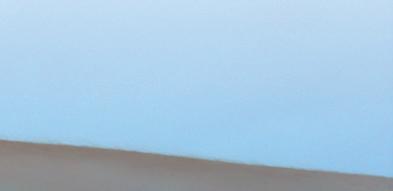
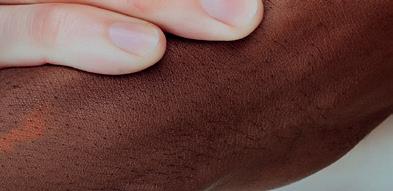









• Introduction: Candidates need to indicate to what extent the collapse of the Soviet Union in 1989 contributed to the political changes that occurred in South Africa.
ELABORATION




• Disintegration of the Soviet Union by the end of 1989 (Glasnost and Perestroika)
• The fall of the Berlin Wall and its impact
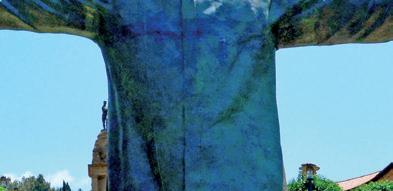
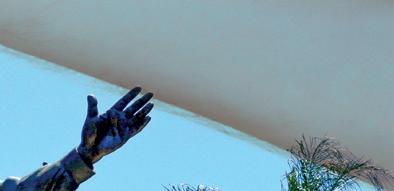

• Communism was no longer regarded as a global threat
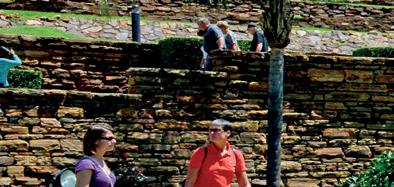
• Changes in the Soviet Union contributed to the end of apartheid
• The collapse of the Soviet Union had a political impact on both the ANC and National Party
• The ANC could not depend on the USSR to support it economically or militarily any more
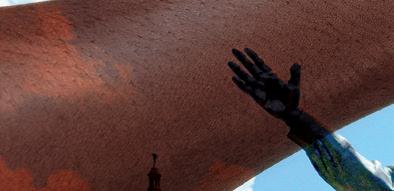

• Gorbachev was also in favour of a peaceful transition of power in South Africa
• The disintegration of the Soviet Union meant that the National Party government had to change its views regarding the African National Congress
• The fall of communism and the Battle at Cuito Cuanavale had a major impact on the South African government's stance not to 'talk to communists'
• The South African government decided to withdraw from Angola and negotiate a settlement over Namibia
• The peaceful transfer of majority rule in Namibia encouraged both the ANC and South African government to talk
• The National Party's claim that it was acting as a 'bulwark' against communist expansion in Southern Africa became unrealistic
• Western world powers supported the move that South Africa resolved its problems peacefully and democratically
• It became clear that the National Party could no longer maintain white supremacy rule in South Africa anymore
• Influential National Party members started to realise that apartheid was not the answer to the needs of white capitalist development
• There was no doubt that the continued repression of black South Africans would not ensure political stability
• PW Botha suffered a stroke and was succeeded by FW de Klerk
• FW de Klerk started to accept that the black South African struggle against apartheid was not a conspiracy directed from Moscow
• On 2 February 1990 De Klerk announced 'a new and just constitutional dispensation'

• This enabled De Klerk to engage in discussions with the liberation organisations

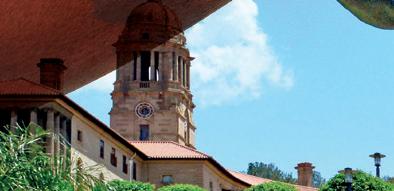


• The release of Nelson Mandela on 11 February and its impact




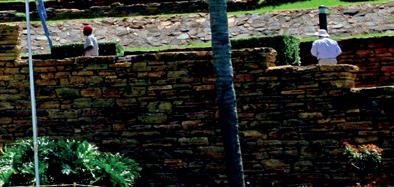

• Any other relevant response
• Conclusion: Candidates should tie up their argument with a relevant conclusion [50]

150
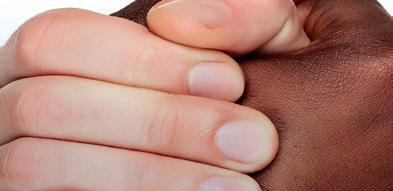 The official papers in this supplement have been published with the endorsement of the Department of Basic Education. For more Matric Questions and Memoranda go to https://www.education.gov.za/
The official papers in this supplement have been published with the endorsement of the Department of Basic Education. For more Matric Questions and Memoranda go to https://www.education.gov.za/
54
TOTAL:
Congress



















55
The
official
papers
in this
supplement have been published with the endorsement of the Department of Basic Education. For more Matric Questions and Memoranda go to https://www.education.gov.za/
A PROUD BRAND OF
Matric Q&A







































 The official papers
The official papers
in this
supplement have been published with the endorsement of the Department of Basic Education. For more Matric Questions and Memoranda go to https://www.education.gov.za/
56 HISTORY























































































































 By Leival Brandon Richards
By Leival Brandon Richards


































































































































































































































































































































































 The official papers in this supplement have been published with the endorsement of the Department of Basic Education. For more Matric Questions and Memoranda go to https://www.education.gov.za/
The official papers in this supplement have been published with the endorsement of the Department of Basic Education. For more Matric Questions and Memoranda go to https://www.education.gov.za/

























